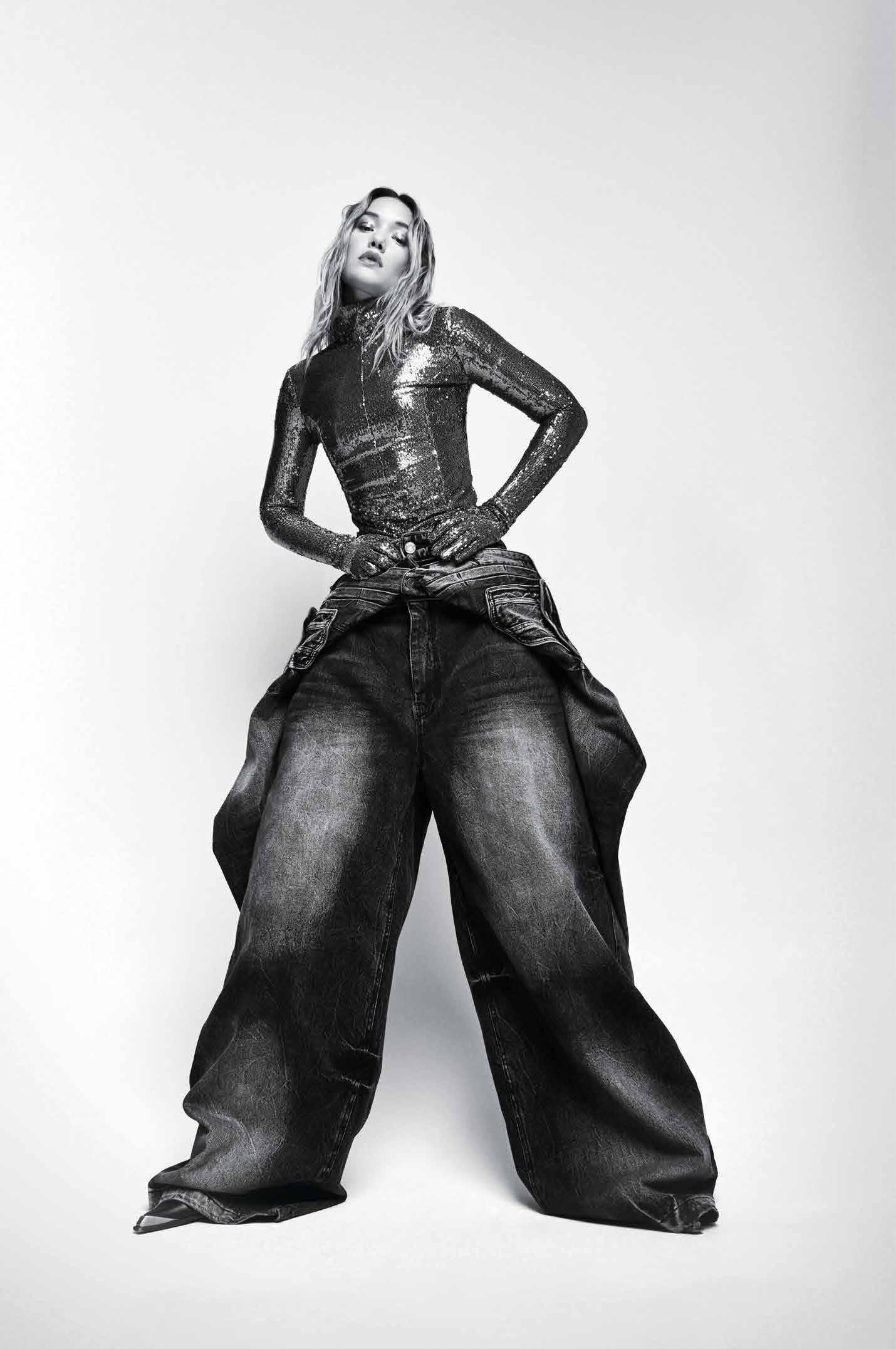
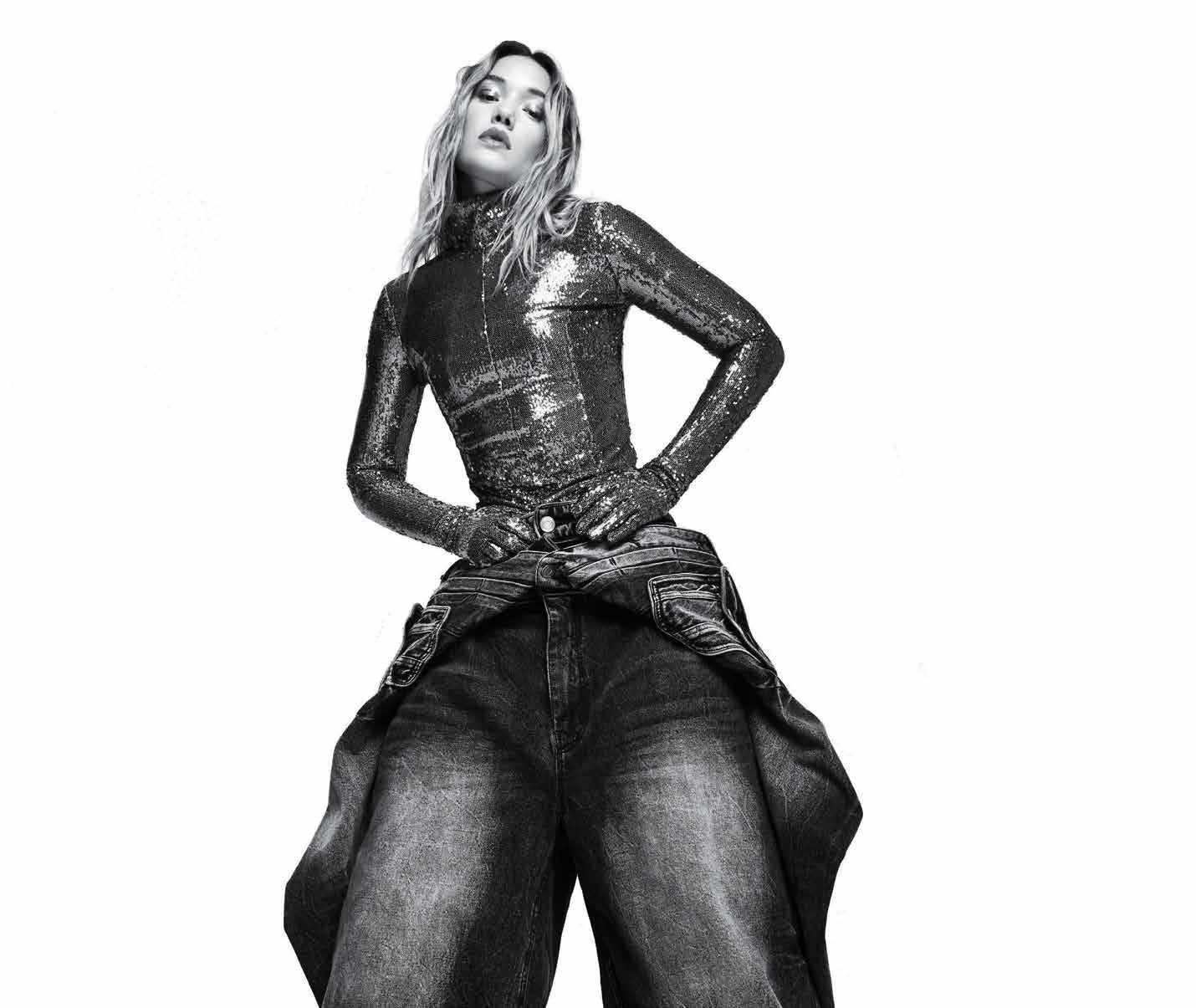
SOURCING JOURNAL • WWD NUMBER 23 • SPRING 24 WESTERN REVIVAL • NEXT GEN INDIGO • FESTIVAL ESSENTIALS
OLIVIA OFFLINE HOW MODEL AND TIKTOK STAR OLIVIA PONTON SEIZED HER POWER


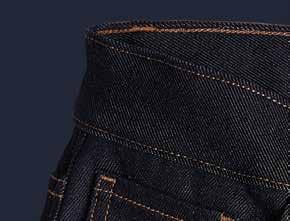




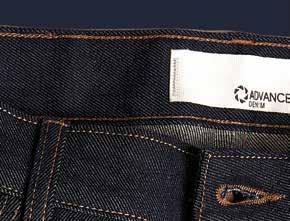
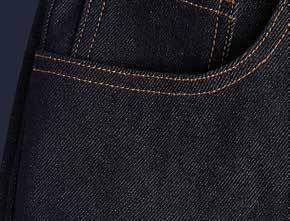

























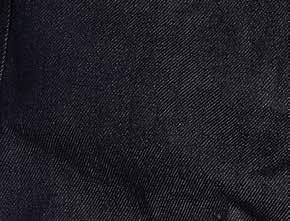

this would be the non bleed
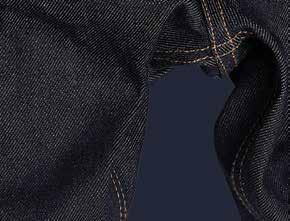

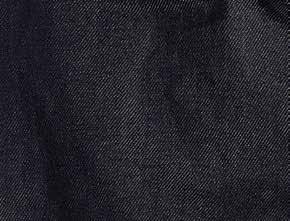





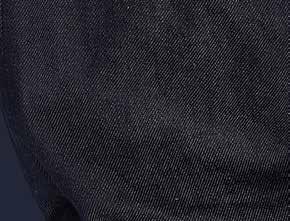





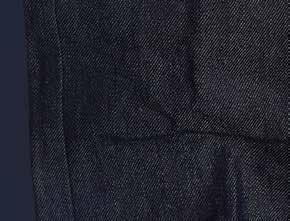








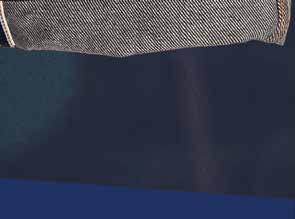
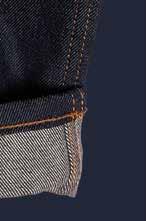

















the 20.5” x 14.45” bleed spread






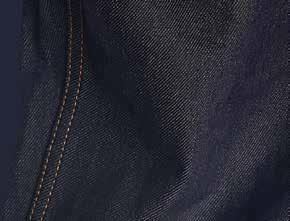


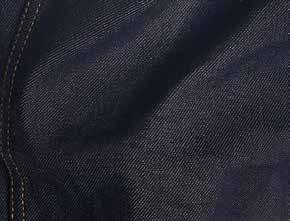
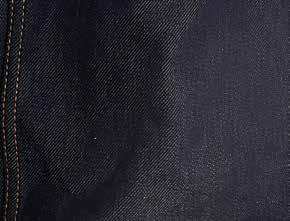




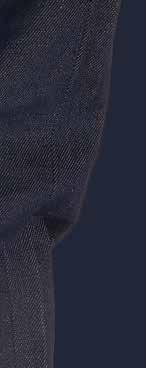
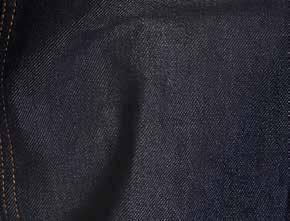





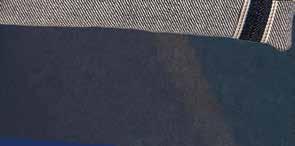
















festival season is underway and I’m happy to say Rivet is being distributed to attendees at Coachella and Stagecoach in Indio, Calif. for the first time.
Driven by youth culture, celebrity and music, the connection between denim fashion and festivals has always been one of the most exciting and fun spaces to watch. I can’t wait to see what the 2024 festival season brings.
From what seemed like a slow rebuild after the pandemic, festivals are back with a vengeance.
I’ve experienced my first two festivals ever this year— Mardi Gras in New Orleans and South by Southwest (SXSW) in Austin, Texas. That is if you don’t count the Plant City, Fla. Strawberry Festival I attended with my grandparents in the ’90s.
On paper, Mardi Gras and SXSW could not be any more different. One is a celebration of excess and debauchery; the other is a high-brow mash-up of media and culture. However, on closer inspection, both center on unending music, unlimited alcohol, free stuff being tossed at you (literally and figuratively) and the chance to joyfully geek out about whatever niche interest you have.
I presume that’s why festivals are so popular. They’re opportunities to proudly let your freak flag fly. Denim heads do this every time they’re in a room together. They even made a movie about it. (See “Search Party” pg. 10.) I hope that this issue gives them plenty of conversation starters to stir up new discussions. There’s a lot of newness to unpack from Western’s revival and its impact on authentic cowboy brands (“Western Way” pg. 23) to the power of TikTok influencers like our cover star Olivia Ponton (“Dream Chaser” pg. 28).
At just 21 years old, the SI swimsuit model with 7.7 million TikTok followers is charming high-end designers—and our staff—with her positive attitude and pure joy for fashion.
02 • RIVET MASTHEAD EDITOR'S LETTER
JOY RIDE ANGELA JEAN VELASQUEZ avelasquez@sourcingjournal.com EDITORIAL Peter Sadera Editor in Chief, Sourcing Journal Angela Velasquez Executive Editor, Rivet Alex Badia Style Director, WWD Vicki M. Young Executive Financial Reporter Jasmin Malik Chua Sourcing & Labor Editor Kate Nishimura Senior News & Features Editor Leigh Nordstrom Eye Editor, WWD Luis Campuzano Senior Market Editor, Men’s, WWD Emily Mercer Women's Market Editor, WWD Thomas Waller Senior Fashion Market Editor, Accessories, WWD Ryan Williams Associate Photo Editor, WWD Glenn Taylor Business Editor Meghan Hall Business Editor Alex Harrell Staff Writer Lauren Parker Director, SJ Studio Sarah Jones Senior Editor, Strategic Content Development Andre Claudio Staff Writer, Strategic Content ART DEPARTMENT Ken DeLago Art Director Logan Case Senior Designer Erik Pak Senior Designer Trinity Krakora Designer SOURCING JOURNAL ADVERTISING Rebecca Goldberg VP, Strategy & Business Development Eric Hertzman Senior Director, Sales & Marketing Deborah B. Baron Advertising Director Allix Cowan Manager, Audience Development Darren Dort Media Coordinator PROD UC TION Anne Leonard Production Manager Adeline Saez Production Manager Therese Hurter PreMedia Specialist FAIRCHILD MEDIA GROUP Amanda Smith President Michael Atmore Chief Brand Officer James Fallon Editorial Director ADVERTISING Hillari Lazzara Senior Vice President, Sales Samantha Rumsky Advertising Director Deborah Baron Advertising Director Jennifer Petersen Advertising Director, Fashion & Luxury Amy Macauley West Coast Director Amanda Boyle Beauty Director Alyssa Cohen Account Director, Finance & Tech Katherine Hogan Account Manager, Tech MARKETING William Gasperoni Vice President Caroline Daddario Executive Director, Head of Programming Christine Staley Senior Director, Marketing & Fairchild Studio Alice Song Senior Manager, Programming and Special Projects Lauren Pyo Senior Manager, Marketing Sienna Eisenhart Associate Manager, Marketing OPERATIONS Ashley Faradineh Director, Operations Alaina Randazzo Digital Sales Planner Emanuela Altimani Senior Sales Coordinator Jay Penske Chairman & CEO Gerry Byrne Vice Chairman George Grobar Chief Operating Officer Sarlina See Chief Accounting Officer Craig Perreault Chief Digital Officer Todd Greene EVP, Business Affairs & Chief Legal Officer Celine Perrot-Johnson EVP, Operations & Finance Paul Rainey EVP, Operations & Finance Tom Finn EVP, Operations & Finance Jenny Connelly EVP, Product & Engineering Ken DelAlcazar EVP, Finance Debashish Ghosh Managing Director, International Markets Dan Owen EVP, GM of Strategic Industry Group Brian Levine Senior Vice President, Revenue Operations Brooke Jaffe Senior Vice President, Public Affairs & Strategy David Roberson Senior Vice President, Subscriptions Doug Bandes Senior Vice President, Partnerships PMC Live Frank McCallick Senior Vice President, Global Tax Gabriel Koen Senior Vice President, Technology Jessica Kadden Senior Vice President, Programmatic Sales Judith R. Margolin Senior Vice President, Deputy General Counsel Ken DelAlcazar Senior Vice President, Finance Lauren Utecht Senior Vice President, Human Resources Marissa O’Hare Senior Vice President, Business Development Nelson Anderson Senior Vice President, Creative Nici Catton Senior Vice President, Product Delivery Adrian White Vice President, Associate General Counsel Andrew Root Vice President, Digital Marketing Andy Limpus Vice President, Executive Search & Head of Talent Acquisition Anne Doyle Vice President, Human Resources Ashley Snyder Vice President, Associate General Counsel Brian Vrabel Head of Industry, CPG and Health Constance Ejuma Vice President, SEO Courtney Goldstein Vice President, Human Resources Dan Feinberg Vice President, Associate General Counsel Denise Tooman Vice President, Marketing, Strategic Solutions Group Eddie Ko Vice President, Advertising Operations Greta Shafrazian VVice President, Business Intelligence Jamie Miles Vice President, eCommerce James Kiernan Head of Industry, Agency Development Jennifer Garber Head of Industry, Travel Jerry Ruiz Vice President, Acquisitions & Operations Joni Antonacci Vice President, Production Operations Karen Reed Vice President, Finance Karl Walter Vice President, Content Katrina Barlow Vice President, Business Development Kay Swift Vice President, Information Technology Keir McMullen Vice President, Human Resources Matthew Cline Head of Automotive Industry Mike Ye Vice President, Strategic Planning & Acquisitions RIVET IS OWNED AND PUBLISHED BY PENSKE MEDIA CORPORATION PENSKE MEDIA CORPORATION ▲ Jeans for sale at Woodstock in 1969. PHOTO: WARNER BROS/MICHAEL OCHS ARCHIVES/GETTY IMAGES
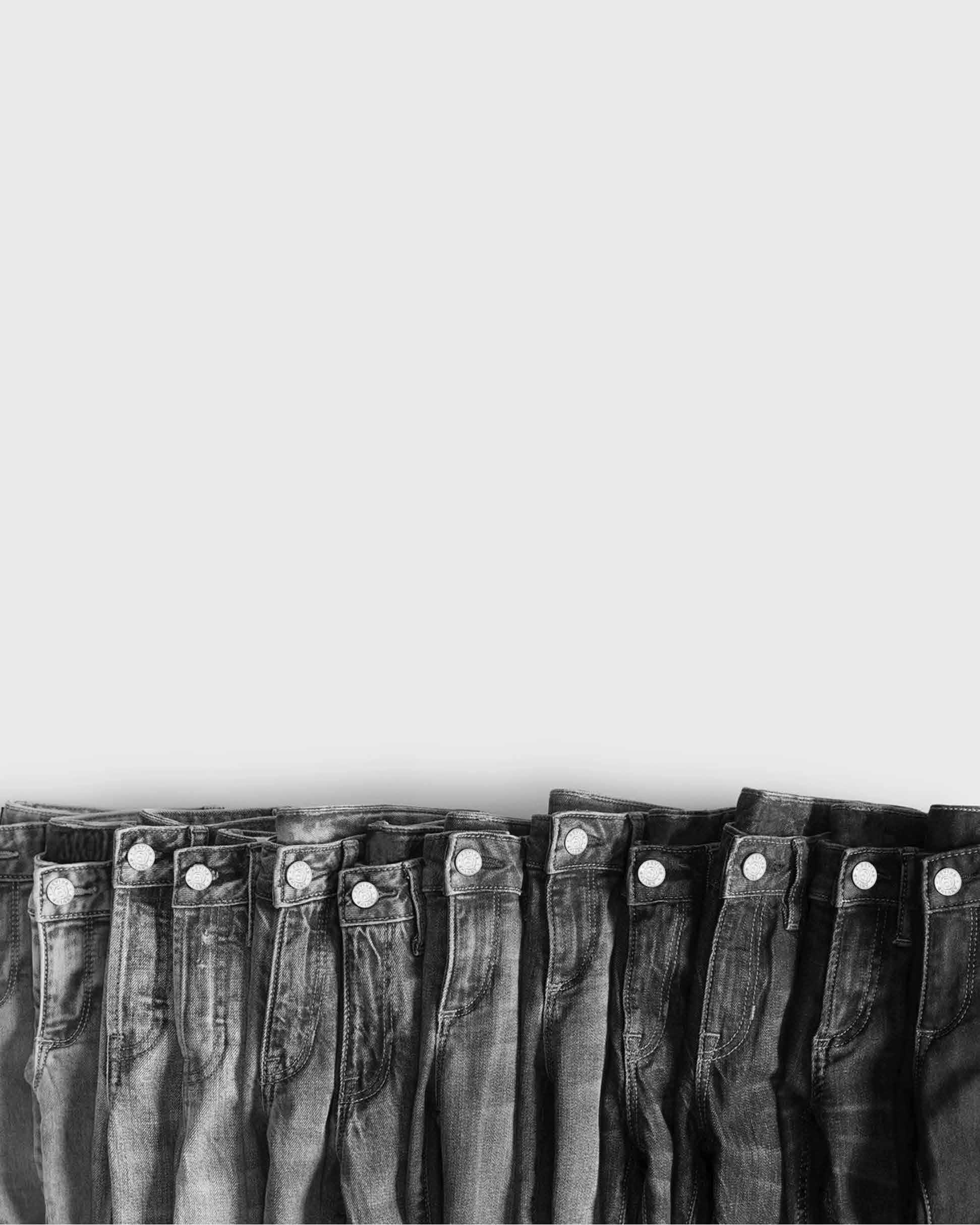
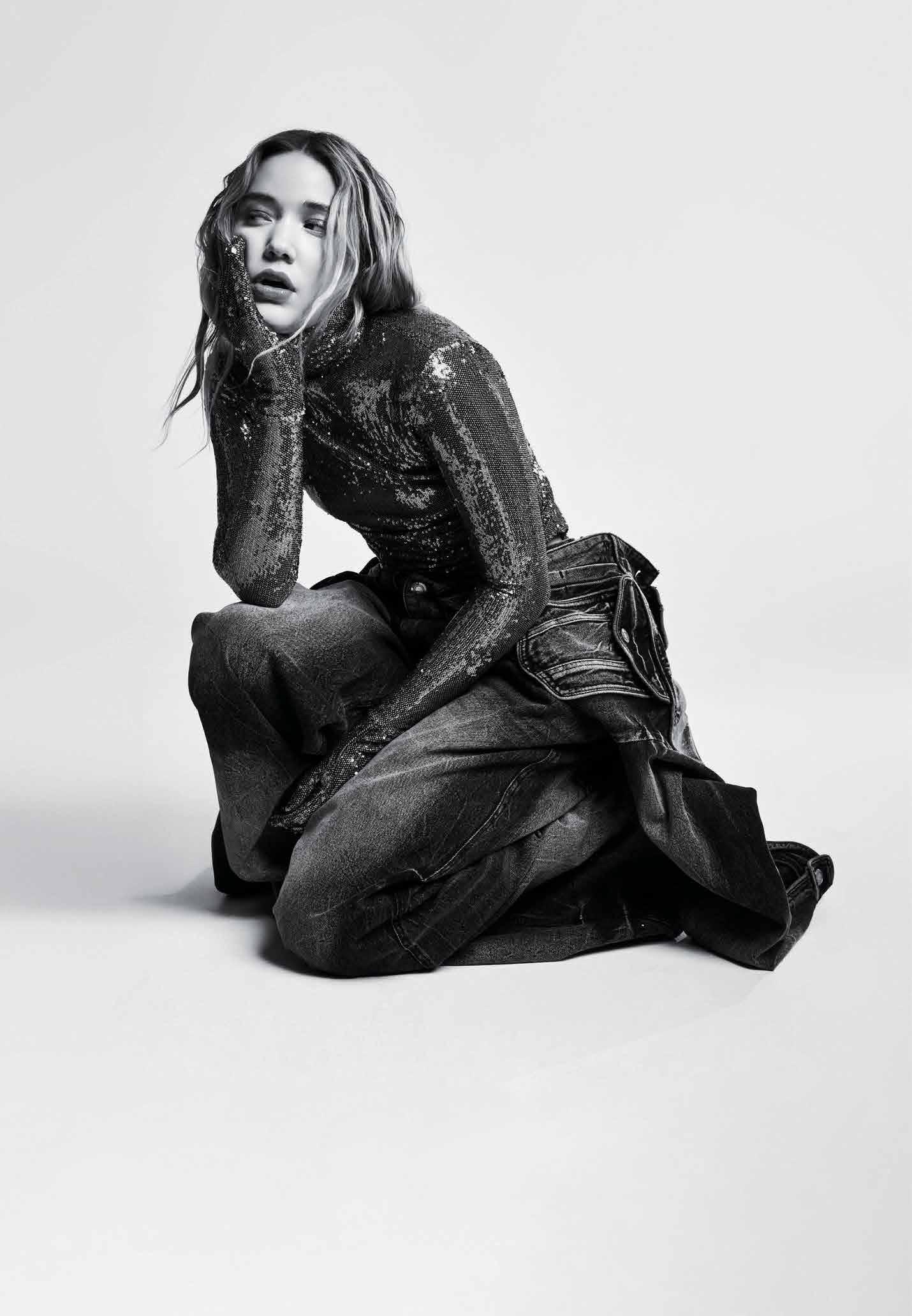
04 • RIVET CONTENTS OLIVIA PONTON • BY THE NUMBERS 3 M FOLLOWERS ON INSTAGRAM 7. 7 M FOLLOWERS ON TIKTOK COVER + THIS PAGE: JUUN.J SEQUIN BODYSUIT AND DENIM JUMPSUIT; ETRO MULES. PHOTOGRAPH BY EMERALD LAYNE 06 THE PULSE All the essentials for a stylish festival wardrobe. 09 THE ZEITGEIST The summer's biggest films, tours and festivals. 12 THE RIVETING LIST The latest collections from top denim brands. 14 SOCIAL WORLD How to pull off a successful influencer trip. 20 RIVETING RETAIL Inside Imogene + Willie's Austin, Texas boutique. 23 WESTERN WAY What's next for Western fashion's revival? 28 DREAM CHASER TikTok star and model Olivia Ponton brings thiis season's boldest denim trends to life. 38 MUSIC NOTES Designers on the deep connection between musicians and denim. 42 FROM THE RUNWAY Skirts, gray denim and embellishments lead F/W 24-25 runway trends. 44 CULT PHENOM Ron Poisson shares how denim-rooted Cult of Individuality stays close to the culture. 48 ABOVE & BEYOND Steven Bethell, founder of Bank & Vogue and Beyond Retro, on the future of resale. 54 TO DYE FOR Biotechnology firms invest in bio-based alternatives to petroleumbased dyes. 58 NOBLE CRAFT Demand and prices for linen denim are growing. 62 SWEET IDEA Cotton Incorporated’s circular vision includes recycling cotton into glucose. 70 AMSTERDAM AWAITS Jeans School students share their favorite spots in the denimfriendly city. 74 STATUS SYMBOL Calvin Klein introduced the first “status jean” half a century ago.
BY SOORT Y
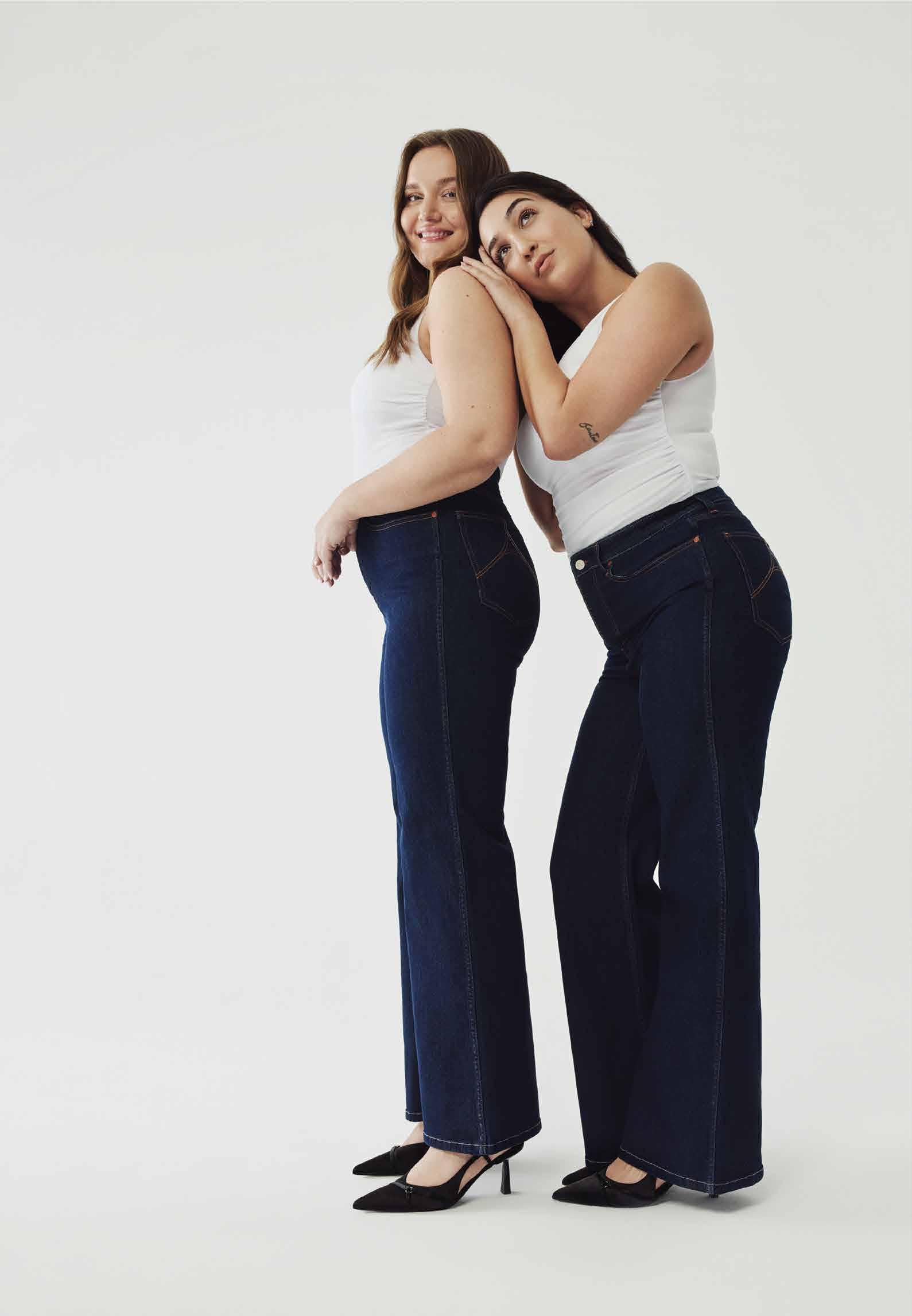
Soorty, leveraging its expertise in fabric and finishing co-development, is proud to launch ShapeSync scaling up the patented LYCRA ® FitSense TM Denim technology and making it accessible to women worldwide.
Born from real consumer needs and desires, ShapeSync offers the world’s first targeted shaping solution, embracing every curve and catering to all sizes, shapes, and body types.
Ultra-flattering denim that delivers the closest to a customized fit experience. Designed to speak to you, to uplift you, and to celebrate you.
soorty.com @soortyenterprises
C Y CM CMY K set-up ShapeSync ad copy.pdf 1 27/03/2024 11:37
COACHELLA
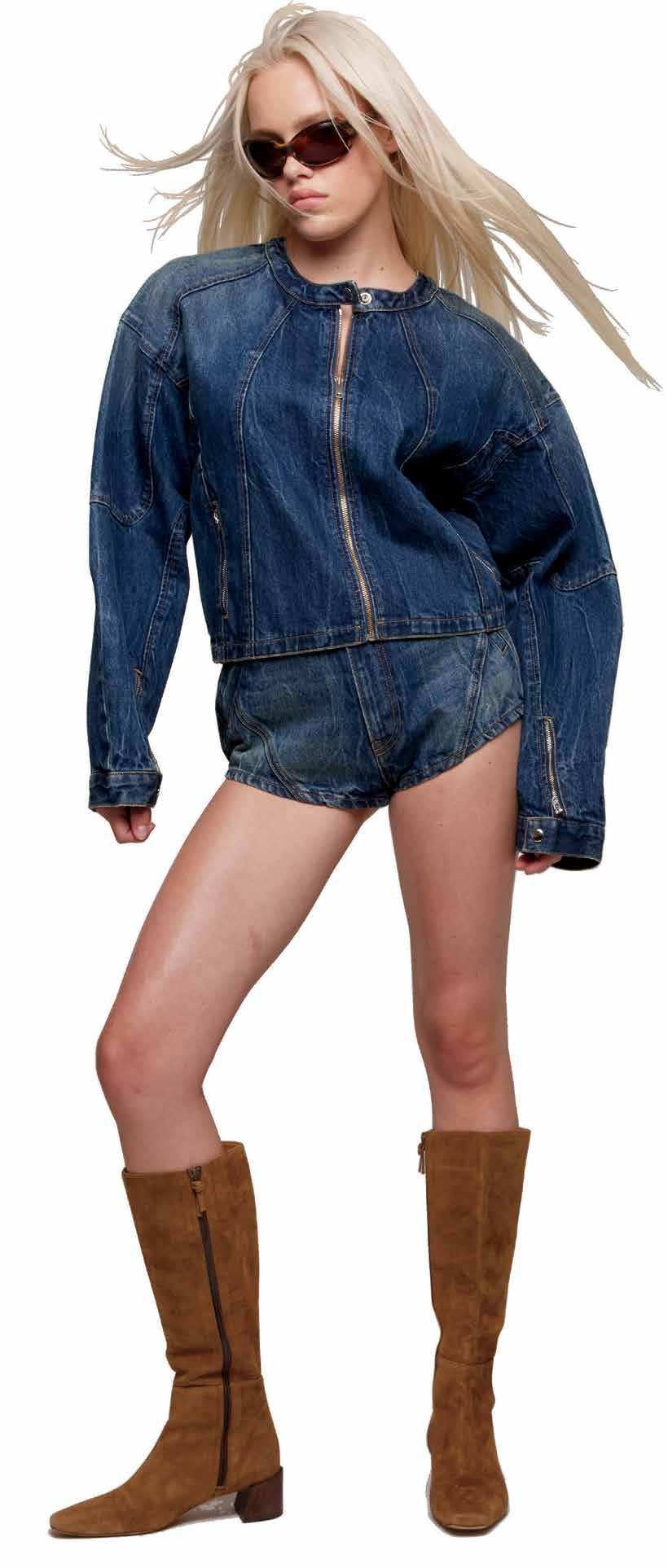
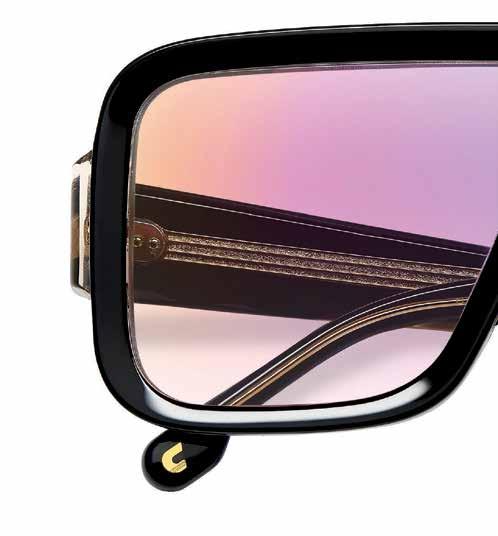
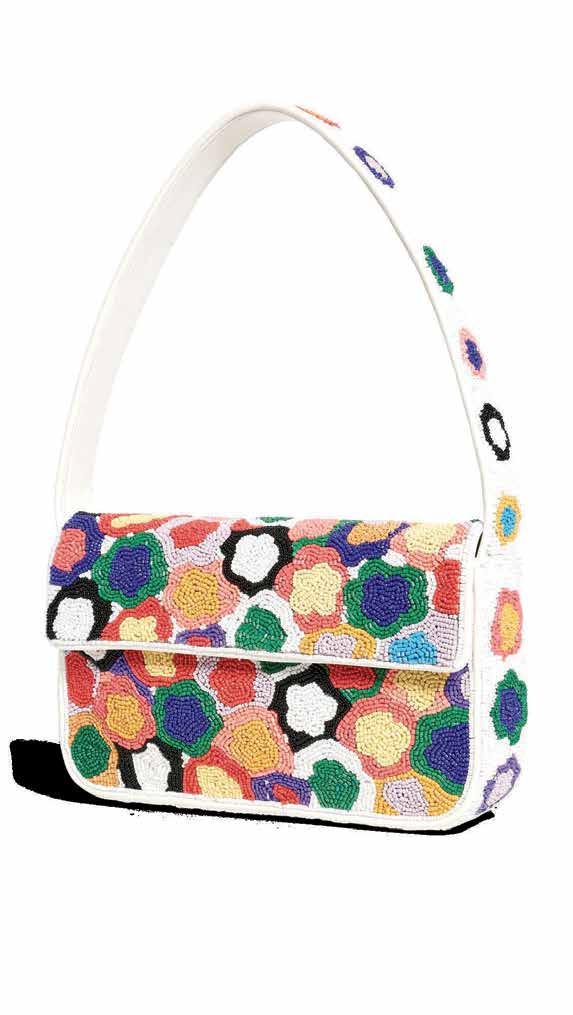


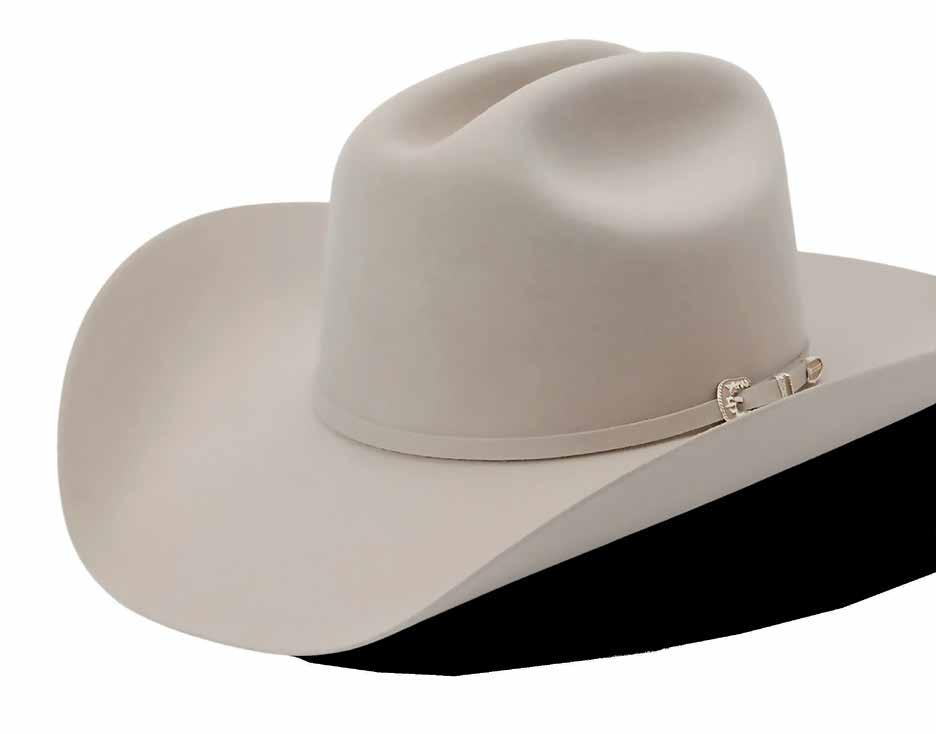
06 • RIVET THE PULSE
▲ STETSON HAT ▲ DIESEL CLOGS
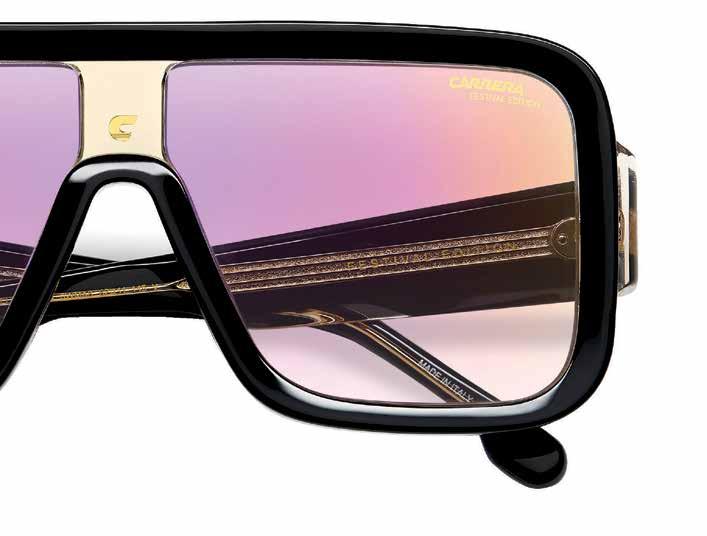
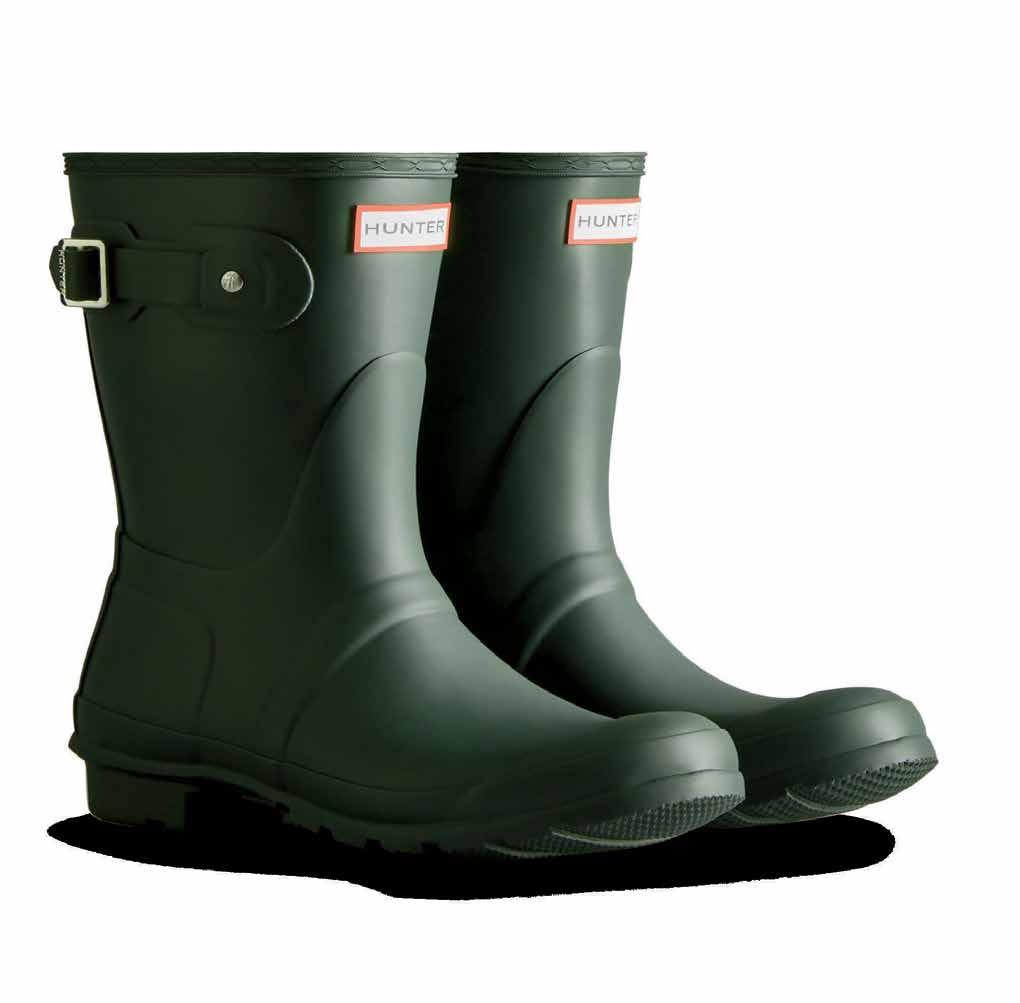

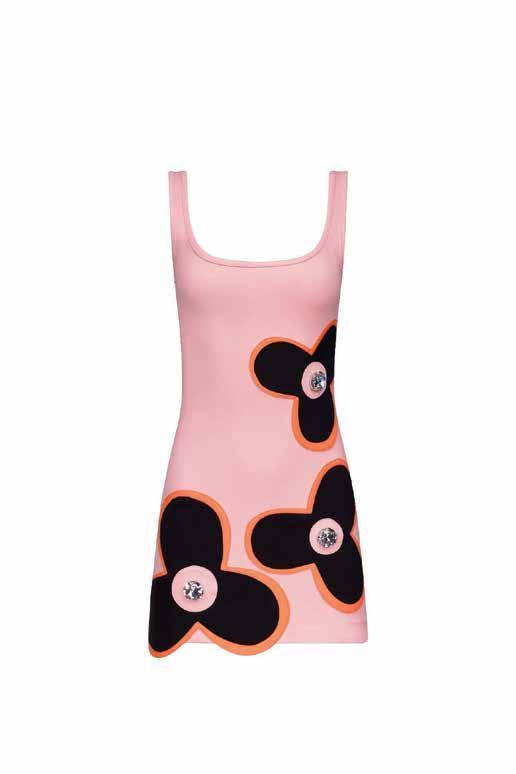

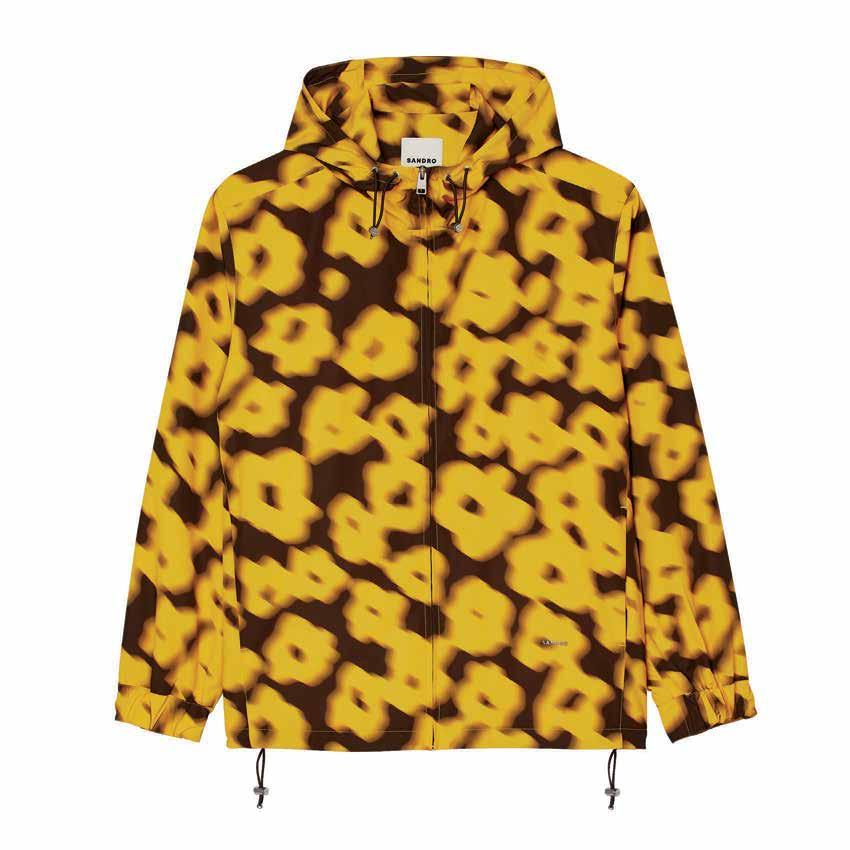

RIVET 07 OR BUST! Festival essentials that pack a punch. by WWD Staff ▲ SANDRO JACKET ▲ CARRERA "FESTIVAL" SUNGLASSES ▲ HUNTER BOOTS ◄ URBAN OUTFITTERS T-SHIRT & SHORTS
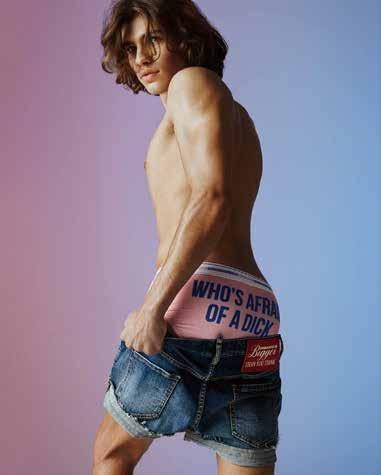
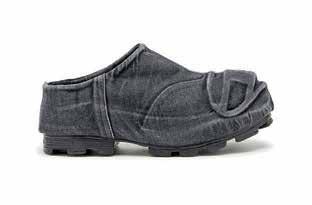
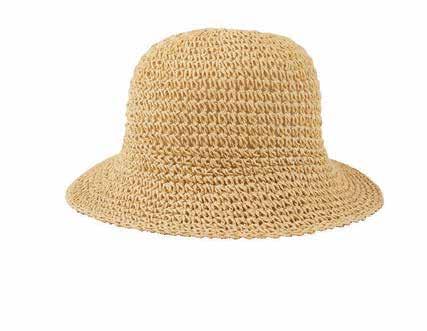
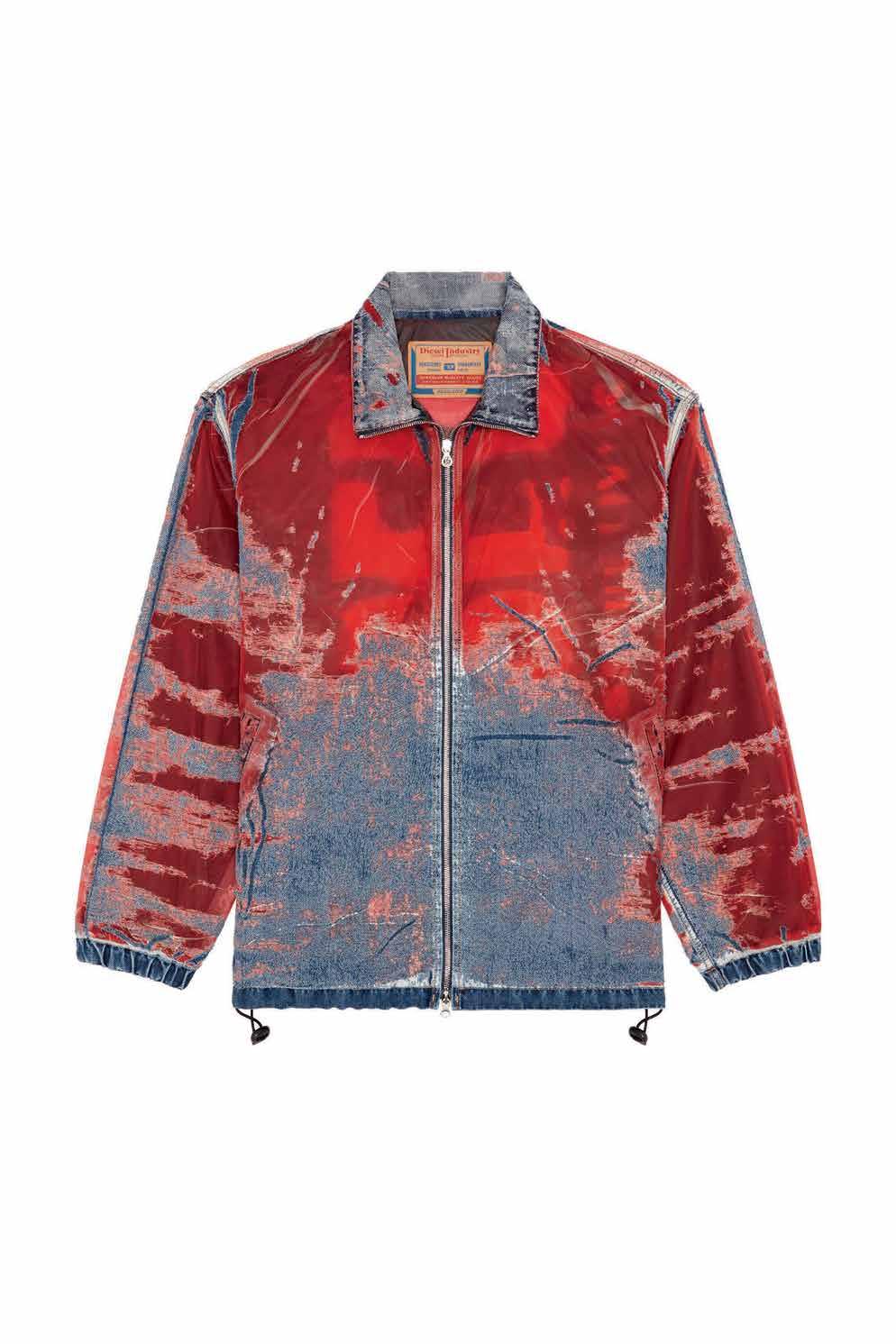

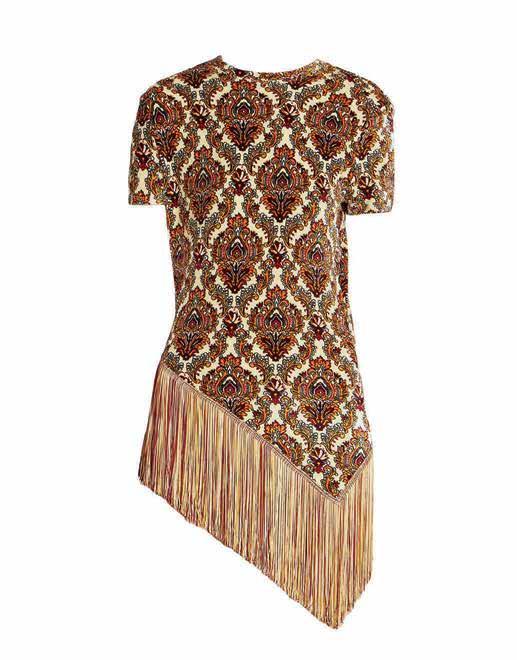

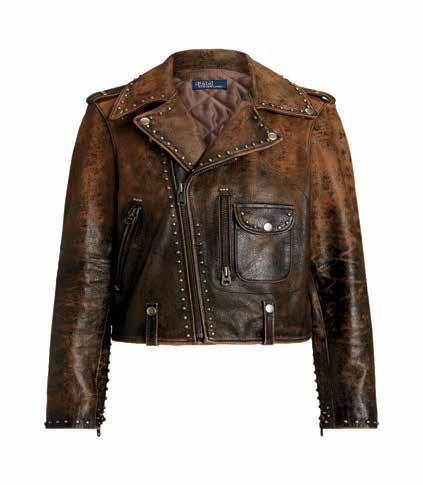

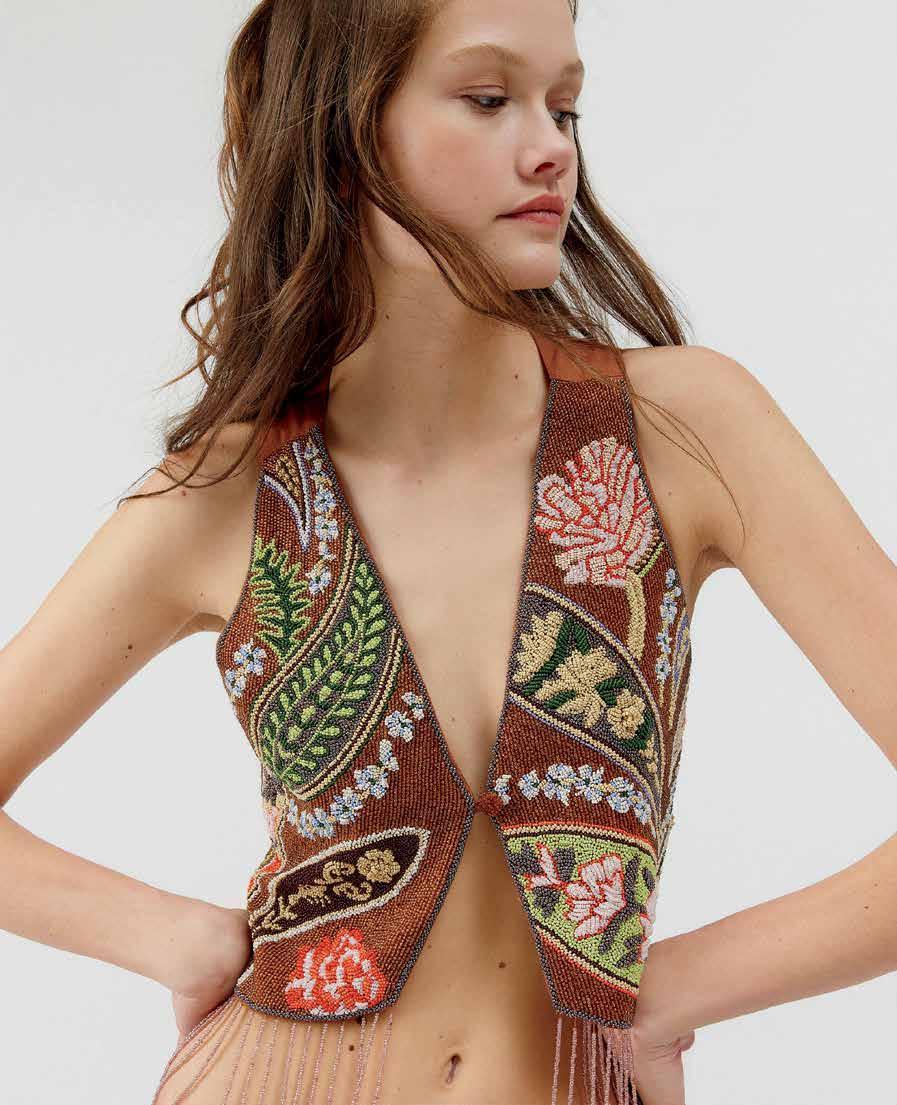
08 • RIVET PHOTOS: COURTESY THE PULSE ▲ ROCCO SIFFREDI X DSQUARED2 BRIEF & SHORTS DIESEL JACKET ▲ POLO RALPH LAUREN JACKET ◄ AGUA BENDUTA VEST (AVAILABLE AT URBAN OUTFITTERS) ▲ URBAN OUTFITTERS TOP RABANNE DRESS ▼ ▲ SANDRO HAT ▲ DIESEL CLOG PITUSA PANTS ▼
THE ZEITGEIST
The tours, films and festivals you need to know.

ON TOUR
Olivia Rodrigo’s “Guts World Tour” has already crisscrossed part of the U.S., allowing fans to scream out their teenage angst in sold-out arenas. The “Vampire” pop star travels across the Atlantic this month for the European leg, kicking off on April 30 in Dublin and ending in Lisbon on June 23. U.S. fans will have another chance to see the show when it resumes in July with stops in Philadelphia, Washington D.C., Atlanta and more. It will conclude with four nights at the Kia Forum in L.A. Aug. 13-17.
—Angela Velasquez
Bianca Del Rio, winner of RuPaul’s Drag Race Season 6, is on the road again for her tour titled “Dead Inside.” “The main purpose for this tour is to discuss what life is like as an aging drag queen…and what it’s done to my life, body and views. You’ll also understand why I’m this cryptic, insane bitch that you see standing before you,” Del Rio told Rivet. The 60-date run kicked off Feb. 12 in San Diego, continuing with shows in Los Angeles, New Orleans and more. While the tour is currently
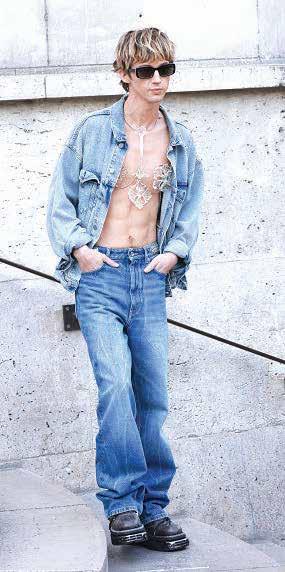
ON THE SCREEN
CHALLENGERS
Challengers” is making a grand slam in the entertainment industry.
The star-studded movie follows the story of tennis pro Tashi (Zendaya), who finds herself embroiled in a high stakes love triangle with fellow tennis stars Art (Mike Faist) and Patrick (Josh O'Connor).
The film will hit theaters
April 26. —AC

BACK TO BLACK
Amy Winehouse’s biopic “Back to Black” hits the big screen on May 17.
Starring British actress Marisa Abela as the late singer-songwriter, the
film provides a “neverbefore-seen glimpse” into Winehouse’s rise to fame and the tumultuous relationship at the center of her legendary album.—AC
OMG FASHUN
Fashion rule-breaker
Julia Fox is set to host and produce E!’s new competition show, “OMG Fashun” premiering on May 6. The series will challenge fashion disrupters to design unconventional and sustainable looks. —AC
set to end May 6 in Palm Desert, Calif., the drag superstar already has plans to extend globally.
—Andre Claudio
Many more global economies can look forward to Taylor Swift coming to their cities. The superstar brings “The Eras Tour”

to stadiums in the U.K., France, Spain, Italy and more this summer through August before coming back to the U.S. in the fall for multi-night stints in Miami, New Orleans and Indianapolis. The colossal tour wraps up on Dec. 6-8 in Vancouver.—AV
Troye Sivan will have Europe feeling the rush next month. The recent Prada campaign star and fragrance and homeware entrepreneur is gearing up for the “Something to Give Each Other” tour, his biggest European headline tour to date. The 17-date run will kick off in Portugal on May 29 at Lisbon’s Coliseu dos Recreios, continuing with shows and festivals in Spain, Sweden, Denmark, Czech Republic, Germany, Switzerland, Netherlands, Scotland and Ireland before wrapping in the United Kingdom on June 28.
The tour supports his chart-topping album of the same name. Since its release last October, the 10-track album has surpassed 650 million album streams. Meanwhile the sweaty video for his Grammy Award-nominated single “Rush” has garnered 29 million views.—AC

FESTIVAL FEVER
LOVER & FRIENDS
On May 4, some of the biggest names in R&B and pop will hit the stage in Sin City for the Lovers & Friends at the Las Vegas Festival Grounds. Janet Jackson, Alicia Keys, Mary J. Blige are among the headliners as well as Usher who will celebrate the 20th anniversary of his Grammy Award-winning album “Confessions” by performing it in its entirety. The nostalgic lineup also includes Snoop Dogg, Backstreet Boys, Nelly Furtado, Gwen Stefani and more.—AC
GOV BALL Now in its 14th year, Gov Ball is set to return to the historic Flushing Meadows Corona Park in Queens from June 7-9 with a diverse lineup.
Headliners include Post Malone, Rauw Alejandro, The Killers, 21 Savage, SZA and Peso Pluma. Victoria Monét, Dominic Fike, Sabrina Carpenter and Carly Rae Jepsen will also hit the stage. —AC

BONNARO
Some of music’s biggest acts will take over Manchester, Tenn. for Bonnaro June 13-16. Post Malone, The Red Hot Chili Peppers, Fred Again, Pretty Lights and Meghan Thee Stallion are on the lineup. Offstage, festival-goers can enjoy a village market, cool off at The Foundation—one of Bonnaroo’s icons—or dress up for one of the many parades that take place during the four event.—AV
RIVET 09 OLIVIA RODRIGO: KEVIN MAZUR/GETTY FOR ACRISURE ARENA; TROYE SIVAN: ARNOLD JEROCKI/GETTY; BLANCA DEL RIO: COURTESY; "BACK TO BLACK": EVERETT COLLECTION; POST MALONE: TIM MOSENFELDER/GETTY; USHER: GABE GINSBERG/GETTY
(Above) Post Malone will take the stage at Gov Ball and Bonnaro. (Below) Usher brings nostalgic acts and albums to Las Vegas.
Marisa Abela plays Amy Winehouse in "Back to Black."
(Above) Olivia Rodrigo and Troye Sivan bring their bops to the masses. (Below) Blanca Del Rio gets real on tour.

SEARCH PARTY
In the opening scenes of the documentary “Denim Hunter,” Viktor Fredbäck trudges across the scorched landscape of California’s Death Valley. He pauses to take a drink from his canteen, the water pouring onto his parched lips, before he collapses to the ground, covering his face with a worn hat.
That beginning may feel dramatic for a film about searching for vintage jeans, but the lengths Fredbäck and his fellow “denim hunters” go to in a quest to procure their apparel holy grail fit the sweeping scene.
The idea for “Denim Hunter” came when
Swedish filmmaker Emilio Di Stefano read a story about Fredbäck’s trip to the U.S. to search for discarded jeans in abandoned mines. “I just thought that sounded weird,” Di Stefano said. “So I contacted Viktor on Facebook after I read it in the paper, and the next morning we met in Stockholm.”
Di Stefano had been mulling the idea of shooting an adventure documentary with a niche angle, and after meeting Fredbäck and hearing his story, he thought the search for rare denim fit the bill. A few months later, he and Fredbäck set off for the U.S. on a research trip.

BIRTH OF AN OBSESSION
Fredbäck hasn’t always been interested in vintage denim. But nearly two decades ago, he lived with a roommate whose brother worked in the industry in Sweden. Fredbäck became interested in his friend’s work and soon acquired a taste for vintage jeans. At the time, he couldn’t afford much—vintage denim can run up into the hundreds of thousands of dollars for exceptionally rare pieces—but he slowly began to amass a small collection, mostly of scraps and a small denim doll from the 1920s.
Fredbäck began trolling eBay for hidden denim gems. One day, he stumbled on a pair from the 1800s that piqued his interest enough to reach out to the seller for more information.
“I asked the guy who sold it, ‘What is this? Could you tell me about it?’” Fredbäck said. “And we went back and forth until he told me, ‘I’m digging for jeans in the desert.’ I asked him to tell me more, and he invited me to come along on one of his trips. That’s what got me started in this world.”
Many of the jeans unearthed were left by miners in the American West during the late 1800s and early 1900s. The hardwearing riveted
and walk in. You park and then do a couple of hours of hiking.”
Sometimes the effort pays off. Inside the mine with Harris and Miller, Fredbäck dug around in a pile of rubble and struck pay dirt—an ancient pair of mostly intact jeans with the original tag bearing the words “Good Luck.”
After a few joyous moments of celebration, Fredbäck’s elation deflates when Harris informs him that he will keep the pants because Fredbäck is merely tagging along on his expedition.
That disappointment— not to mention a fiancée, a baby and an impending wedding back in Sweden—don’t deter Fredbäck from his goal. The documentary
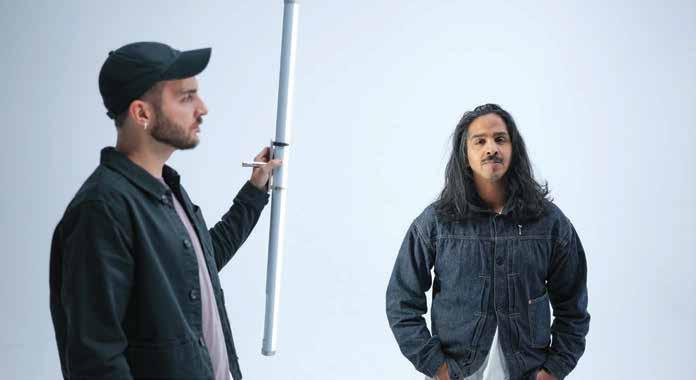
pants were a uniform of sorts for the workers. “The miner didn’t own the pants, so when they closed down a mine, the miners left whatever wasn’t theirs,” he said. More than 400 pairs later, Fredbäck has built a collection that ranges from A.B. Alfeldt Champion overalls from the 1870s to flare jeans from the 1970s, with a style representing every decade other than the 1880s. Finding this missing link in his collection became an obsession for Fredbäck
STRIKING GOLD
After that first trip, Fredbäck partnered with two other veteran denim hunters—Michael Allen Harris and Russ Miller—who make appearances early in the documentary. Fredbäck accompanies them to search an abandoned mine, where they comb the mineshaft looking
for clues that might lead them to discarded denim, noting nooks and crevices where rotting timbers hold up the walls and ceiling where miners could have shoved discarded pants or jackets.
While pointing out one precariously splintered support post after another, the level of danger in this pursuit becomes abundantly clear. “They want to go into mines nobody has been into, and that’s the dangerous part,” Fredbäck said. “You sometimes have to dig to get into them or climb down a vertical shaft.”
Often, the mines are in desert landscapes, which presents a different set of dangers and challenges. “It’s windy, and it’s really hot,” Fredbäck said. “And it’s not like you can just park your car
follows him as he continues searching for the pair of jeans that will complete his collection, along the way linking up with other denim hunters such as Brit Eaton, who sold a pair of 1873 Levi’s at auction last year for $100,000.
While finding that elusive pair would be sweet, Fredbäck said that wouldn’t end his search. Almost more than the denim itself, the thrill of the hunt drives Fredbäck to such lengths and will keep him on the trail of the next big score for years to come.
“I don’t want to collect anything that could be finished, like stamps or coins,” he said. “The idea of being finished with something is kind of depressing. What would be the purpose of doing it? For me, this could be never-ending.”
“Denim Hunter” is streaming on Amazon Prime, Apple TV and Vimeo. ■
10 • RIVET PHOTOS: COURTESY THE ZEITGEIST
The new documentary “Denim Hunter” takes viewers on a quest for vintage jeans. by Jennifer Bringle
Filmaker Emilio Di Stefano (left) follows Viktor Fredbäck (right) on his quest for jeans.



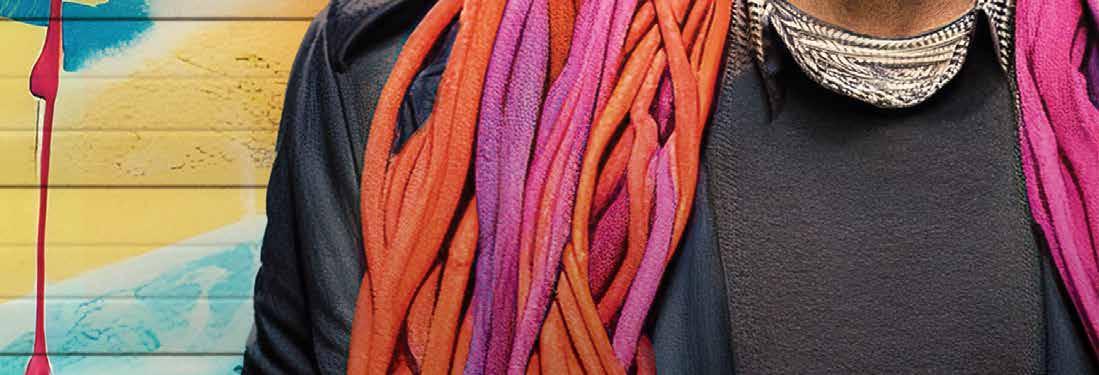

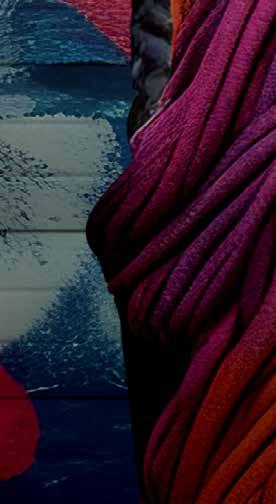
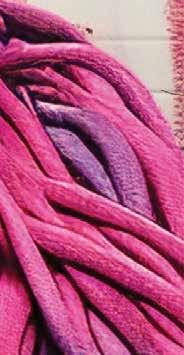
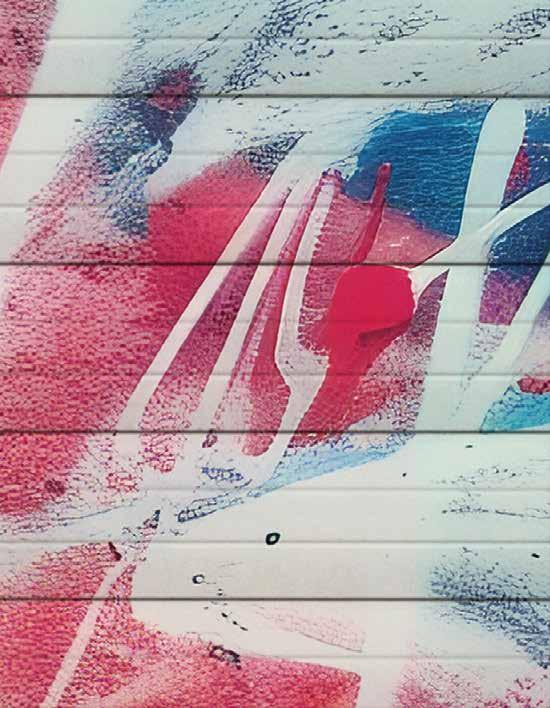

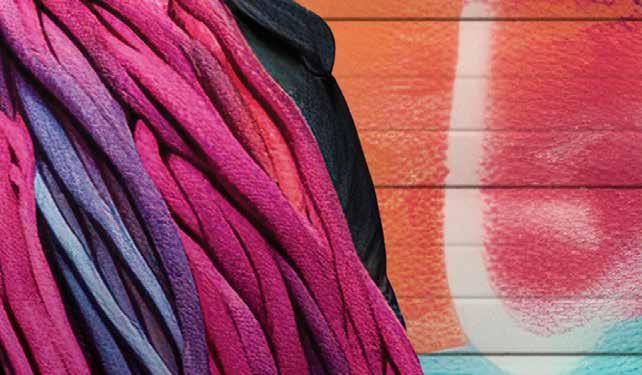



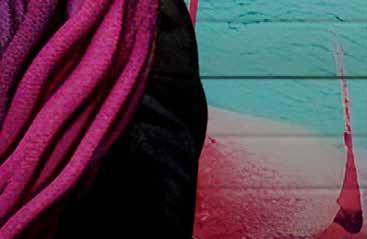
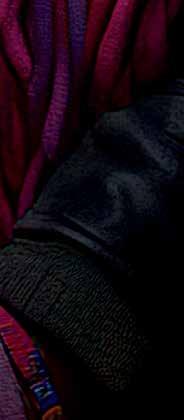
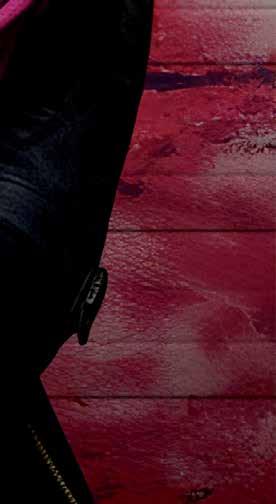
9.7” X 14.45” AD REPLACES THIS BOX cotton can inspire your next creation With fabric inspiration, trend forecasting, and textile education at your fingertips, CottonWorks™ has the resources you need to stay ahead. No fees. Just facts. What will you create? Explore the possibilities at CottonWorks.com AMERICA’S COTTON PRODUCERS AND IMPORTERS. Service Marks/Trademarks of Cotton Incorporated. © 2024 Cotton Incorporated.
THE RIVETING LIST
The latest drops and collections heating up the denim category.
AG JEANS
AG Jeans is reviving one of its most coveted Y2K fits: the Angel bootcut.
Taking inspiration from some of fashion’s greats like Patti Smith and Kate Moss, the Angel came onto the scene in the early 2000s as a bootcut with an ultra-low rise.
The Los Angeles-based brand has updated the style by offering it two lengths, a standard inseam and an extended length for a dramatic puddling hem line. Specific washes will also be available in a raw hem.
“The Angel answers a call from our customer,” said John Rossell, AG’s director of creative and marketing. “We have customers reach out to us constantly asking for the Angel, so we’re excited to be reintroducing it.”
The Angel jeans retail for $210$245 and are available now on AG’s website.
—ANDRE CLAUDIO
LUCKY BRAND
Distressed denim, sun-kissed colors, studded shirts and bohemian dresses are part of Lucky Brand’s Festival Finds collection.
A mix of festival staples and Gen Z favorites, the collection spans women’s Bermuda denim shorts and a denim corset dresses to men’s denim Western shirts and bolo ties. One-of-a-kind upcycled pieces are also part of the assortment.
Repurposed highlights include a women’s cropped jean jacket with a Western-inspired fringe back and cutoff jean shorts with floral silver-tone studs. Upcycled suede and denim fringe jackets are also available for men.
The festival collection is available now on Lucky Brand’s website and retails for $12 for jewelry to $499 for vintage leather and suede jackets.
—ANGELA VELASQUEZ
DL1961
DL1961 opts for simplicity and comfort this spring. One notable piece from the New York-based label’s collection is the Lucila Wide Leg in Flax, an ultra-wide leg that offers a “perfect oversized statement” look, according to Sarah Ahmed, DL1961 founder. “Our denim-focused lineup showcases vintage-inspired
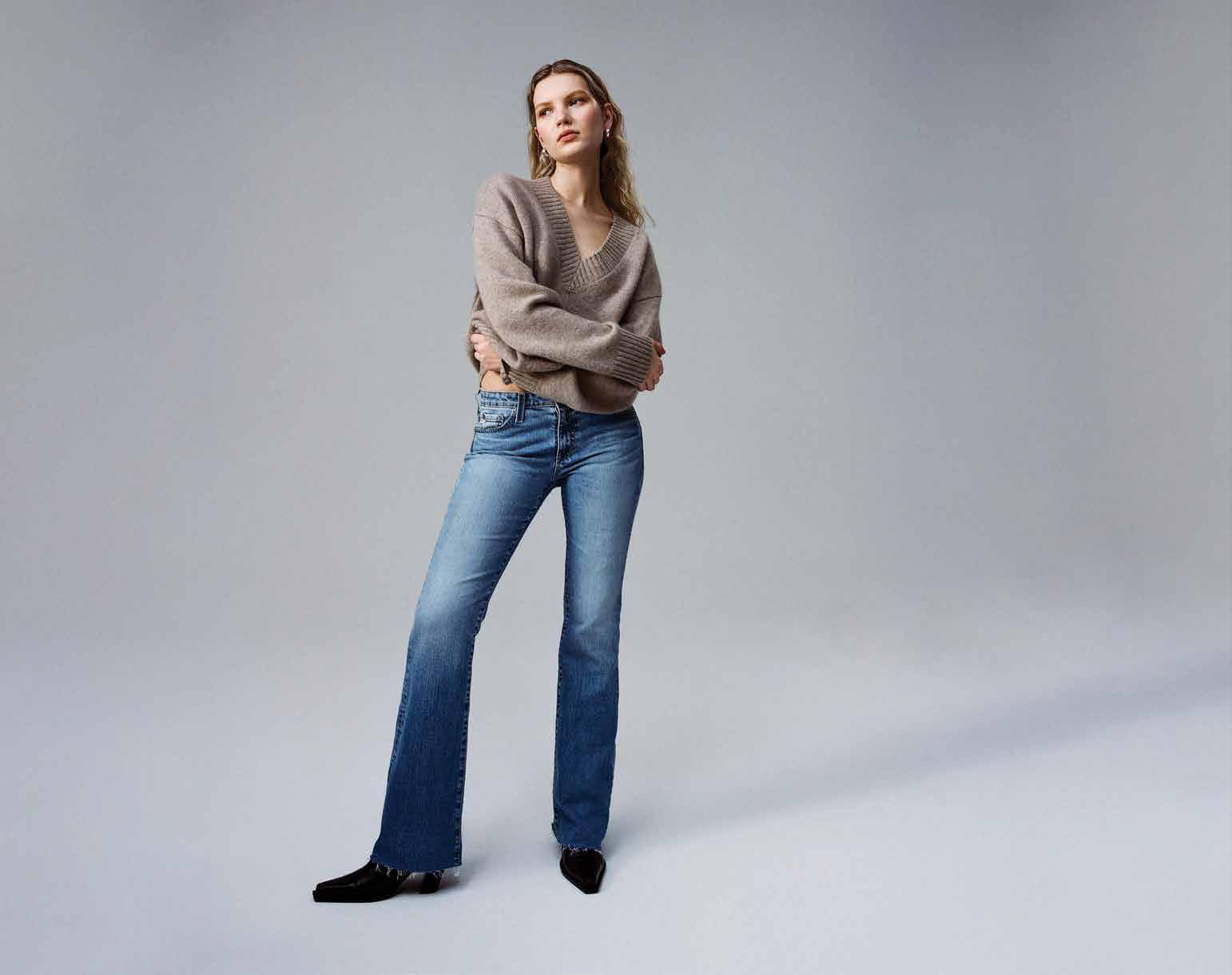
12 • RIVET
AG JEANS
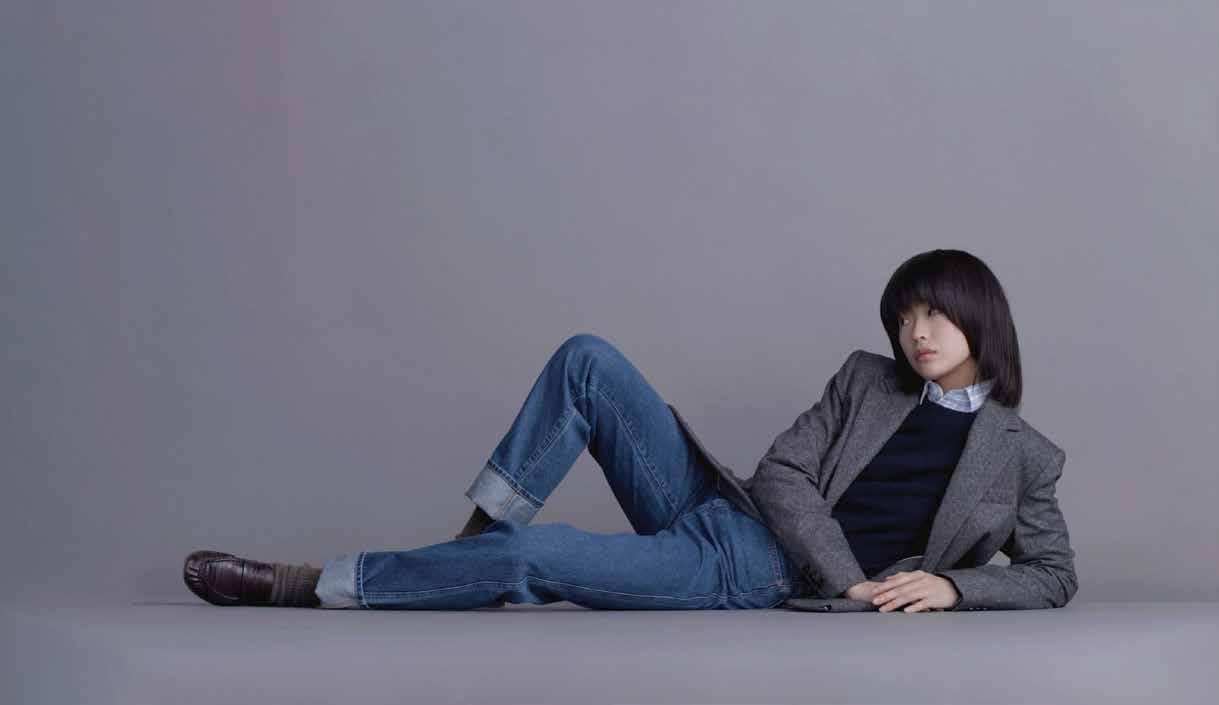
washes and aged blues, as well as bright whites, warm ecrus and vivid pastels,” Ahmed said. “With an emphasis on fit, this collection offers a variety of flattering silhouettes that can be worn casually or paired together for a more polished look.”
While creating its new collection, DL1961 made sure to keep sustainability top of mind by using high quality fibers like Recover recycled cotton and Tencel lyocell.
“All our denim is produced in our vertically integrated factory, which allows us to keep tighter control on the entire design and manufacturing process from fiber to finished garment,” Ahmed said. “We believe in production methods that are better not only for the planet but also for the people who physically produce our denim.”
The collection retails for $69$299 and is available now on DL1961’s website. —AC
PAIGE
Premium denim brand Paige continues to grow its footprint in the men’s market by launching its first men’s footwear collection. Versatility underpins the collection, which spans four suede and leather sneakers and a Chelsea boot available in sand and chocolate suede.
“The introduction of our new shoe category is a natural progression for us as a brand,” said Jon Geller, Paige men’s director. “With multiple styles catering to many tastes, we’re confident our shoe collection stays true to the Paige DNA while offering something for every customer.”
The footwear retails for $228$$378. The collection is available now on Paige’s website and in the brand’s stores. —AV
PISTOLA DENIM
Barbicore lives on through Pistola Denim.
“Barbie” took the world by storm last summer, becoming a cultural phenomenon. During that time, L.A. based Pistola saw a resurgence of interest in its Grover jumpsuit after “Barbie” director Greta Gerwig wore the flamingo pink version. Capitalizing on the moment, Pistola is now creating a children’s version for a “mommy and me moment,” according to Grace Na, founder of Pistola.
“We thought it would be really cute to create a couple of colors
in our Grover for kids so they can match their parents,” Na said. “The fit is very similar to the grownups; however, we’re adding a zipper pull to it so it’s easier for kids to wear.”
Available in green, pink and blue, the kids’ jumpsuit will launch later this year and retail for $90. —AC
ICON DENIM
Los Angeles-based brand Icon Denim focused on elevating its denim assortment this spring with soft fabrications and fresh colors.
The Gigi Hadid and Rosalia approved brand offers cool-girl staples like a front slit maxi skirt,
▲ DL1961 focused on aged blues and vintageinspired washes for spring.
◄ AG reintroduced its most popular low-rise jean.
▼ Loose fits are key to Icon Denim’s L.A. aesthetic.
wide-leg shorts and miniskirt, plus an array of utility-inspired pieces. Jeans, jackets and skirts boast cargo pockets. An oversized shacket offers versatility. Lavender, lime and white cream washes lighten the heavy-duty cotton pieces. Icon’s men’s assortment offers loose and wide fits—some with rips, slashes and shadow pockets.
“Items in this collection expand past the classic jean silhouette,” said Valy Vittoria, PR and communications at Icon Denim. “Icon focused on creating a versatile garment that can be easily integrated into everyone’s wardrobe for all occasions. With the new collection, Icon Denim invites the consumer to embrace creativity with looks ranging from neutral shades to bold colors.” —AC
JOHNNY WAS
Boho is back and a new collection by Johnny Was brings denim into the fold. The California-based lifestyle brand launched its first women’s denim collection to complement its vibrant print tops, tunics and silk kimonos.
The initial Johnny Was Denim line includes five fits—bootcut, boyfriend, slim boyfriend, baby boot and wide-leg—and a denim skirt. Washes span indigo, white and light pink. The collection retails for $178-$198.
“Our denim collection enables our customers to embrace head-to-toe dressing, offering a plethora of outfitting possibilities and enhancing their styling versatility.” said Sydnee Miller, Johnny Was director of global merchandising. —AV

RIVET 13 PHOTOS: COURTESY NEWS
ICON DENIM
DL1961
AIRPLANE MODE
What do brands need to know before sending creators jet-setting on influencer trips? by Meghan Hall

from unboxing and try-on hauls to “GRWM” videos, products have long been the currency exchanged between influencers and brands. The business of influencer marketing is evolving, however. As video platforms like TikTok allow influencers to show more of their personality and day-to-day life, brands are bankrolling multiday trips with fellow influencers in the hopes of videos going viral.
Cosmetics brand Tarte has become synonymous with bucket list influencer trips, sending the likes of Alix Earle and Monet McMichael to Dubai last year, and another group to Bora Bora last month. Guess put a gaggle of influencers and their friends on a private plane to Coachella last year, where they stayed on a compound of party houses for a weekend. Then there was Shein’s attempt to quell allegations of forced labor by sending influencers to visit their Guangzhou, China factory.
While many of the trips attract the ire of consumers for their lavishness (Tarte) or attempt to greenwash (Shein), they succeed in generating buzz and views.
Here Evan Wray, CEO and cofounder of influencer marketing firm Mavely, and content creator Cici Michele Haith (@_cicimichele) share the “dos” and “don’ts” to a successful influencer trip.
● DO
Create valuable networking opportunities for creators
Trip itineraries should strike a balance between work and play. “There are plenty of influencers that just want to have a lot of fun, but what we’ve found is the ones that are going to be more professional—and really, what the brands are looking for to represent their brand—they are running these as businesses, so they’re not just trying to go have a party,” Wray said. “They’re trying to learn, connect and further their businesses.”
Haith explained that some of her most valuable experiences on brand trips have come from opportunities to meet highpowered founders and industry players. “Brands should take into account that meeting other influencers is great, but it also would mean a lot to meet some higher-ups in the industry,” she said.
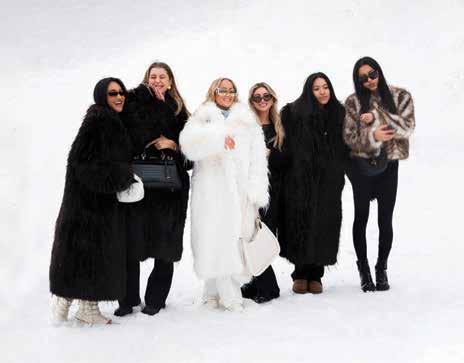
(Top)
Festival to the infamous Frye Festival due to long waits, unorganized transportation and lack offood and water. The retailer rebounded in 2023 with a successful event.
● DON’T
Make the trip feel unattainable for your brand’s target audience.
Brands should critically consider their target audience before beginning to plan a trip. For many consumers, elaborate trips to foreign islands don’t make the annual budget—and relatability plays a major role in strategy when using influencers to drive interest in a company, Wray said.
For that reason, Wray said, Mavely has begun to advise brands to consider smaller-scale trips in locations closer to influencers’ homes—both for the sake of influencers’ time and in the interest of feeling relatable to the target audience.
“If your goal is to connect with their audiences in an authentic way at scale…then it needs to be something that's more authentic and more relatable than flying on a private jet to Coachella,” he said.
“I think that’s the thing that a lot of brands can miss with these influencer experiences, is who is your audience?”
● DO
Think of the tiny details.
For your next influencer trip, remember that sometimes, the devil really is in the details.
Haith, who lives in Maryland, said she has gone on two trips with Ulta Beauty—one to New York City, and another to Los Angeles. On both occasions, she noted, she rarely had to give transportation and logistics a second thought. “I’m not thinking of how I’m getting home from the airport when the trip is over; they had Uber codes for us,” she said.
“All the details being thought out was great.”
● DON’T
Mandate inorganic content from trips.
Brands should steer clear of mandated posting schedules during the trip. Haith said brand trips already have jam-packed schedules and advised that brands not add an extra burden by dictating constant content. Plus, it distracts creators from the high moments of trips.
She noted on the Ulta trips, rather than requiring posts throughout the duration of the trip, the brand asked for one post per month leading up to the trip. Haith said she thought that strategy was fair and effective.
“Don’t enforce such strict rules about posting; just let creators organically post about the trip,” Haith said. ■
14 • RIVET CREEDITS: COURTESY OF GUESS; KATIE JONES FOR WWD SOCIAL WORLD
In 2022, influencers compared Revolve
(Above) The mob wife aesthetic was in full force during Guess’ winter influencer trip to the Catskills.
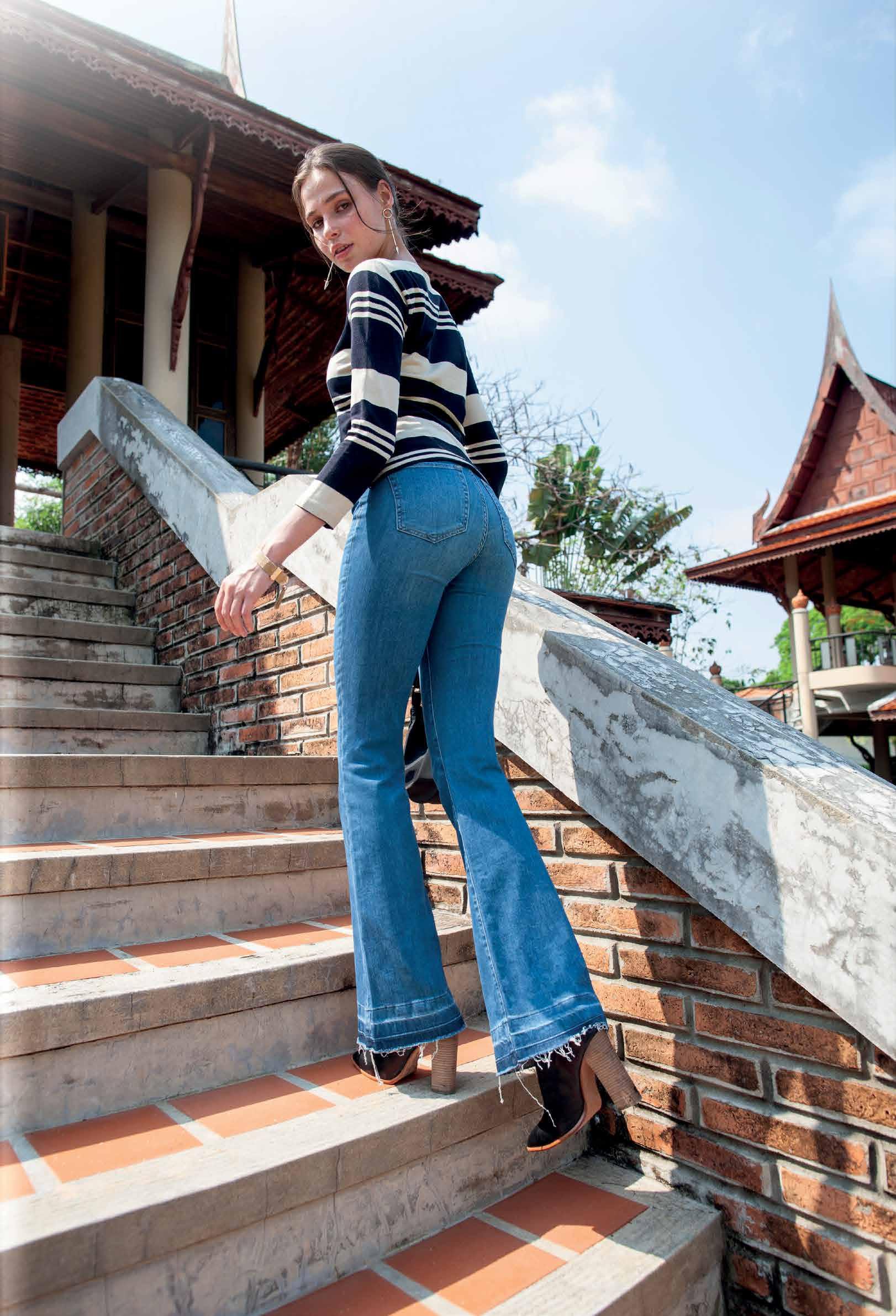
• Designed to optimize stretch
Targeted support in spesific areas such as belly and buttocks
• Improved garment shaping
• Meets different needs and preferences by professional ironing and smart design
• Thanks to advanced fabric engineering and stretch techniques offers stiffness and comfort
LOST & FOUND
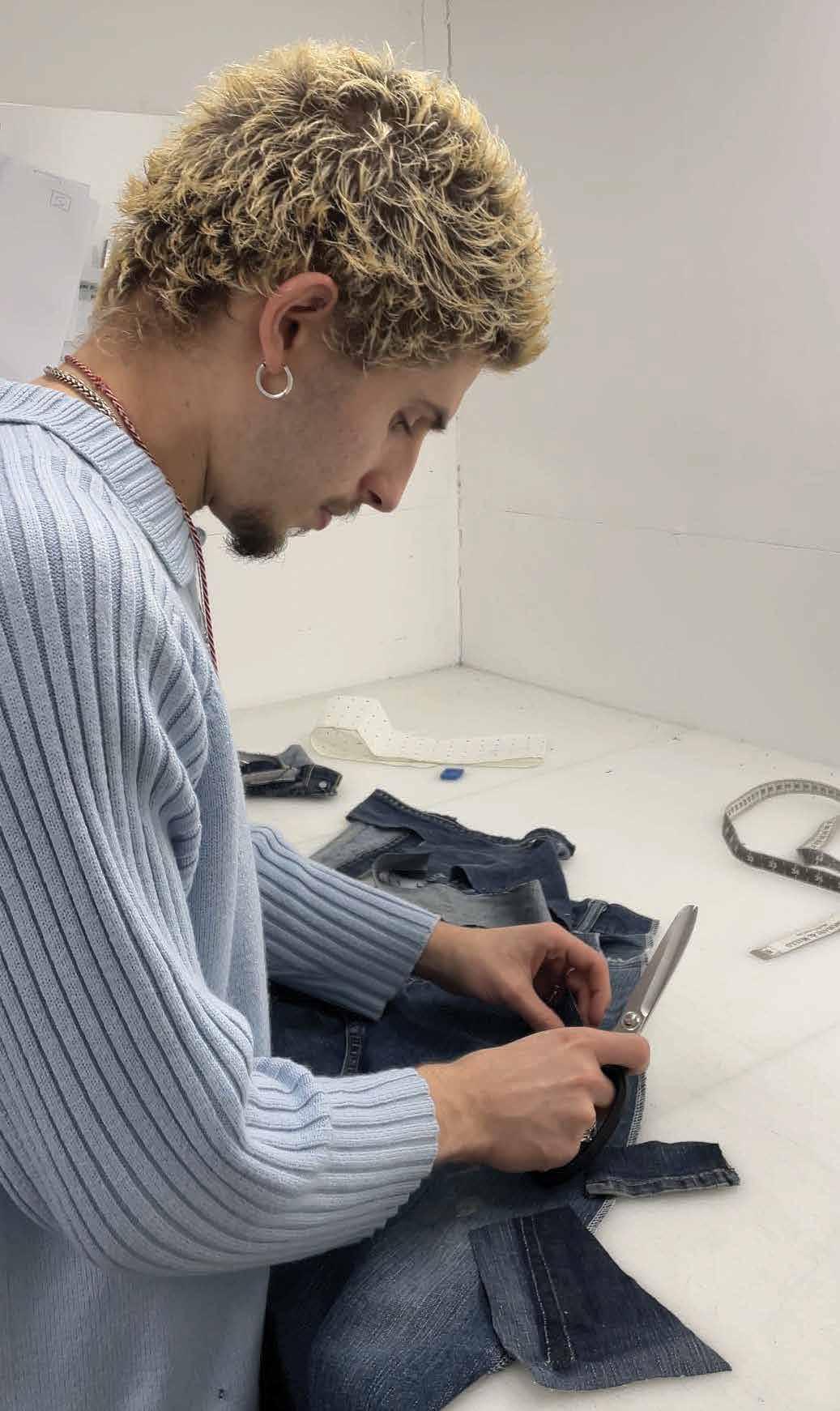
while it was a pair of handmade baggy jeans that put upcycle designer Joshua Samuels on the radar of denim and streetwear aficionados, the initial design served a much more personal purpose.→Londonbased Samuels set out to make his ideal baggy jeans and, in the process, landed on a style that resonates with others. “For years and years, I couldn’t find an easy way to add enough volume. I wanted my jeans to be so much baggier and I couldn’t find jeans that were baggy enough,” he said. “I would buy 40-inch jeans and belt them so much. It’s so silly.”

16 • RIVET STUDIO TIME
Designing for himself turned into a business for upcycled streetwear designer Joshua Samuels. by Angela Velasquez
Joshua Samuels makes each jean by hand in his London studio.
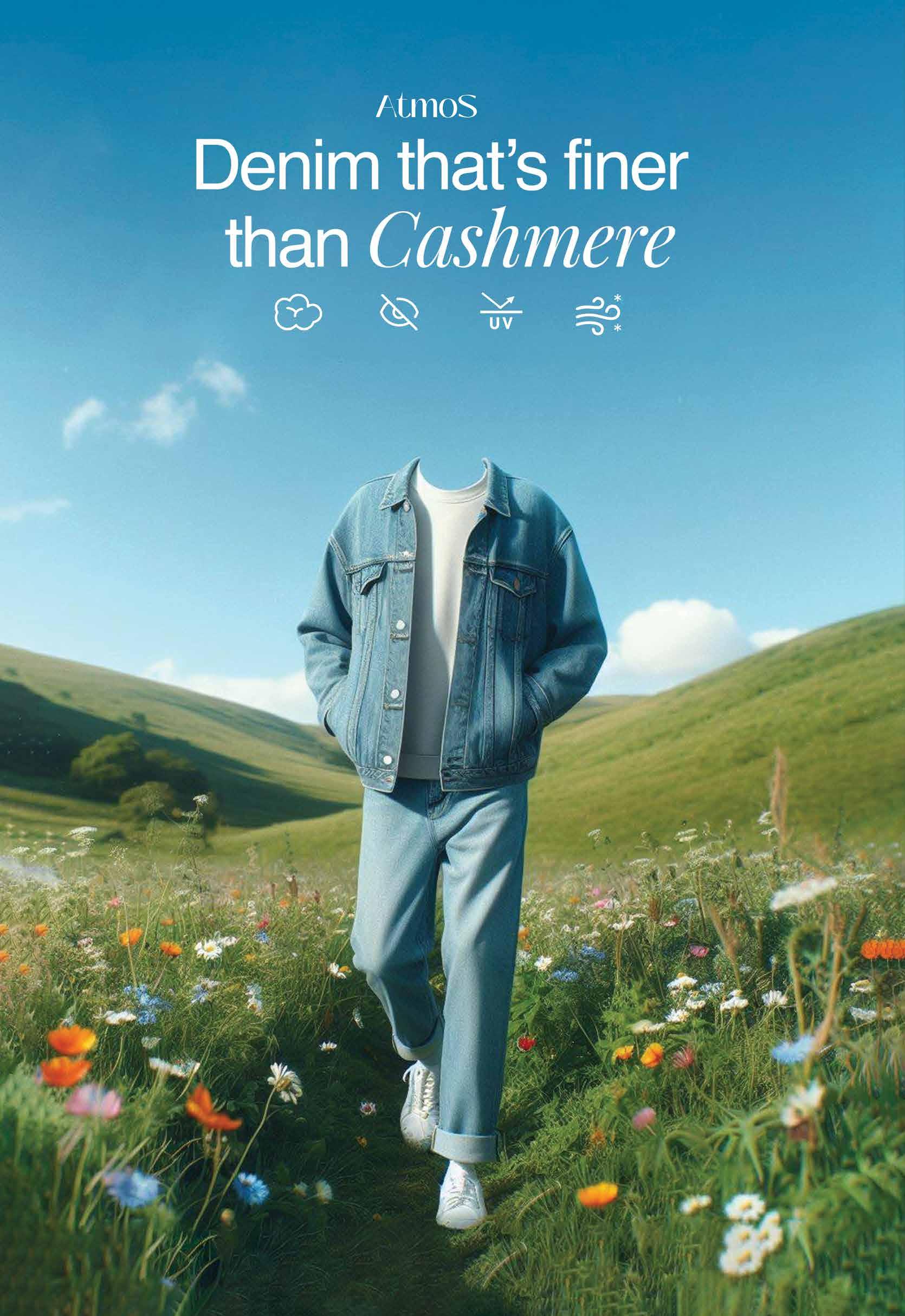



An Concept For more information, visit www tdmi-us com/atmos/#cashmere-denim Showcasing at Kingpins Amsterdam April 24-25, 2024 C - UV Protection & g
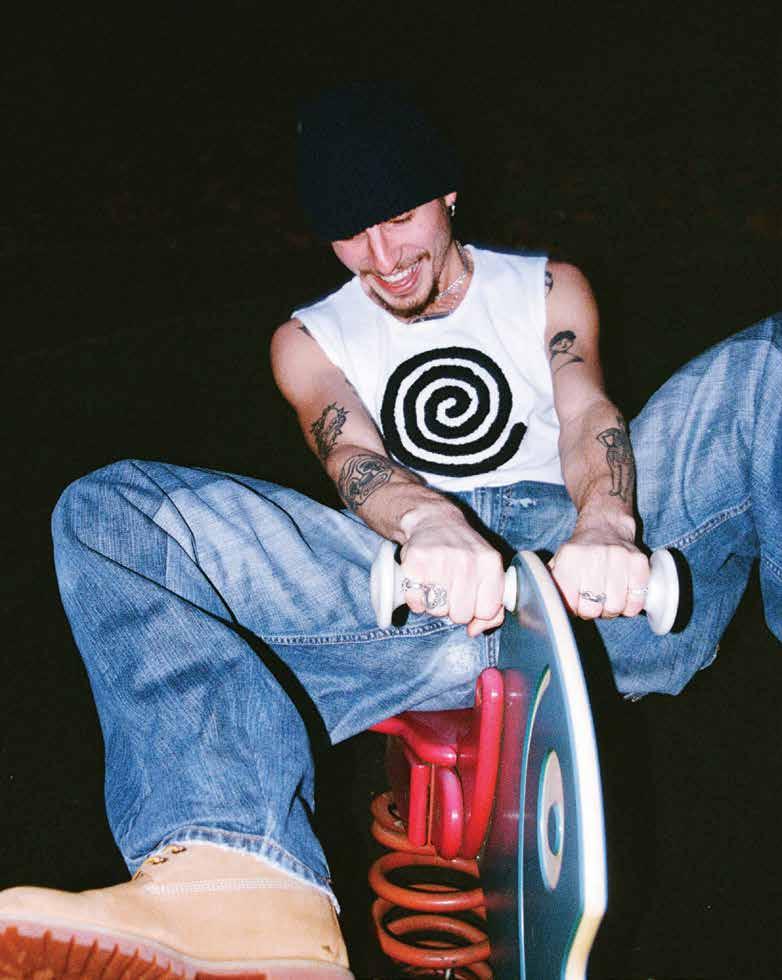
Made from vintage Levi’s and the offcuts of other made-to-order garments, the FO Baggy jeans have a tapered hem that gives its unique balloon shape. “I just knew what was wrong with every pair of baggy jeans I’ve ever had. And one of those things is treading all over the hem. But if you taper it in the right way at the ankle, giving it that balloon shape, that won’t happen,” he said. “The jeans will have the same baggy effect, but they’ll stay on your shoe.”
The jeans—and pairs of repurposed Dickies in the same voluminous style—anchor Samuels’ eponymous brand of repurposed apparel. The label— just 18 months young—offers reworked tees, pre-loved knits with appliqués and made-to-order items like the Combo Jacket made from upcycled denim fabric.
While sustainability underpins Samuels’ upcycled designs, it isn’t the main selling factor. “Increasingly, more people care about sustainability. But if you only target people who care about it, you won’t make a big difference. I want people to buy the clothes because they like the clothes and it’s just a nice little bonus that is also sustainable,” he said.
He is interested in making sustainable clothing more affordable, however. “I know that the jeans we sell aren’t the cheapest, but I look at how I can make the jeans the cheapest way,” Samuels said.
Each pair of his jeans is constructed from two pairs of existing jeans. The core—the inseam, crotch and fly—is made from one pair, while the added volume comes from the legs of another. “We have loads of old vintage Levi’s. We don’t need to use more manpower hours to make a new fly. The fly is already made for us. The fly isn’t broken; the fly is fine. We don’t need to do that,” he said. “The pockets are already made. We don’t need to do all that.”
Part of what makes upcycling exciting is what you find inherently will inform what you can make, Samuels added. Most
of his T-shirts, sweaters, knits and button-down shirts come from unsold charity shop stock. “Something like 80 percent of charity shop stock in the U.K. doesn’t get sold, and what ends up happening is some of the goes to landfill here, most of it goes to landfill in Africa,” he said. He also relies on a network of vintage and deadstock suppliers. On eBay Samuels found “a guy in Luton with 20 garages filled with old Levi’s.” He rings him up whenever he runs out of denim.
“I go and pull out the first few hundred I can find. Load up the car and say, ‘Thanks mate,’” he said. He uses a lot of Dickies from different vintage suppliers. “I think some of them even come from America because I’ll see a Goodwill tag on them,” he said. “There’s something really fascinating about someone wearing them for work in the U.S., doesn’t want them anymore and somehow they get to a vintage store in the U.K.”
A true Gen Zer, Samuel is drawn to the nostalgic aspect of fashion. His next collection will be inspired by the life a garment lives before being placed in a lost property box or donated to a thrift store.
I JUST KNEW WHAT WAS WRONG WITH EVERY PAIR OF BAGGY JEANS I’VE EVER HAD.”
▲ Instagram is Samuels' main marketing tool.
▼ The FO Baggy is made from two deadstock pairs of pants.
From the designer making decisions on its yarn, color and shape to the manufacturer producing it to the retailer that ordered it to the consumer who found something about themselves in the garment… “all these people do different things with that piece of clothing,” he said.
“The owner might just sit at home in it or go to the pub with mates, go out for dinner, see their family, play sports and work in it. It’s done so many different things,” he continued. “And then somewhere along that journey, they’ve decided they don’t need
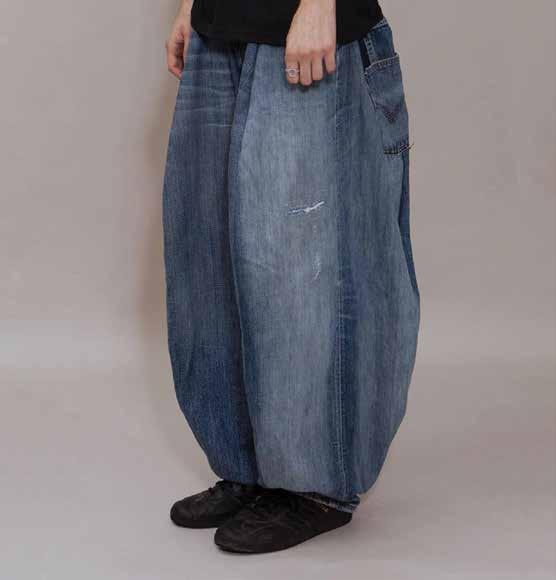
it anymore. Whether they’ve outgrown it, maybe the person who owned it died, maybe they lost loads of weight, maybe they got a little coffee stain on it— whatever it was at some point the connection between this item and the owner just died or broke and they decided to donate it to a charity shop. There’s something really cool about that whole process; it’s like life and death.”
Though always keen on fashion, it wasn’t Samuels’ career goal until recently. As friends went off to university or started jobs and internships after school, Samuels found himself in a “weird spot” unsure of his next step. Simultaneously, the U.K. was going through various periods of lockdown and social distancing. “I was working in pubs. I probably wasn’t in the best place mentally and I was bored,” he said.
Knowing how he liked clothes, one of his mom’s friends offered their old sewing machine, which he went on to learn how to use through YouTube videos. “I realized quite quickly that this is something I could really see myself doing, and it turned from being a hobby into something that I wanted to pursue professionally,” he said.
Samuels now works with two apprentices in his London studio. Instagram is the driver of new customers. “As much as social media is ruining my generation, it’s also really amazing. If I was trying to do this before it, I have no idea how I would have got it off the ground,” he said.
Though he’s excited to see how the brand can grow in the future and make a bigger environmental impact, Samuels said is enjoying where his business is now. “Any of my friends that are more business-orientated will hate that I say this, but I don’t design for a demographic or a target audience,” he said. “I do it very ignorantly like this is what I want, this is what I’m interested in right now. It’s just off blind faith and I hope other people like it too.” ■
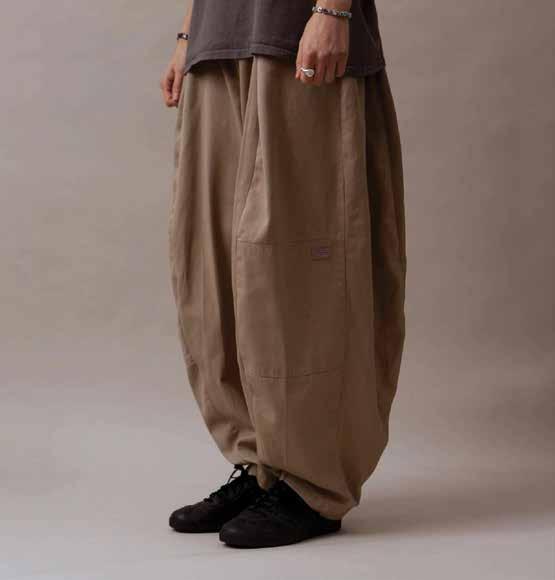
18 • RIVET STUDIO TIME IMAGES: COURTESY
Joshua Samuels


LOCAL STAR

“i think that austinites are , and seek out brands with authenticity and character,” said Jackie Berkley, Imogene + Willie community director.→ Imogene + Willie, the men’s and women’s denim brand focused on U.S. manufacturing since it started in 2009, fits the bill. → Opening a store in Austin was a natural next step for the Nashville-based label operated by Carrie and Matt Eddmenson, Imogene + Willie founders: KP McNeill, CEO; Katy McNeill, COO; and Jonathan Krohn, creative director. Both cities are rooted in artistic communities, driven by thriving music scenes and unique small businesses. Both are popular destinations for millennials and Gen Zers migrating away from major cities to enjoy their small-town feel with big-city perks.
The Texas capital also came with a baked-in clientele. “One of the largest factors in opening a store in Austin was that a significant number of our online sales were coming from the Austin area, so we had an established customer base in the area already. These customers don’t seem all too different from the Nashville customers,” Berkley said.
Described by McKinsey & Co. as “America’s boomtown,” the GDP of the Greater Austin metropolitan area has nearly doubled since 2010 and its population has grown by 36 percent. Austinites are experiencing growing pains, however. Berkley
said the cost to live and operate a business in Austin has skyrocketed over recent years, leading to more high-end retailers that can pony up the rising rent.
“The city has sadly seen the closure of many interesting, locally run stores,” Berkley said.
“I think the Austin community was very receptive to see a brand like Imogene + Willie open and represent something more locally focused.”
Imogene + Willie has found a comfortable home at 1401 S. Congress Avenue. Boutique hotels, retro restaurants, millennialfavored brands like Warby Parker,
20 • RIVET
Imogene + Willie fosters community in Austin. by Angela Velasquez
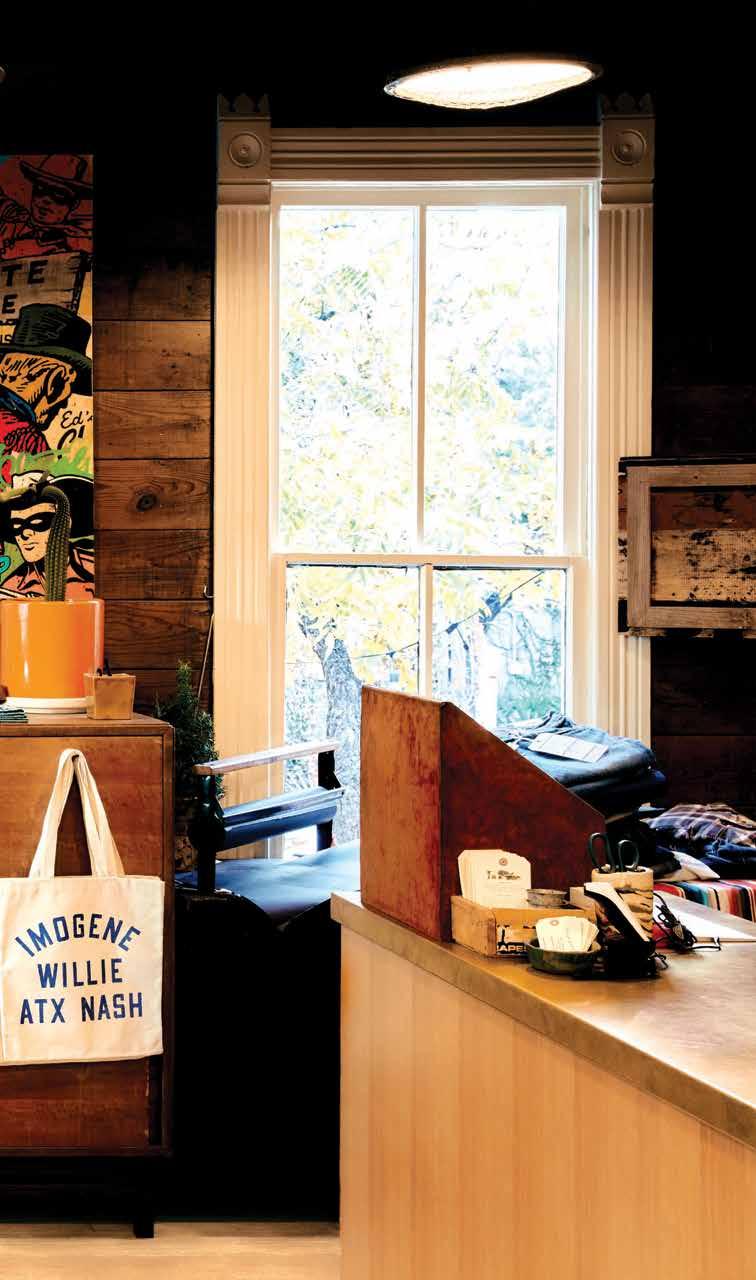
“We had our sights set on S. Congress, but knew our space was the only location on the avenue that we’d consider moving into,” Berkley said about the converted house built in the 1930s. “The building has so much character and an outdoor space that we felt was crucial for us to build a community.”
There was just one catch: Toms Shoes occupied the 1,600-squarefoot store at the time. The footwear brand didn’t have plans to leave but Berkley said they “planted the seed”
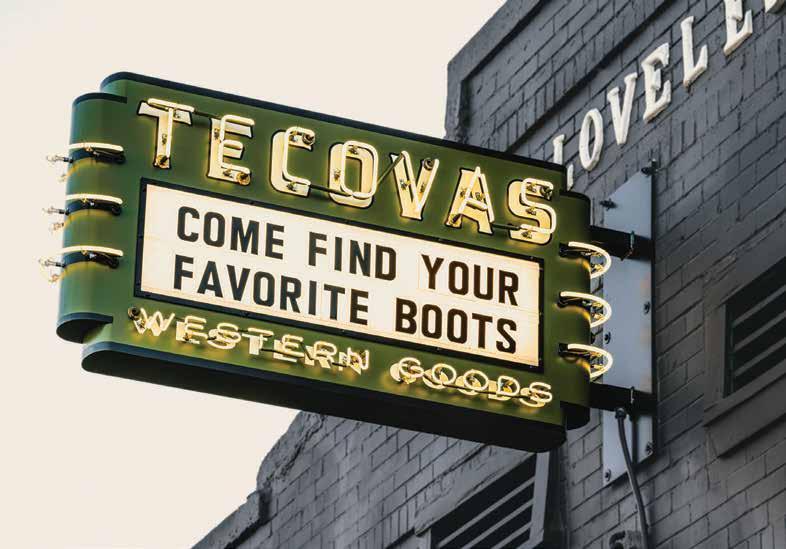
AUSTIN HITS
S. CONGRESS AVENUE’S MUST-SEE SHOPPING DESTINATION FOR ALL YOUR WESTERN FASHION NEEDS.
Allens Boots
1522 S CONGRESS AVE. AUSTIN, TX 78704
and hoped it would work out to take over the space when the time came around. “Fortunately, that happened sooner than we expected,” she said.
Imogene + Willie opened in October 2022. Like its Nashville predecessor—famously located in an old service station—Berkley said the Austin store “does an excellent job of showcasing the process of breaking in denim from its raw or rigid state.” Comic book artwork and hand painted signs lines the wood paneled walls. And there are no shortages of tattered vintage rugs and prickly cati. Worn-in couches frame the
midcentury fireplace. In addition to personalized denim fittings, the store offers alteration services on jeans and chain-stitch embroidery.
The Barton slim Indigo Rigid JP and the Catherine Indigo Rigid Nep are some of the store’s most frequently sold denim styles. A few pieces that are Austin-specific are preferred by locals, like the Cowboy Austin tee and the Bronco trucker hat.
The store also sells a variety of “third party” goods that are hand-selected from other likeminded businesses, Berkley said. Some products are developed in partnership like Imogene + Willie’s signature candle made with Apothia in Los Angeles. Other accessories are produced by local artisans, for instance, leather goods made by Nashville leather craftsman Emil Erwin. “His belts and trays are very popular,” she added.
Beyond sales exceeding goals, Berkley said the brand has “strived to build the local community” and has had several events with music, food, and people coming together over the year. It has a keen focus on philanthropic events where the Imogene + Willie team can rally around causes to raise funds and awareness.
“We love to share our spaces and welcome our community into it whenever possible,” Berkley said. “We sometimes invite other brands to take up residency at our shops for popups. A handful of times each year, we throw big parties with a ‘come one, come all’ attitude, where there’s typically good music, food and drinks, and friends—old and new.”
“Above all, we hope to make everyone who enters our store feel welcome and a meaningful part of our community,” she said. ■
An Austin tradition since 1977, Allens Boots is a one-stopshop for authentic western wear. The 8,500-square-foot store is home to thousands of traditional and fashionforward cowboy boot styles for men, women and children, as well as Stetson hats, Wrangler jeans and a trove of taxidermized creatures—some even playing the banjo. A few doors down you’ll find a wide assortment of discounted boots at Allens Boots’ closeout store.
Kendra Scott
1701 S CONGRESS AVE, AUSTIN, TX 78704
A patio, café and Instagram-ready murals are some of the inviting qualities of Austin-based Kendra Scott’s S. Congress store. In addition to a Color Bar, where shoppers can customize their own jewelry, the flagship is home to Yellow Rose by Kendra Scott, the Southwest-inspired sister brand that offers horseshoe-shaped earrings, silver and turquoise baubles and a recent apparel collaboration with Wrangler.
Maufrais
1512 S. CONGRESS AVE. AUSTIN, TX 78704
Whether you’re looking for a classic Cattleman or a straw topper to protect you from the Texan sun, Maufrais has the staff and wide selection to help you find the best cowboy hat. Choose from pre-shaped felt and straw hats that range from $140-$34 or a “top-to-bottom” hand shaping experience with hats that range from $500-$675. Personalize your hat with Maufrais’ range of hat bands, pins, sterling silver brooches, flowers, feathers and more. A true Austin experience, Maufrais does not sell their hats online due to the custom nature of their hat shaping and fitting.
Tecovas
1500 S CONGRESS AVE, AUSTIN, TX 78704
Austin-based Tecovas has cracked the code with cowboy boots that appeal to both ranchers and city slickers. The brand’s handmade boots balancing comfort with sleek silhouettes and on-trend colorways. The flagship S. Congress store also offers boot shining services and a wide selection of Tecovas’ women’s and men’s apparel, spanning pearl snap button-down shirts, logo tees and stretch jeans that fit over boots.
RIVET 21 PHOTOS: COURTESY OF IMOGENE + WILLIE; TECOVAS RIVETING RETAIL
LOVE TO SHARE OUR SPACES AND WELCOME OUR COMMUNITY WHENEVER POSSIBLE.” Jackie
WE
Berkley, Imogene + Willie
Ganni and Madewell and Austin stalwarts like Allen Boots line the pedestrian-friendly corridor.
▲ Tecovas is home to chic cowboy boots and western wear.
◄ Imogene + Willie has southern charm.
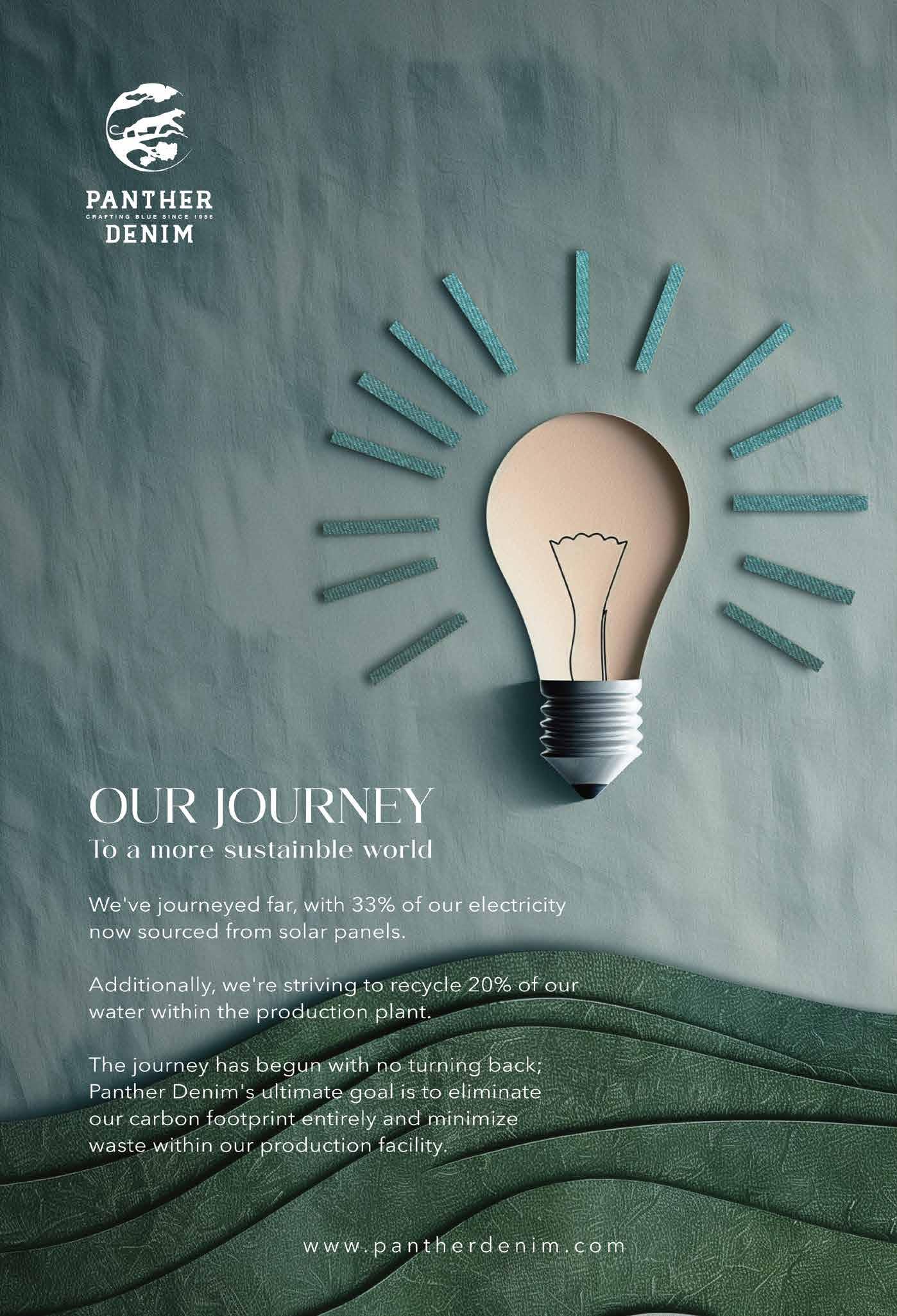
WESTERN WAY

global google searches for “cowboy hat” skyrocketed 212.5 percent following Beyoncé’s Super Bowl commercial, after which she dropped new country music. Online retailer Boohoo reported that searches for “cowboy boots” and “bolo tie” also soared by 163 percent and 566 percent, respectively.→The latest fashion weeks indicate that ready-to-wear and denim are next in line to benefit from Western’s revival. From Elie Saab showing traditional Western embroidery on dark denim separates to Molly Goddard’s kitschy country knits, Fall/Winter 2024-2025 collections are dense with cowboy motifs. →While recent examples like Pharrell Williams envisioning French-born Louis Vuitton through an Americana lens and Beyoncé adhering to a strict western dress code since announcing her country album “Cowboy Carter” have amplified the Western aesthetic and secured its grip on trendsetters for at least another season, Western fashion has been bubbling up as far back as the early 2000s through celebrities, according to Heajun Park, 7 For All Mankind’s global head of design, womenswear.→However, the recent surge of Western in films and media—from Margot Robbie and Ryan Gosling dressed in rodeo costumes in “Barbie” to fashion editorials featuring bonafide horse girl Bella Hadid—has widen the audience consuming Western content, she said.→
RIVET 23 SPECIAL REPORT
Fashion is deep into a Western cycle. by Angela Velasquez
▲ Wrangler's collaboration with Yellow Rose by Kendra Scott spanned apparel and jewelry.
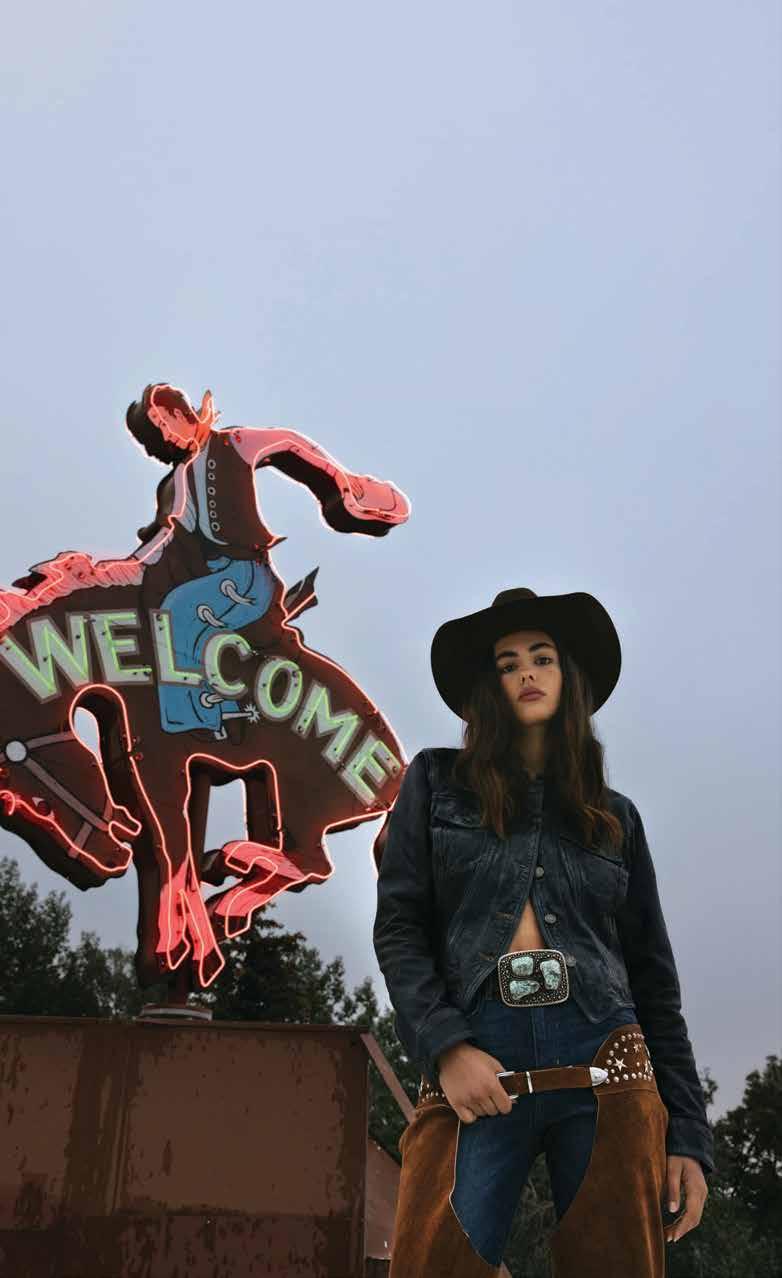
It’s hard to miss, given the bold way designers and stylists interpret the theme. “The revival of western-inspired fashion within pop culture is strongly represented with vibrant and theatrical interpretations of the utilitarian pieces worn by the early nineteenth-century American cowboys of our past,” said Isha Nicole, Boot Barn’s creative director and VP of marketing.
Retail intelligence firm Edited breaks the Western movement into six sub-categories: Mr. Americana, inspired by Williams’ denim, cowboy hats, neckties, workwear; Mr. Rodeo Drive, inspired by Bad Bunny’s studded denim and animal prints; Rodeo Drive, based on Beyoncé’s leather looks and luxury labels; Festival Cowgirl, inspired by the festival coordinates and cowboy hats worn recently by Kim Kardashian; Ranch Girl, based on Hadid’s check shirts and western belts; and Coquette Cowgirl, an aesthetic perpetuated by Lana Del Ray’s fondness for prairies skirts, bows and gingham.
GROUNDING QUALITIES
Park also credits Western’s timeless and versatile appeal to its recent popularity. “It can be rugged and sophisticated at the same time, and the fusion of traditional western motifs with contemporary designs are always great source of inspiration for designers, offering something both classic and modern,” she said. “It also speaks to consumers that are looking for unique ways to express themselves by giving them fashion forward items that still feel familiar and classic.”
In some ways, the Western aesthetic offers a sartorial detox from the deluge fashion cores and fads born on TikTok and Instagram.
“The American cowboy is emblematic of a rebellious spirit and a pioneering mentality; culturally, the cowboy’s iconic persona [celebrates] our heritage while symbolizing nonconformity,” Nicole said. “In a confusing era among the early adoption of AI
◄
and technological overstimulation, there is a shared appreciation for a more organic, humble and authentic existence.”
For Wrangler, which has recently shared its cowboy roots with Staud and Sandro in collaborations, it goes deeper. “Western is not a trend. Western is really a way just like activewear, ready-to-wear and outdoor. It’s a choice and I think it’s all about how it makes consumers feel,” said Vivian Rivetti, Wrangler global VP design. “If you think about the presence of a cowboy or cowgirl, there’s a sense of pride. There’s a sense of competence. The way they stand, the way they tip their hat…it is about exuding confidence. And I don’t think there’s anything more attractive than someone who is confident.”
MAINSTREAM MANIA
While Western themes has waxed and waned in fashion for decades, often repackaged as Americana, heritage or bohemian, it hasn’t been this widely embraced by mainstream fashion. In fact, prior to the last decade, Nicole said fashion within the Western space “was a bit taboo.”
IF YOU THINK ABOUT THE PRESENCE OF A COWBOY OR COWGIRL, THERE’S A SENSE OF PRIDE.” Vivian Rivetti, Wrangler
“Before that time at Boot Barn, we exclusively focused on utilitarian pieces designed to meet the needs of the working cowboy. But over recent years, another viewpoint emerged within the Western community—toying with western fashion as a theatrical celebration of cowboy culture started to develop,” she said.
At this time, Boot Barn launched its exclusive women’s fashion brand, Wonderwest, to “bring pieces that ignite new runway trends by modernizing classic western motifs—pieces woven with threads of resilience—into contemporary fashion,” she said.
Wonderwest’s offering spans cropped leather jackets and vests, fringe suede shorts and studded denim jackets and jeans to beaded slip dresses and bridal dresses. Wonderwest enables Boot Brand to stand out among other national retailers, Nicole said, by curating timely collections and driving marketing strategies tailored specifically to this fashion
customer, which draws more people into the brand.
The fashion pieces show a new side of the retailer, but Boot Barn isn’t losing touch with its roots.
“While we carry a house of brands that caters to many different customers—from fashion to function—we lean more toward the staple pieces suitable for and characteristic of the rugged Western lifestyle,” Nicole said.
However, the retailer sees consumers buying a mix of classic Western pieces and novelty items like interesting cuts and embellishments. Nicole added that traditional stitch patterns seen on cowboy boots are on the rise currently. “There are a lot of brands within the Western space doing exciting things, from traditional to nuanced, including Cody James, Wrangler, Idyllwind Fueled by Miranda Lambert, and Shyanne,” she said.
7 For All Mankind already offer timeless and heritage fits that align seamlessly with the western trend, Park said, naming the brand’s boot cuts and Dojo flare as prime examples. “We also recognized the opportunities in western influences as fashion details and have incorporated into our collection. Our designs in Spring ’24 feature subtle westerninspired details, such as shaped yokes, contrast stitching and row studding,” she said.
Looking ahead, Park said Western’s presence on the runway proves that “the style is here to stay” but will evolve in contemporary and modern way.
“As a denim brand it is undeniable that our roots lie within the trend since it was the first cowboy that made jeans so popular. At 7 For All Mankind, it is inevitable that we will always carry a bit of that identity since it is rooted so deeply in our spirit as a denim brand,” Park said.
Nicole doesn’t foresee consumers veering off from the cowboy hats and boots that have fueled the Western trend to where it is today. Rather, they’re getting stronger. “The American cowboy is so deeply engrained within our national culture that it’s unlikely there will be much diversion from the cowboy’s iconic style within the fashion space. Instead, we anticipate the evolution of the iconic style deepening more as we dive into 2024,” Nicole said.
With the West imbued into its DNA, Boot Barn plans to stay the course and ride out the country tidal wave and continue to serve its core Western consumer.
“Rather than changing our business model based on what’s popular now, we remain firmly grounded in our mission and vision. However, we do stay focused on fashion trends to keep the brand modern, fresh, innovative, and at the forefront of the industry,” Nicole said. ■
24 • RIVET PHOTOS: COURTESY SPECIAL REPORT
Boot Barn's Wonderwest brand combines runway trends with cowboy heritage.








FESTIVAL FORECAST

26 • RIVET SPECIAL REPORT
Festival fashion from the 2010s are inspiring 2024 Coachella trends.
Pinterest shares how pinners are preparing for festival season. by Angela Velasquez

can fashion from 2014 be described as nostalgic? ��������es, when it’s iconic as flower crowns and fur boots in the desert, according to Pinterest. ������ Ina new report, the visual inspiration platform named four fashion themes—one being “2014 core”—bound to make a splash at Coachella April 12-14 and April 19-21 in Indio, Calif. ������ Inspired by the original festival looks worn by Coachella devotees like Vanessa Hudgens and Alessandra Ambrosio, the new fashion core offers updated takes on crochet designs, lace flare pants and statement belts. Pinterest said searches for “2014 core” are up 1,240 percent year-over-year.
The OG of festivals, Woodstock, underpins the aughts theme with “hippiecore” searches up 890 percent and “funky crochet” searches up 2,100 percent on Pinterest. Elements of rave culture are part of the look as well, with searches for “fur boots outfits” up 600 percent and searches for “rave makeup ideas festivals” up 300 percent.
Boho jewelry plays a factor in 2014 core, with Pinterest users looking specifically for headpiece jewelry, nose rings, ear cuffs and gold choker necklace sets.
Pinterest noted a 75 percent uptick in searches for rhinestone denim jackets as well.
“With tens of millions of searches related to Coachella on Pinterest, and 40 percent of those searches driven by Gen Z, the platform has become a go-to destination and ultimate companion for users to find inspiration, plan and shop their beauty and fashion looks for festival season,” Pinterest stated.
In addition to classic festival fashion an upward trend, festivalgoers are searching for ways to dress like Coachella 2024 headliner Lana Del Rey.
Searches for “Lana Del Rey core” are up 300 percent, Pinterest reported. Based on vintage and feminine style, the theme piggybacks on the current coquette aesthetic driving Gen Z to swap their cottagecore frocks for corsets and ballerina-inspired skirts. Searches for “mini corset dress,” “vintage corset” and “simple tulle dress” have seen triple-digit increases on Pinterest. Pearl belt and pearl bow have seen searches increase 55 percent and 250 percent, respectively.
Bows tie the ultra-girly pieces together, with pinners looking for bow jewelry, and inspiration for bow-adorned updos and braids. Searches for “bow nails” are also up 6,430 percent.
Coachella is always a stage for experimenting with escapist fashion. In 2024, that means dressing like fairies.
“Whimsical fairy themed outfits will be key in this year’s festival as fairycore has continually been on the rise, allowing people to
seeing a 630 percent uptick in interest.
Pinterest’s fourth Coachella trend contrasts with the more feminine and mythical aesthetics. Searches for “dark feminine core” are up 160 percent, driven by Pinterest users who have “the urge to question conventional femininity and get out of their comfort zones.”
The theme calls for a mix of elegant fashion and edgy accessories. Searches for “satin slip dress” and “brocade corset” have each increased 100 percent. Meanwhile, searches for “leather pants look” have increased 220

300% 1,240%
dress up and escape their realities,” Pinterest stated.
Lace is key to the ethereal theme. Searches for lace slip dresses are up 420 percent and searches for lace sets are up 150 percent. Interest in lace midi skirts is up 150 percent. Bell sleeve dresses and crochet bell sleeve tops are also seeing increases in searches, up 50 percent and 100 percent, respectively.
For a touch of sparkle, Pinterest said pinners are looking for sequin fringe dresses.
Festival goers are looking for ways to carry the aesthetic into their beauty routine. Pinterest said users are searching for “sugar plum fairy makeup,” “boho Fulani braids” and “cottagecore nail,” which have each seen four-digit increases in searches. “Fairy cut hair” is also
percent and searches for “leather tube dress” increased 86 percent. Biker boots, black furry boots and “high leather boots” ground the look—each footwear trend seeing triple-digit growth on Pinterest. Silver chain belts and silver nose rings are part of the ’90s inspired trend, as well as red wine nail color (up 1,780 percent) and red leather bags (up 510 percent). ■
28 • RIVET PHOTOS: GETTY IMAGES SPECIAL REPORT
YOY increase in searches for “Lana Del Rey core” YOY increase in searches for “2014 core”
▼ Model Alessandra Ambroisio (center) and friends embodied the 2010s festival look.
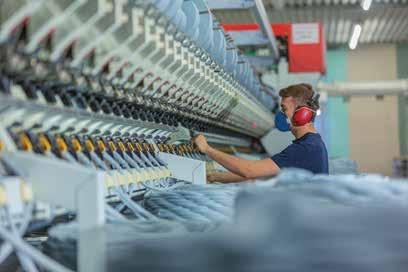

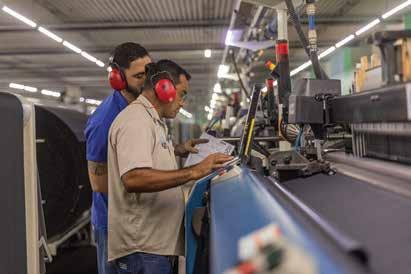
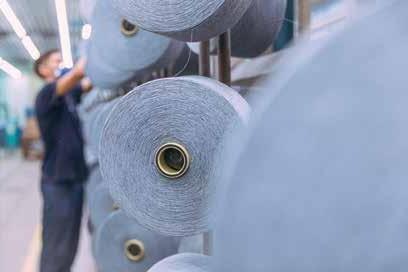

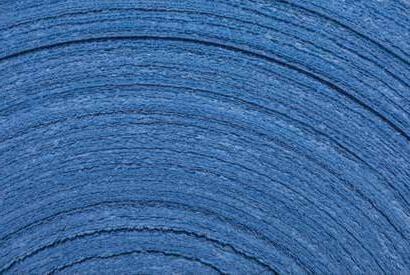
REGENERATING YESTERDAY TRANSFORMING TODAY
HARVESTING THE FUTURE





Regenerate to build a permanently sustainable future
Vicunha proudly stands as the first company to incorporate locally sourced and traceable cotton from regenerative farms into its denim fabrics manufactured in Brazil. These fabrics are crafted using the most environmentally conscious methods in our certified plants in the Northeastern region of the country.
Scan to learn more:
DREAM
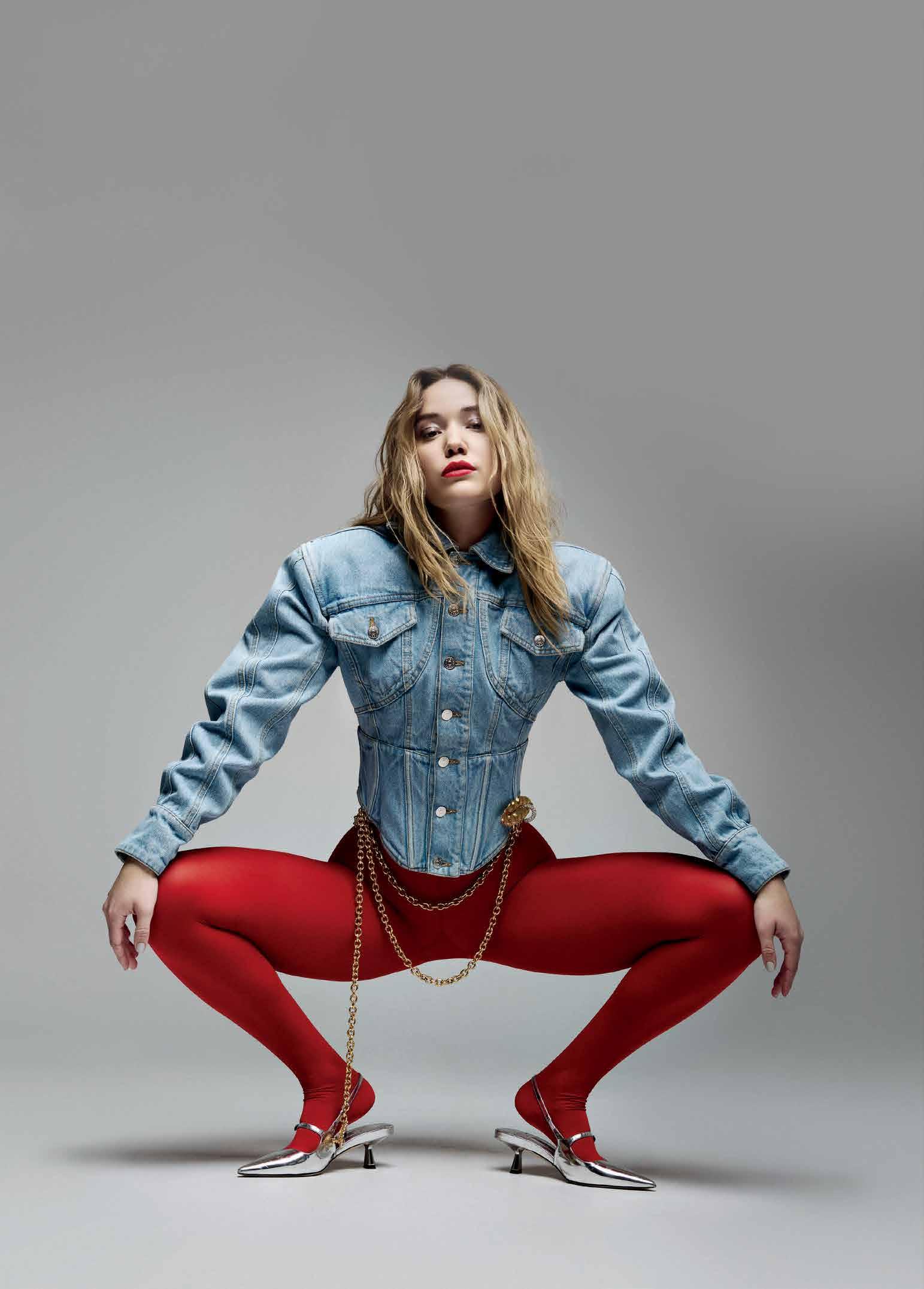
30 • RIVET
Bold denim matches model and influencer Olivia Ponton’s fearless approach to living life. by Leigh Nordstrom
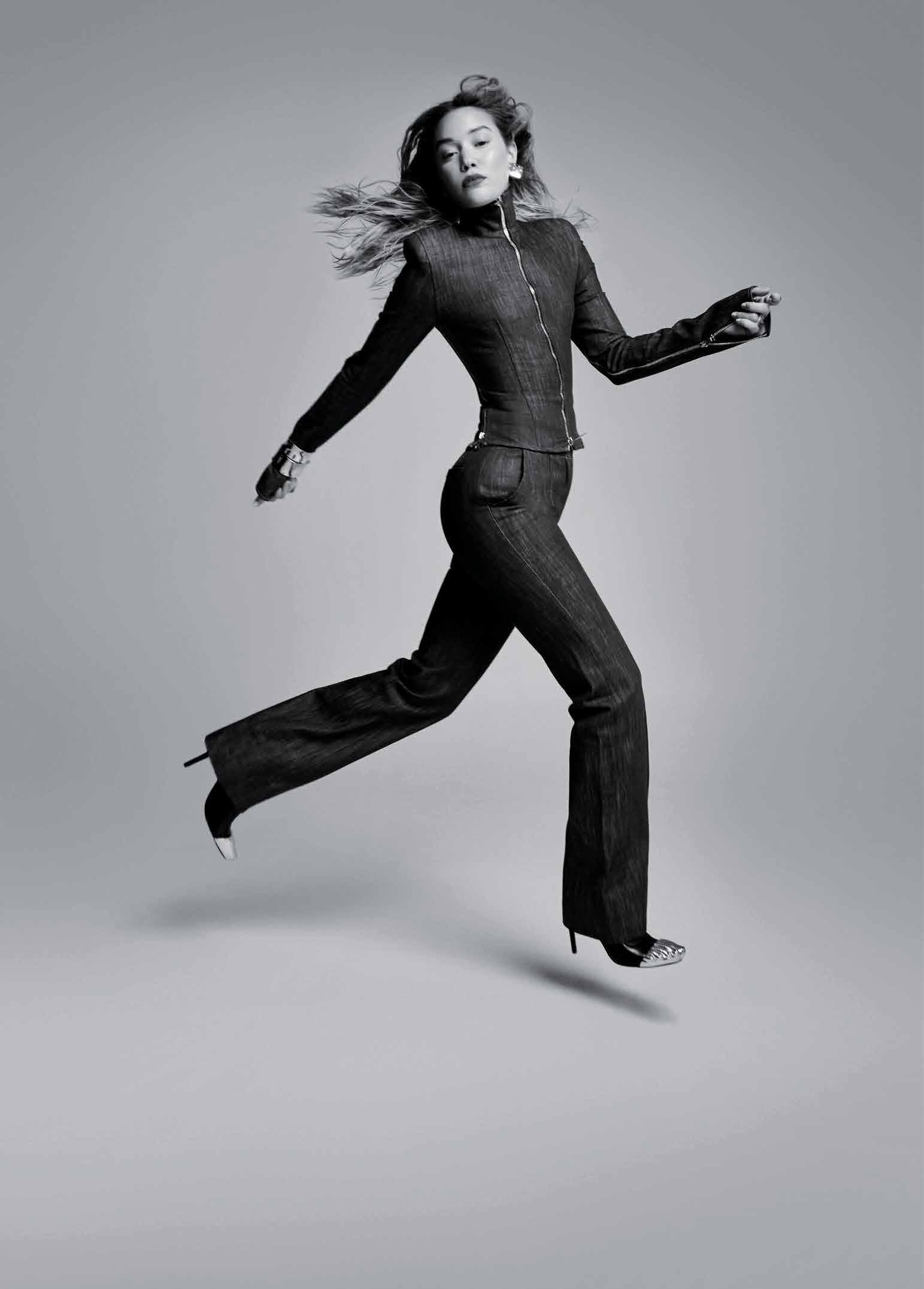
CHASER STYLED BY ALEX BADIA • PHOTOGRAPHS BY EMERALD LAYNE
olivia ponton was only a few months into her stay in Los Angeles, where she’d relocated from her native Florida, when she confessed to her thenagency her lifelong dream.
“I really wanted to book Victoria’s
Secret for modeling,” she recalls. “And they were
kind of like, ‘Hey, if you want to book it, you’ve got to come to New York.’ So, I quite honestly moved a week later.”
Two-plus years on, the 21-yearold has worked with the legacy lingerie brand, as well as Sports Illustrated for their swimsuit issue, and has made New York her home in the process.
The first year was difficult, as she tried to make friends and find a routine amidst the Covid shutdowns. Now, though, she’s in love with the city, having formed a community with other creators at events and turned her attention to furthering her career in fashion.
“I really want to book a Calvin Klein campaign,” she says of her next goal. “I did their Pride campaign last year, but to do a straight up denim campaign with them would be an amazing dream.”
Moving to New York was quite the fashion adjustment for the Naples, Fla., native, who grew up “wearing bikinis 24/7.”
New York, I was like, ‘Oh, people don’t wear swimsuits. Weird.’”
“I always had 200 swimsuits at all points of my life. I’ve had more swimsuits than I’ve had clothing,” she says. “And when I moved to ◄ ◄ PREVIOUS LEFT: MUGLER DENIM JACKET; CALZEDONIA TIGHTS; JIMMY CHOO MULES; SCHIAPARELLI BELT. RIGHT: LAQUAN SMITH DENIM JACKET AND TROUSER; SCHIAPARELLI BOOTS; CELESTE STARRE EARRINGS; RETROFÊTE BRACELETS; ACCHITTO RINGS. ► ALEXANDER MCQUEEN DENIM JACKET AND SHORTS; WOLFORD TIGHTS; SCHIAPARELLI EARRING.
imagination and my own world and my own brain. I don’t need the constant information being thrown at me,’” Ponton says.
“I think in the beginning, people were trying to prove that TikTok was important, but I think people now are aware of that. And I would say less is more on TikTok because I feel like there are so many amazing creators on it that you really want to post stuff that is true to you and stuff that makes you genuinely happy, and not post for other people,” she says.
In 2021, Ponton came out as bisexual on social media, which she says has helped her “in amazing ways” when it comes to her role in the public eye.
These days she aims to emulate Emily Ratajkowski’s style and likes following the latest runway shows in Milan and Paris from her phone. “I feel like that on its own has been so educational and fun for me to play into the different roles of the season,” she says.
Ponton’s career began more in a social role than modeling, which continues to be a big part of her appeal. In 2020, she was part of the Hype House in L.A., a collective of TikTokers who lived together and created content. Her relationship with the app, which at 7.7 million followers is her largest platform, continues to evolve with time.
“With TikTok, I think it’s grown bigger than any other app on our telephones. I think it is something that, especially my generation, we use a lot to get our news, to get what’s going on in the world. We get all our information through that. And I think sometimes, I mean, I even take cleanses where I will go off TikTok for three or four days because it’s constant. So much information is thrown at you, and sometimes there are days where I’m like, ‘You know what? I need to just bask in my own
“I finally also had a community that I could relate to and be involved with more often, and I got connected to a wider range of friends that I could relate to, and we could talk about some of the hardships that are coming along with it,” she says. “I follow a lot of girls who are femme lesbians or they’re a part of the LGBTQ community, and I think it’s fun to be able to bat off things that we’re going through or talk about girls. Yesterday I was at lunch with a friend and it’s just a fun thing to talk about. Like, ‘Oh my gosh, yes.’ When I came out versus when they came out, our coming out stories. And I feel like it’s a very bonding experience with people. I would say I definitely felt a group of loving, appreciative, amazing people were there for me. And that’s what I like to do for other people when they choose to come out.”
In the months ahead, she has plenty of travel plans, including her annual trip to Tahiti to work with the organization Coral Gardeners. The 15 hours it takes to get there is no deterrent, as a hands-on approach is her preferred method of involvement, be it charity or a brand deal.
“I personally just love meeting the back-end people on the brands because that’s when you get to really understand what the brand’s about,” she says. “I love to be on the backend and understand why brands are choosing to do this versus that, and why they’re choosing to work with the people that they are working with.” ■
32 • RIVET
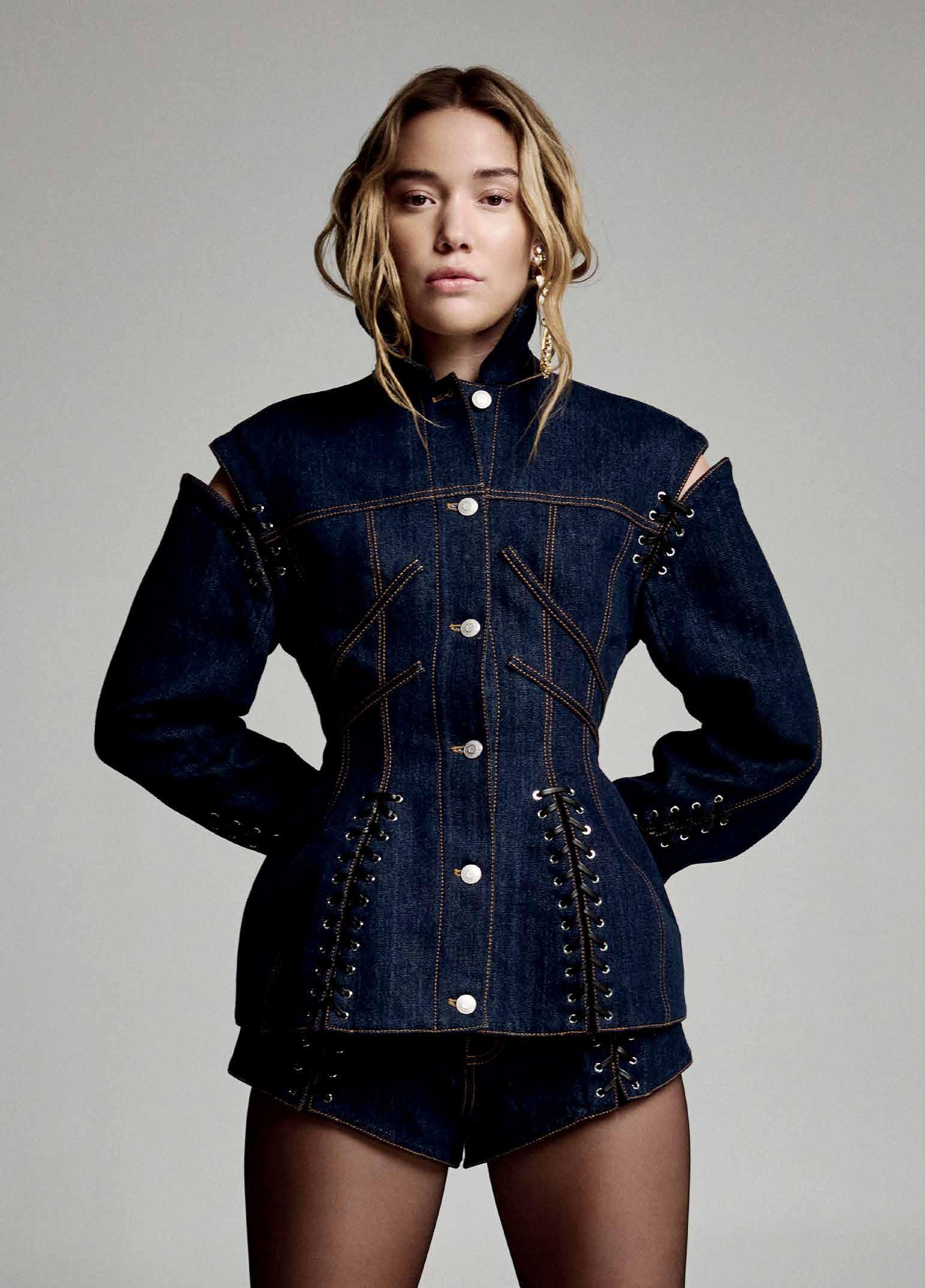
RIVET 33
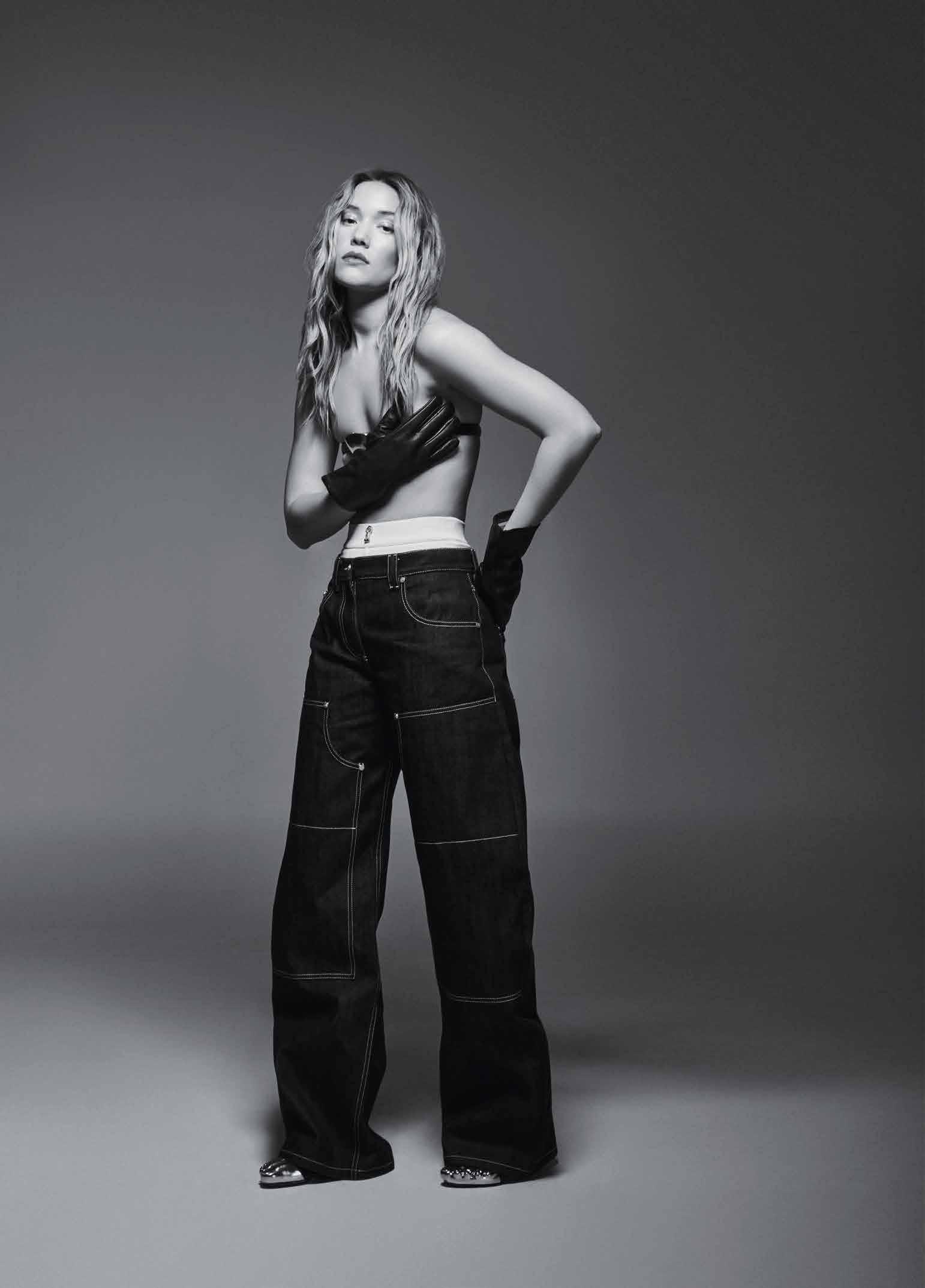
34 • RIVET
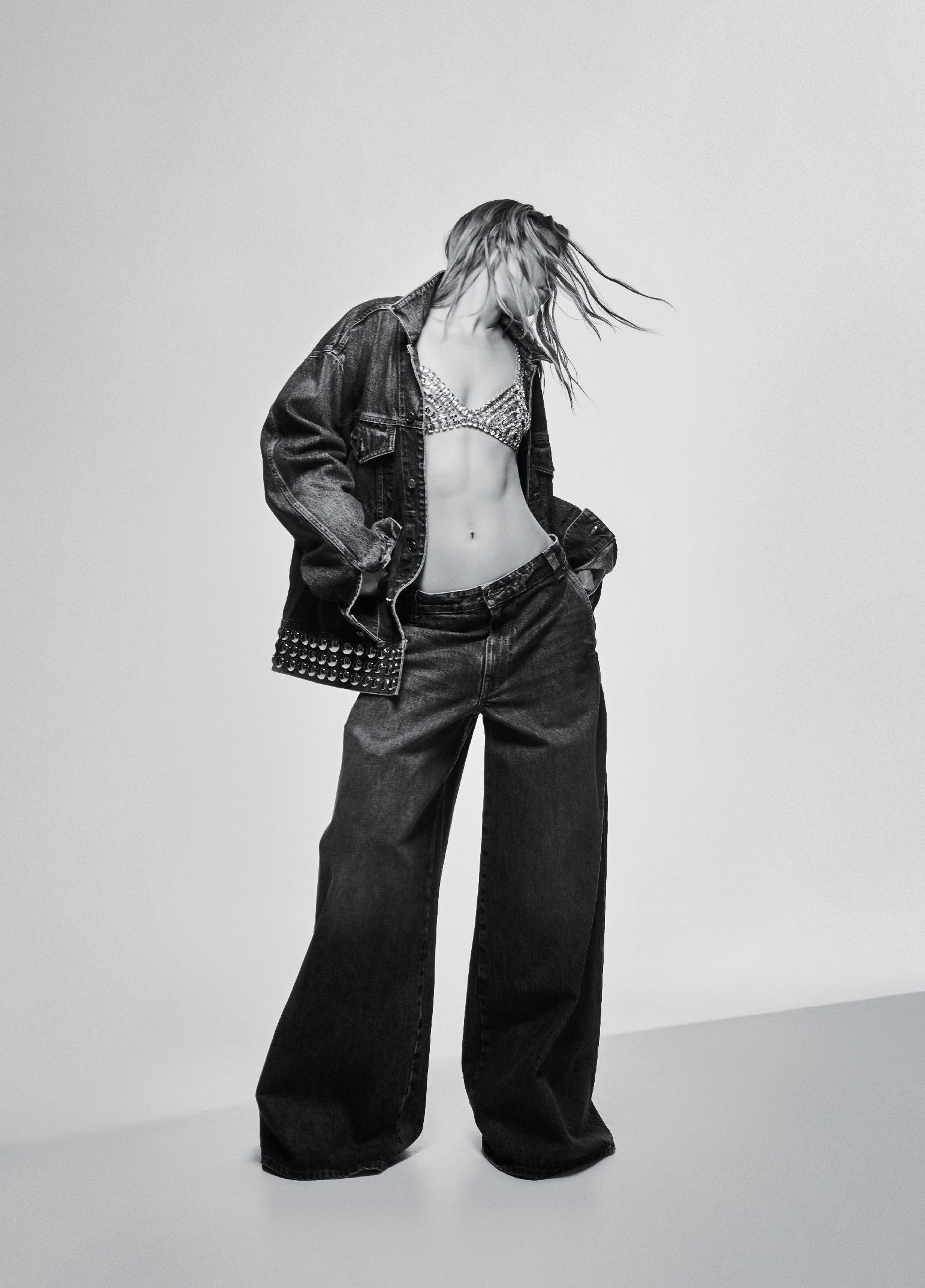
I
UNDERSTAND
RIVET 35
LOVE BEING ON THE BACKEND AND
WHY BRANDS ARE CHOOSING TO DO THIS VERSUS THAT...” ◄ SCHIAPARELLI JEANS, BOXERS AND BOOTS; 3.1 PHILLIP LIM BELT (WORN AS TOP); MISCREANTS GLOVES; CELESTE STARRE EARRINGS. ► KHAITE DENIM JACKET AND JEANS; NUE STUDIO GLASS RHINESTONE BRA.
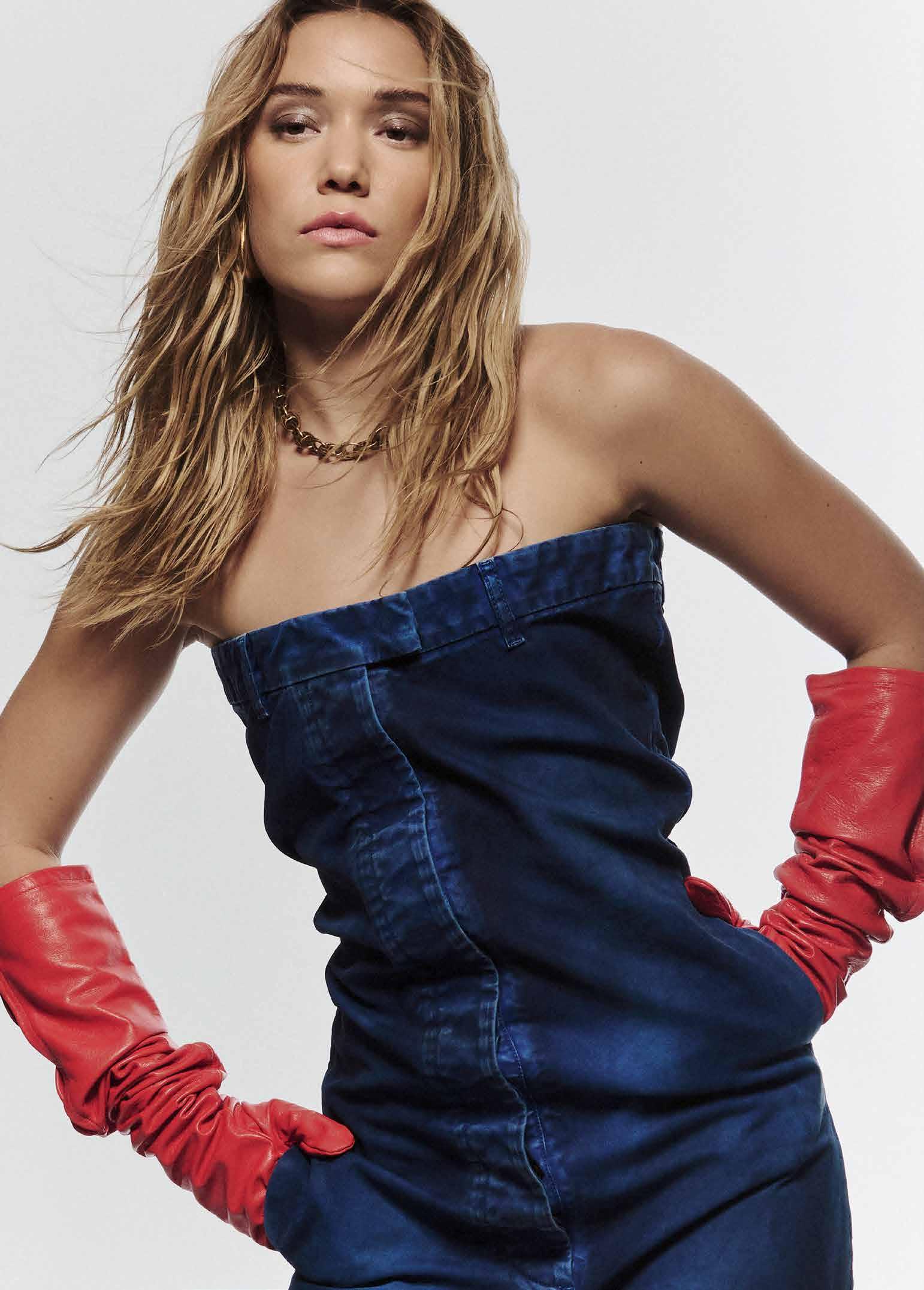
36 • RIVET
◄ THE ATTICO JUMPSUIT; MISCREANTS GLOVES; KHAITE NECKLACE AND EARRINGS.
► GUCCI TOP, JEANS, BELT AND KITTEN HEELS; CALZEDONIA TIGHTS; MISCREANTS GLOVES.
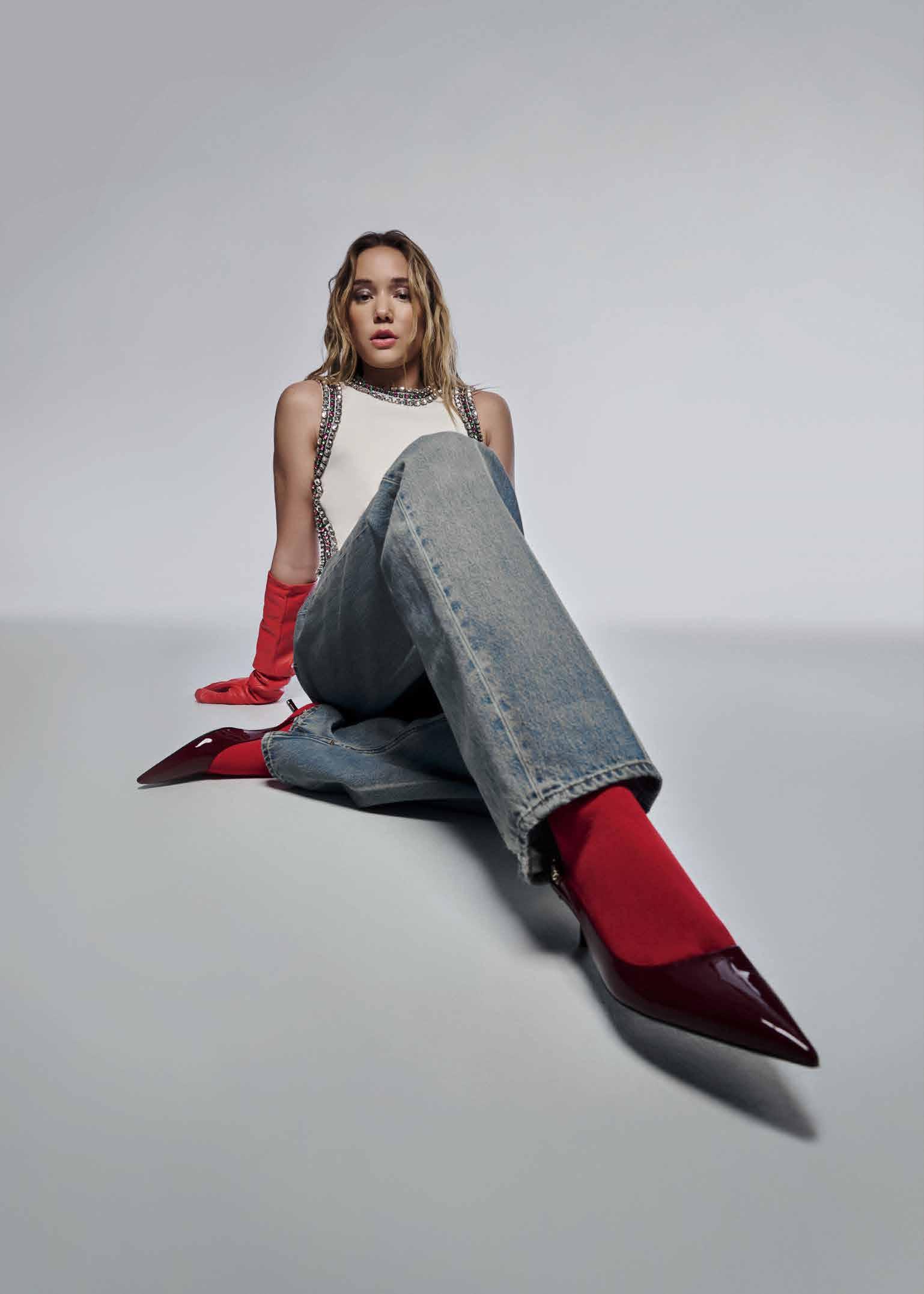
I DEFINITELY FELT A GROUP OF LOVING, APPRECIATIVE, AMAZING PEOPLE WERE THERE FOR ME. AND THAT’S WHAT I LIKE TO DO FOR OTHER PEOPLE WHEN THEY CHOOSE TO COME OUT.”
RIVET 37

38 • RIVET
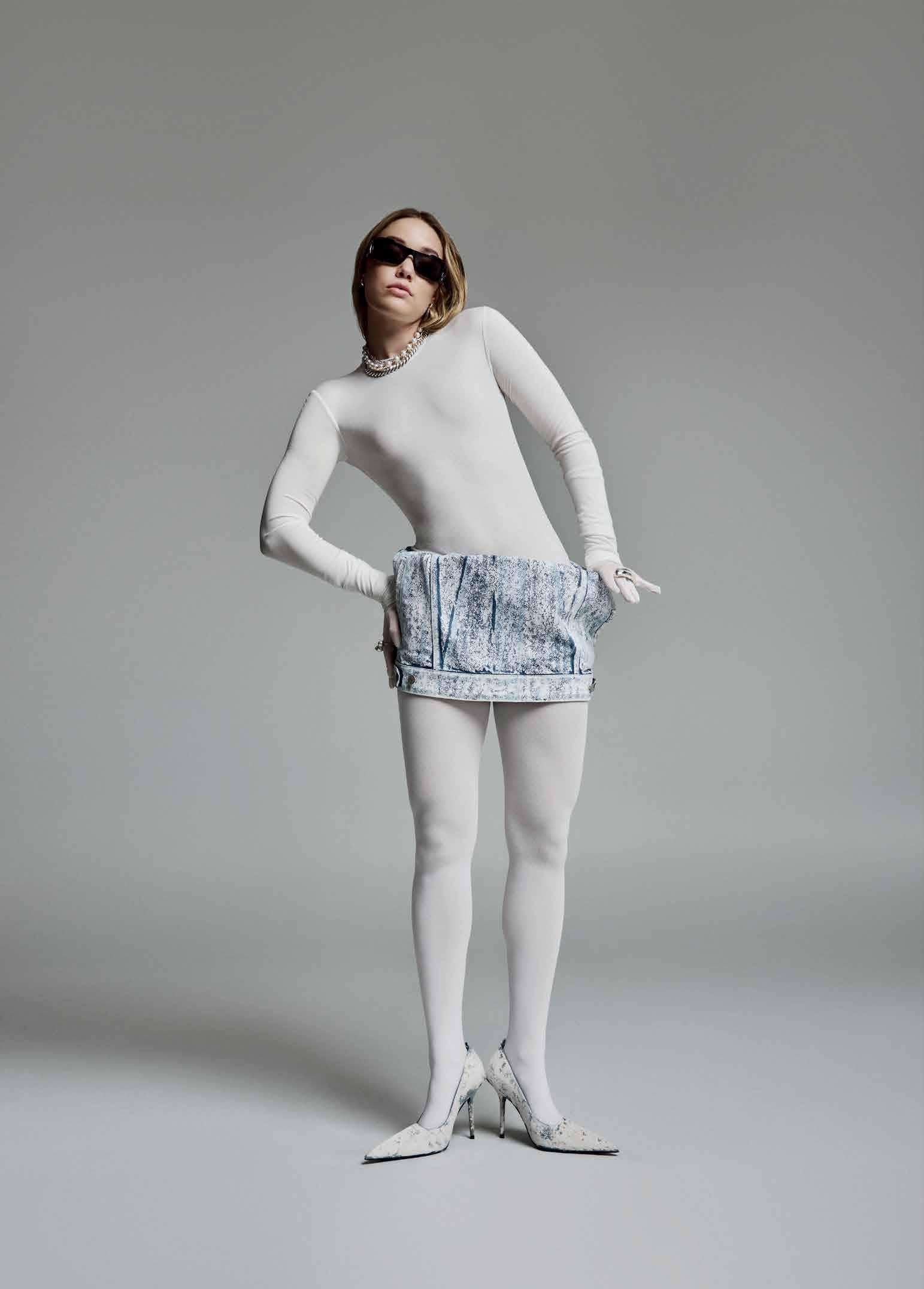
I NEED TO JUST BASK IN MY OWN IMAGINATION AND MY OWN WORLD AND MY OWN BRAIN.”
RIVET 39 ◄ COPERNI TULLE ILLUSION DENIM TOP; AREA EARRING. ► ACNE STUDIOS DRESS AND SHOES; VERSACE SUNGLASSES; CALZEDONIA TIGHTS; MISCREANTS GLOVES; DAVID YURMAN EARRINGS AND NECKLACES; LADY GREY NECKLACE; VERSACE RING; HERMÈS RING. CREW HAIR: REBEKAH CALO AT NEVERMIND AGENCY; MAKEUP: ALEX T AT ART DEPARTMENT; SR. MARKET EDITOR, ACCESSORIES: THOMAS WALLER ; MARKET EDITOR: EMILY MERCER ; FASHION ASSISTANTS: KIMBERLY INFANTE ARI STARK.
MUSIC NOTES
Fashion and music have influenced each other for decades, cultivating the most poignant cultural moments in symbiosis.
by Alex Badia & Emily Mercer
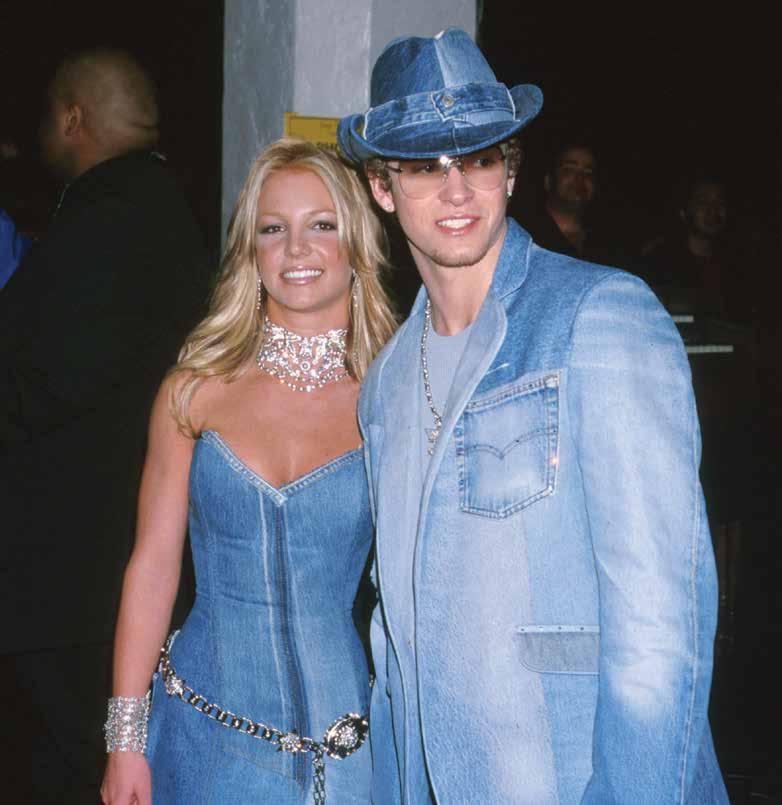
if music and fashion are at the crossroads of youth culture, then strong, gritty, sexy, rebellious, relatable denim is at the intersection.��������rom the relationship between The Sex Pistols and the late Dame Vivienne Westwood, which led to the punk movement in the 1970s and kindled a love for skinny jeans and DIY fashion in young people to pop princesses Britney Spears and Christina Aguilera making low-riding jeans a sartorial symbol of the Y2K era, musicians’ imprint on denim runs deep.
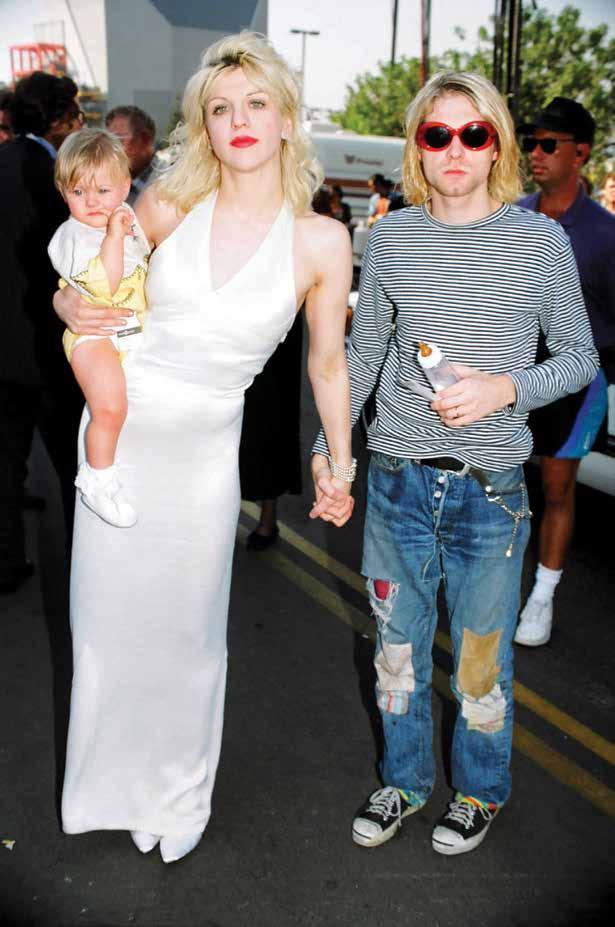
Denim’s ties to music are further evidenced through the decades by rock legends like Bruce Springsteen, who played to the everyman by donning worn-in Levi’s on his “Born in the U.S.A.” album in 1984, or by the patched and repaired jeans key to Kurt Cobain’s iconic grunge style. Off stage, Justin Timberlake and Britney Spears struck red carpet gold in 2001 when they matched in a Canadian tuxedo and denim gown. On stage, Beyoncé’s star shone even brighter in countless bedazzled denim looks throughout her 2023 “Renaissance Tour.”
Pharrell Williams’ appointment as Louis Vuitton men’s creative director last year introduced a new dimension in music and fashion’s relationship. The renaissance man has already leveraged the role as a platform for other musicians like Tyler, the Creator, to have a seat at the table.
“Denim has always had strong connections to culture, always dictating the fit of the times we live in, standing for a certain effortlessness and coolness, and now there seems to be a bigger desire to experiment more with denim in a fashion sense and expressing a certain boldness,” said Piotrek Panszczyk, cofounder of Area.
Beyoncé and Taylor Swift are among the musicians who wear the New York City-based brand’s embellished denim. Premium shopping app Lyst reported that searches for Area’s crystalembellished black jeans spiked 331 percent in less than 24 hours after Swift wore the jeans to the Super Bowl LVIII in January.
“I think fashion has been getting more pop, so people seem to be more interested in expressive treatments, embellishments, and ideas, versus only looking cool,” Panszczyk said. “So now at festivals and concerts, you really see people amping up the way they dress, often using denim as a vessel for this.”
Grunge and rock are frequent themes in R13’s collections. The brand’s Spring 2023 lookbook was even staged in an AI-generated version of Glastonbury.
“A musician’s fashion sense is amplified by their sound, strengthening their identity.
And authenticity resonates with the masses,” said Chris Leba, R13 founder.
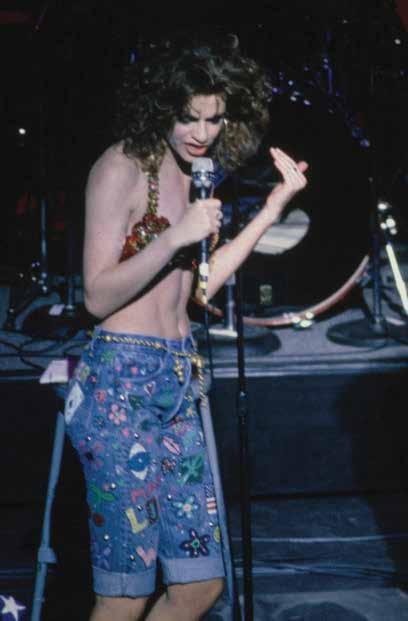
40 • RIVET
A MUSICIAN’S FASHION SENSE IS AMPLIFIED BY THEIR SOUND, STRENGTHENING THEIR IDENTITY.” Chris
Leba, R13
This has resulted in the past decade’s uptick of festival fashion and the success of brand deals at events like Coachella and Glastonbury. There were hits and misses along the way, but musicians’ access to custom and designer fashion for the stage is influencing how festivalgoers dress.
“At present, music and musicians continue to heavily influence fashion through personal styles showcased on stage and their social media channels,” said Christian Juul Nielsen, Aknvas creative director. “Their aesthetics often suggest vibes more than trends, which is inspiring to look at when designing.”
He isn’t the only designer inspired by the relationship and influence of celebrities throughout the design process. More than ever, musicians have become muses for fashion designers and houses, evident in the number of rappers and pop stars in front rows, campaigns, and sometimes on the runway.
Acne Studios tapped Spanish singer-songwriter Rosalía for its Fall 2022 campaign. Versace linked up with “Hoodini” singer Dua Lipa to co-design a vacation collection in 2023. Sam Smith made their catwalk debut at Vivienne Westwood’s Fall/Winter 24-25 show in Paris earlier this year.
Juul Nielsen added, “Denim is a cornerstone of the intersection between music and fashion. It’s a versatile fabric that has been used by musicians across various genres for decades. Denim’s rebellious yet timeless appeal perfectly complements the edgy aesthetic often associated with music culture.” ■
◄ ◄
Denim duo
Britney Spears and Justin Timberlake in 2001.
◄ Courtney Love and Kurt Cobain, dressed in DIY jeans, in 1994.
► Beyoncé favors embellished denim for the stage.
► Pharrell Williams elevates denim at Louis Vuitton.
▼ Sandra Bernhard and Madonna match in shorts 1989.
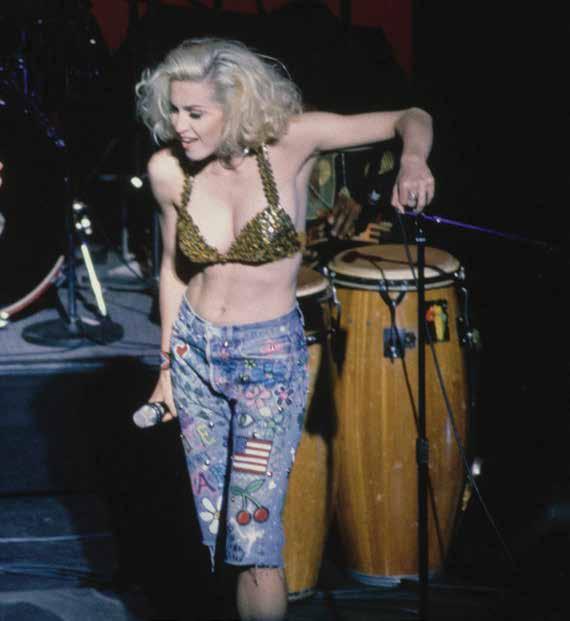

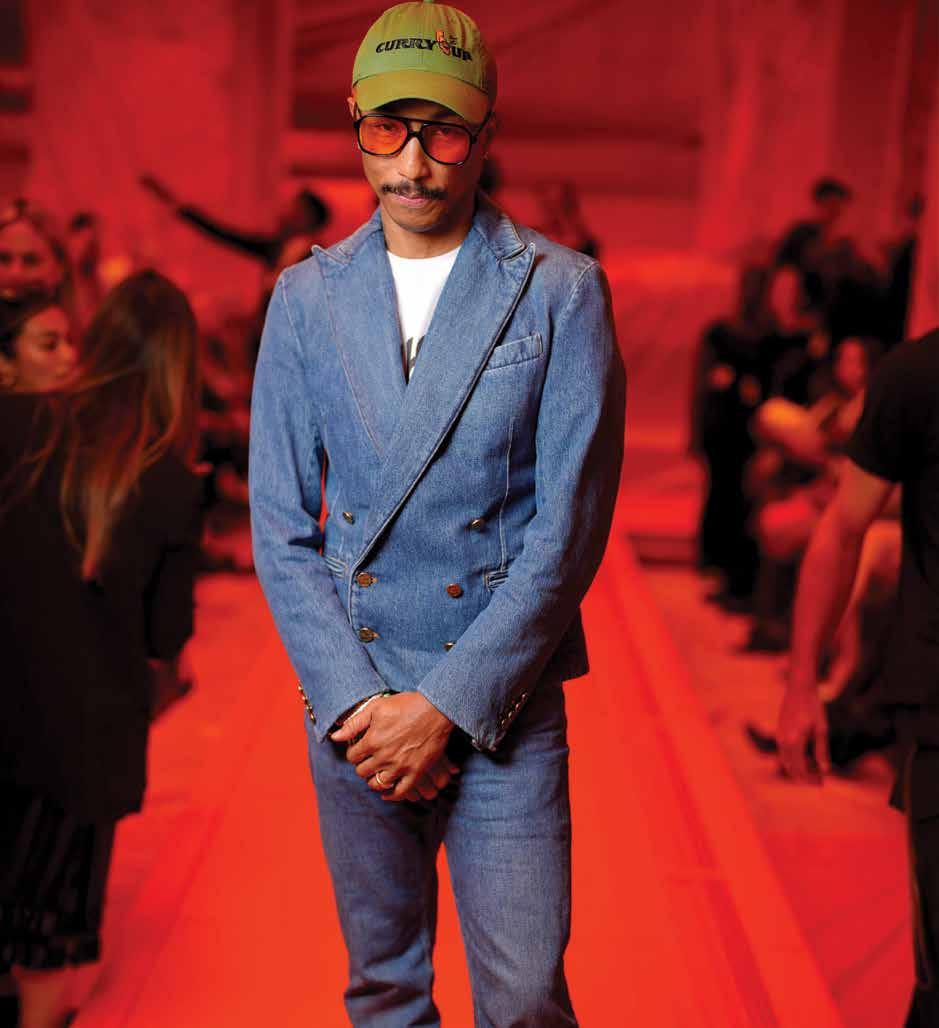
RIVET 41 CELEBRITY
PHOTOS: BRITNEY SPEARS AND JUSTIN TIMBERLAKE, COURTNEY LOVE AND KURT COBAIN, BEYONCE AND MADONNA: GETTY IMAGES; PHARRELL WILLIAMS: STEHANIE FEUGERE/WWD
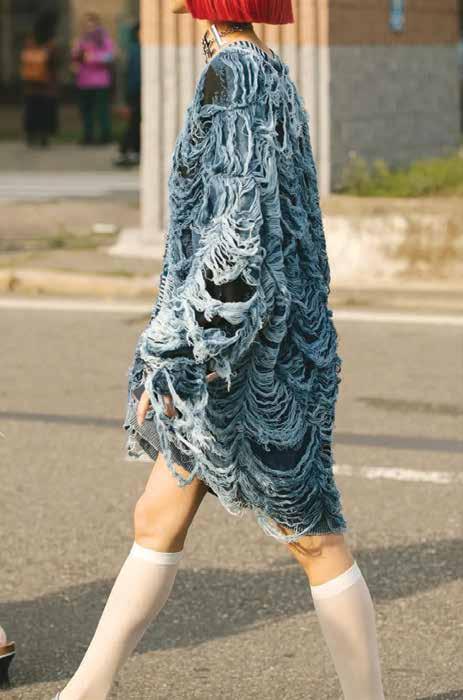
ON THE MEND
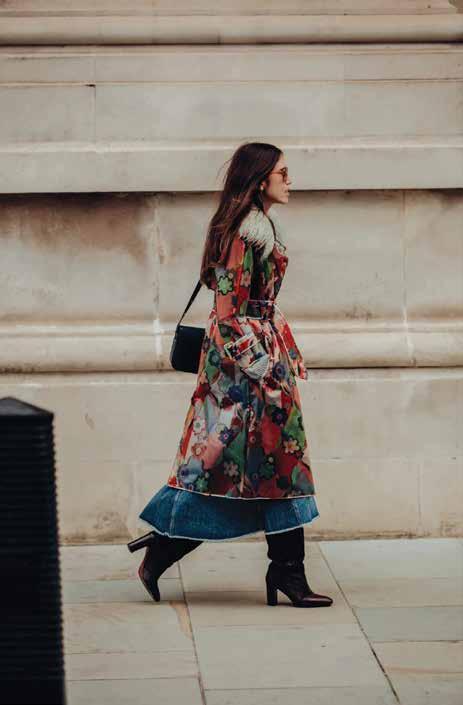
SKIRT THE ISSUE
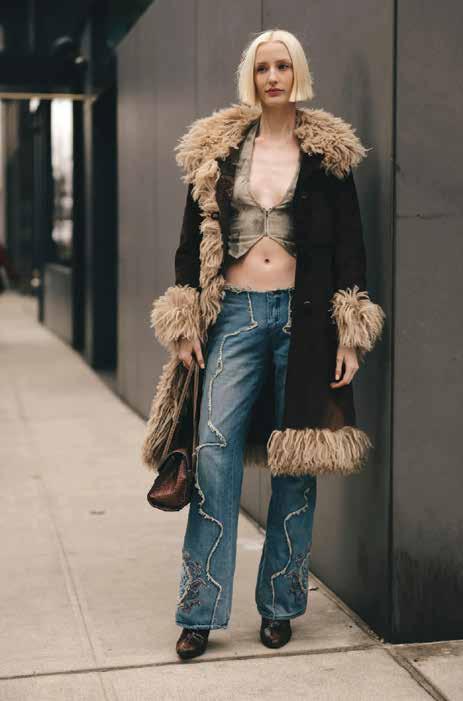
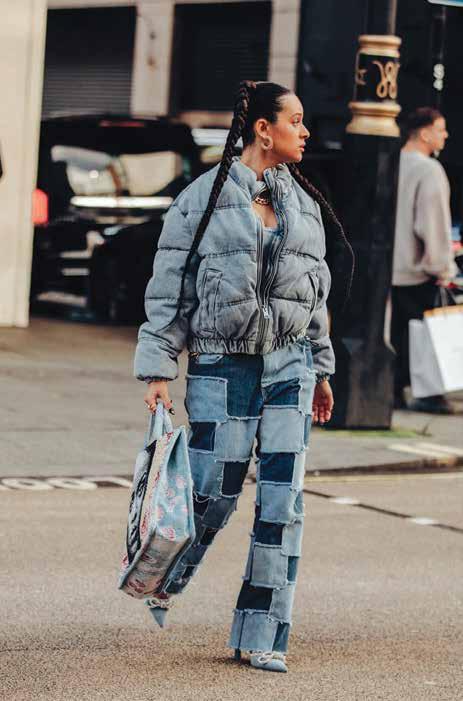

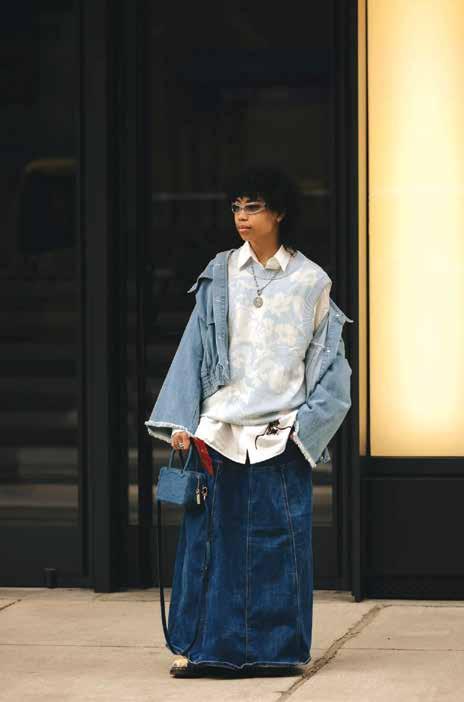
42 • RIVET ON THE MEND: NOORUNISA SOPHIE SAHARA, JONATHAN DANIEL PRYCE; SKIRT THE ISSUE: JONATHAN DANIEL PRYCE, NOORUNISA, SOPHIE SAHARA;
UNIVERSAL
Denim trends bubble up from the street, so where better to scout what’s next than from the street style during majorl fashion weeks.
Craft details like patchwork and raw edges gave denim an artistic, heirloom look.
Denim skirts are reinvented with maxi lengths, volume and tinted washes.

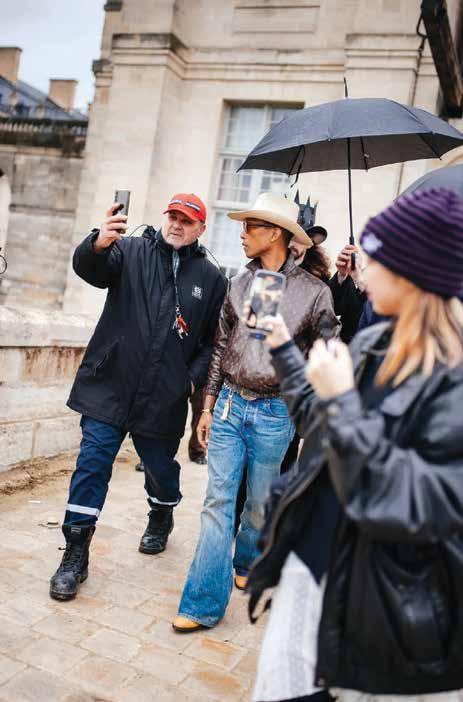
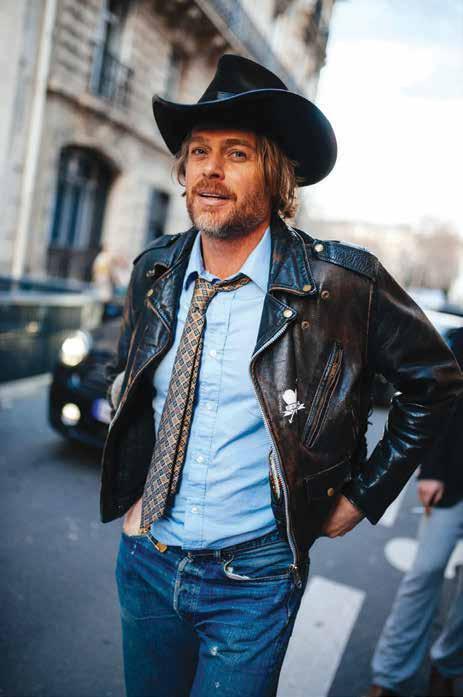
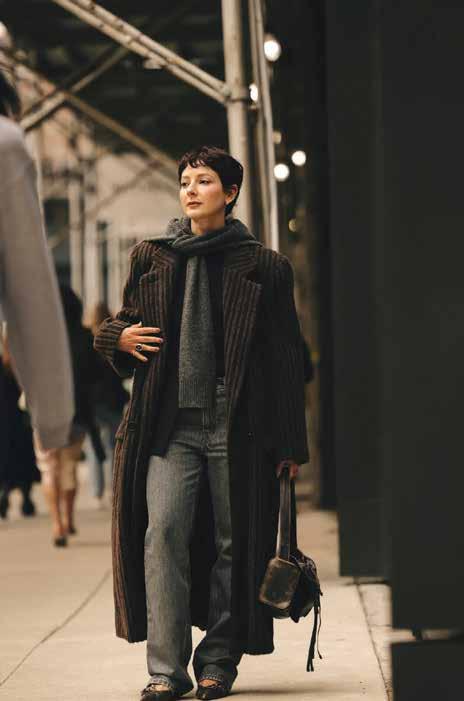
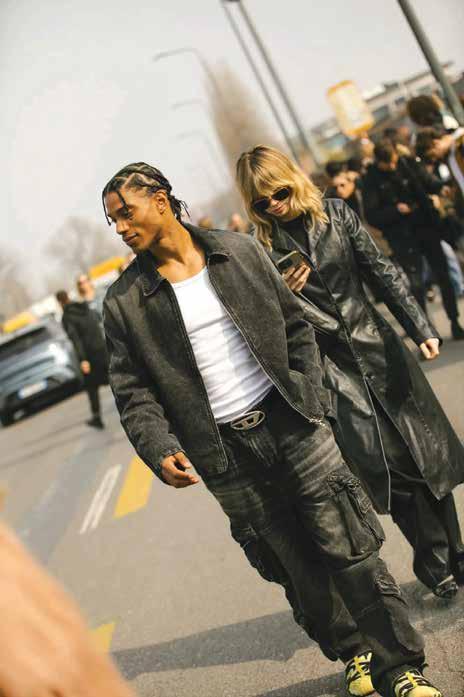
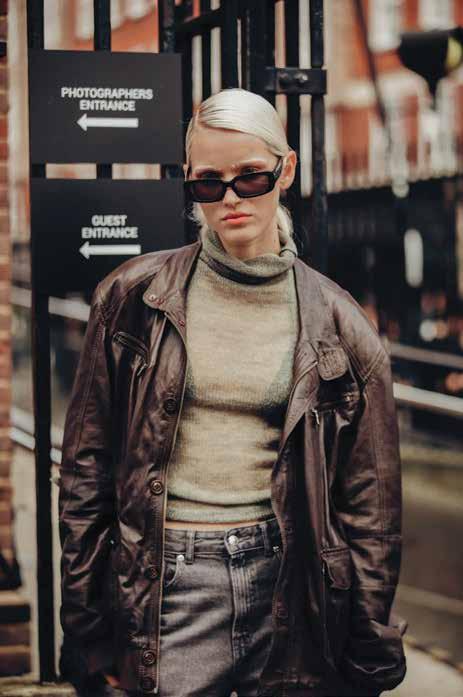
RIVET 43 COWBOYCORE:
STREET SMART UNIVERSAL
COWBOYCORE
NOORUNISA, KUBA DABROWSKI, KUBA DABROWSKI; GRAY DAYS: SOPHIE SAHARA, NOORUNISA, JONATHAN DANIEL PRYCE
LANGUAGE
GRAY
Tastemakers are in their country era with rough-and-ready styles to complement their cowboy hats.
DAYS Gray and washed black denim usurped blue as the must-have color on the street.
From London to Milan, the Fall 2024 season proved, yet again, that denim dressing is one of the few leitmotifs of street style. by Ari Stark
BABY BLUE
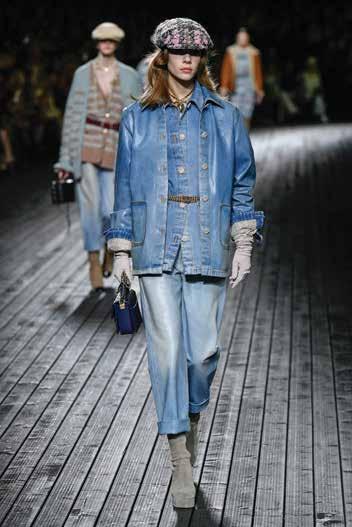
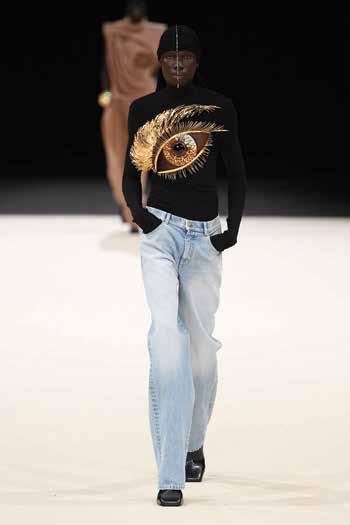
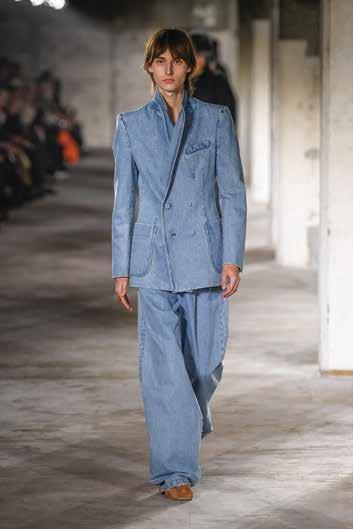

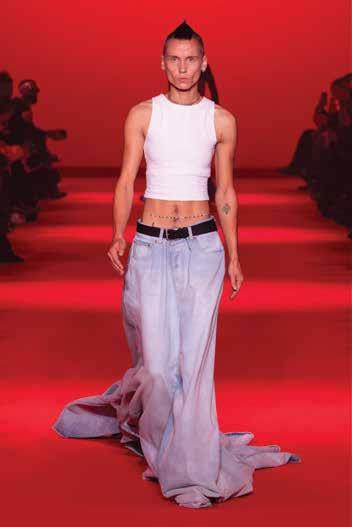
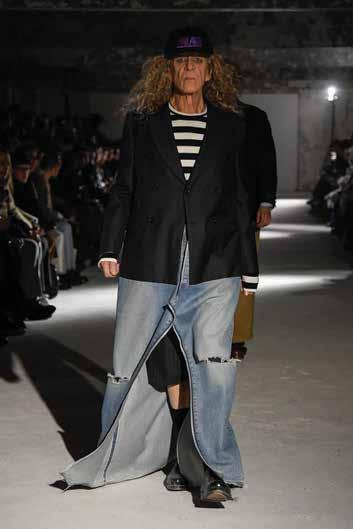
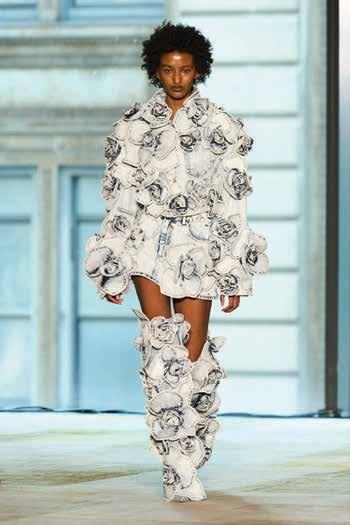

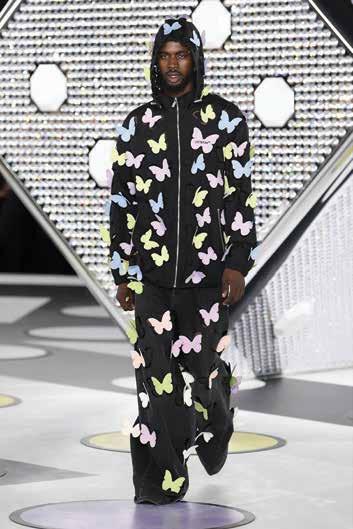
44 • RIVET
FROM THE Serious coats, light washes and loose fits walked the Fall/Winter 24-25 runway.
Designers are swapping brash Y2K washes
clear and bright indigo shades.
are
length
denim
EMBELLISHED Western embroidery and 3D appliqiués decorate men's and women's denim coordinates. GABRIELA HEARST OFF WHITE BALMAIN JUNYA WATANABE AKNVAS CHANEL VETEMENTS LOUIS VUITTON DRIES VAN NOTEN
for
SKIRTS Not your basic maxi, designers
adding drama and
to
skirts.
by Alex Badia


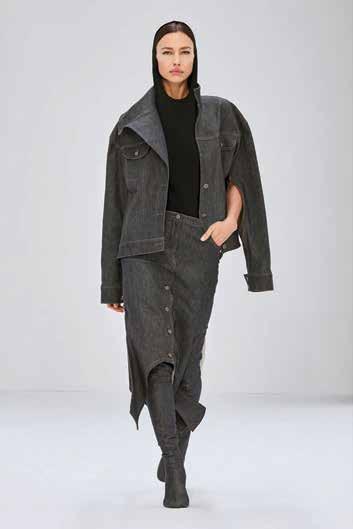
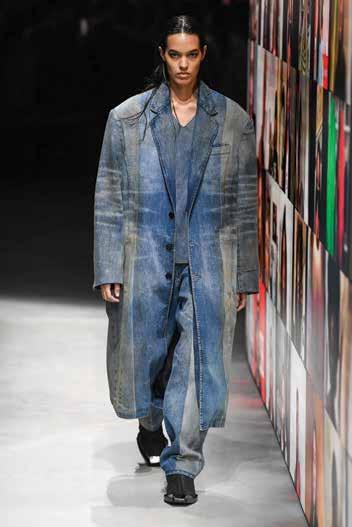


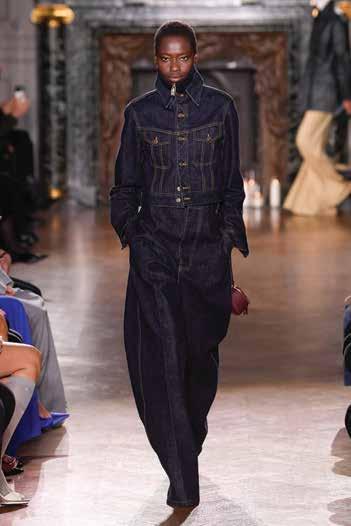


RIVET 45
RUNWAY
GRAY Softer than
brings a new dimension to
Long coats are the perfect
for
and intense
SLOUCH Relaxed and loose fits instantly add a cool and laidback vibe to
DIESEL COURREGES VICTORIA BECKHAM VAQUERA ACNE STUDIOS STELLA M c CARTNEY GUCCI VIVIENNE TAM FASHION GABRIELA HEARST
black, edgier than indigo, gray
denim. COATS
canvas
quilting, coatings
washes.
jeans.
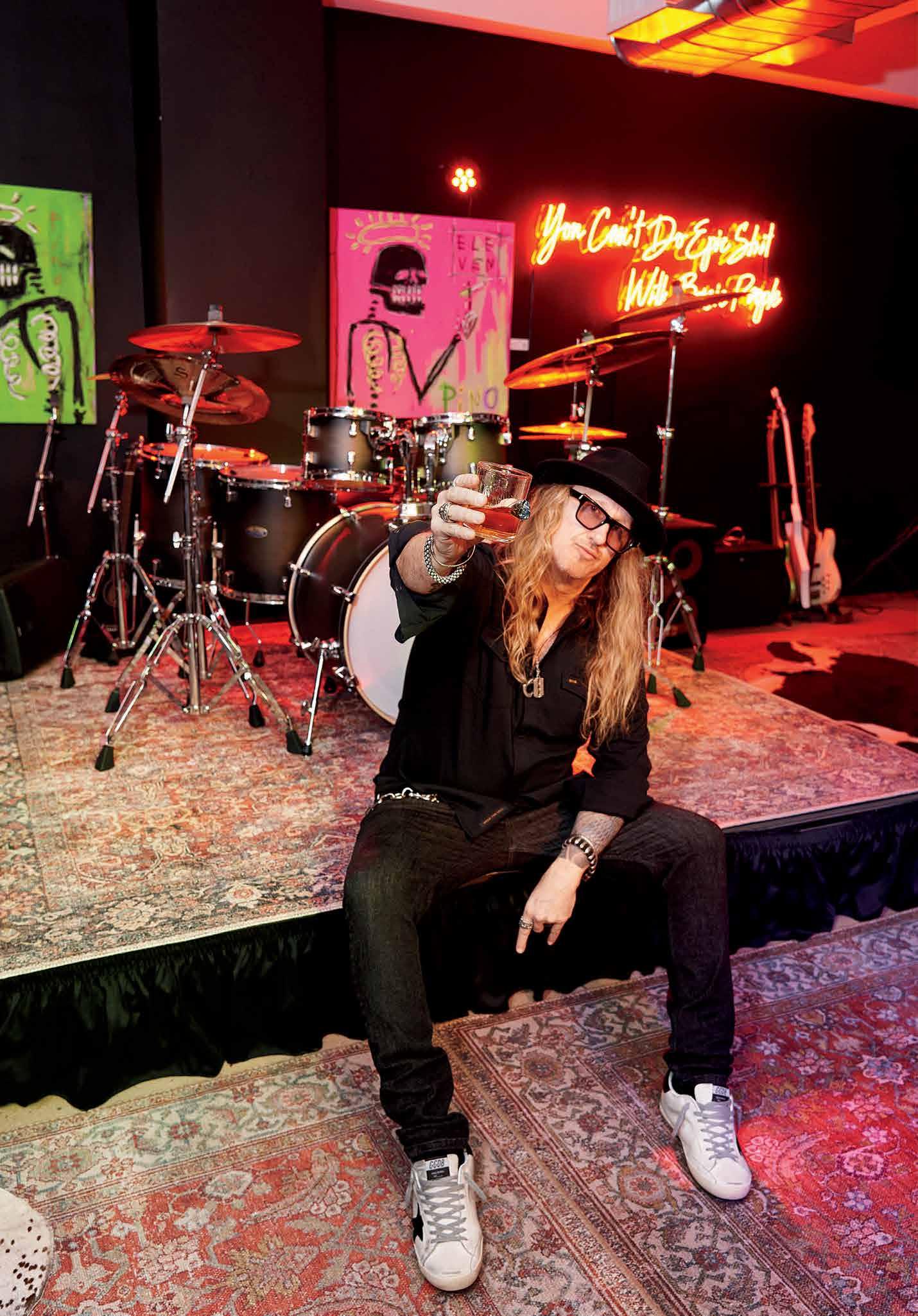
PHOTOGRAPHS BY GEORGE CHINSEE
CULT PHENOM
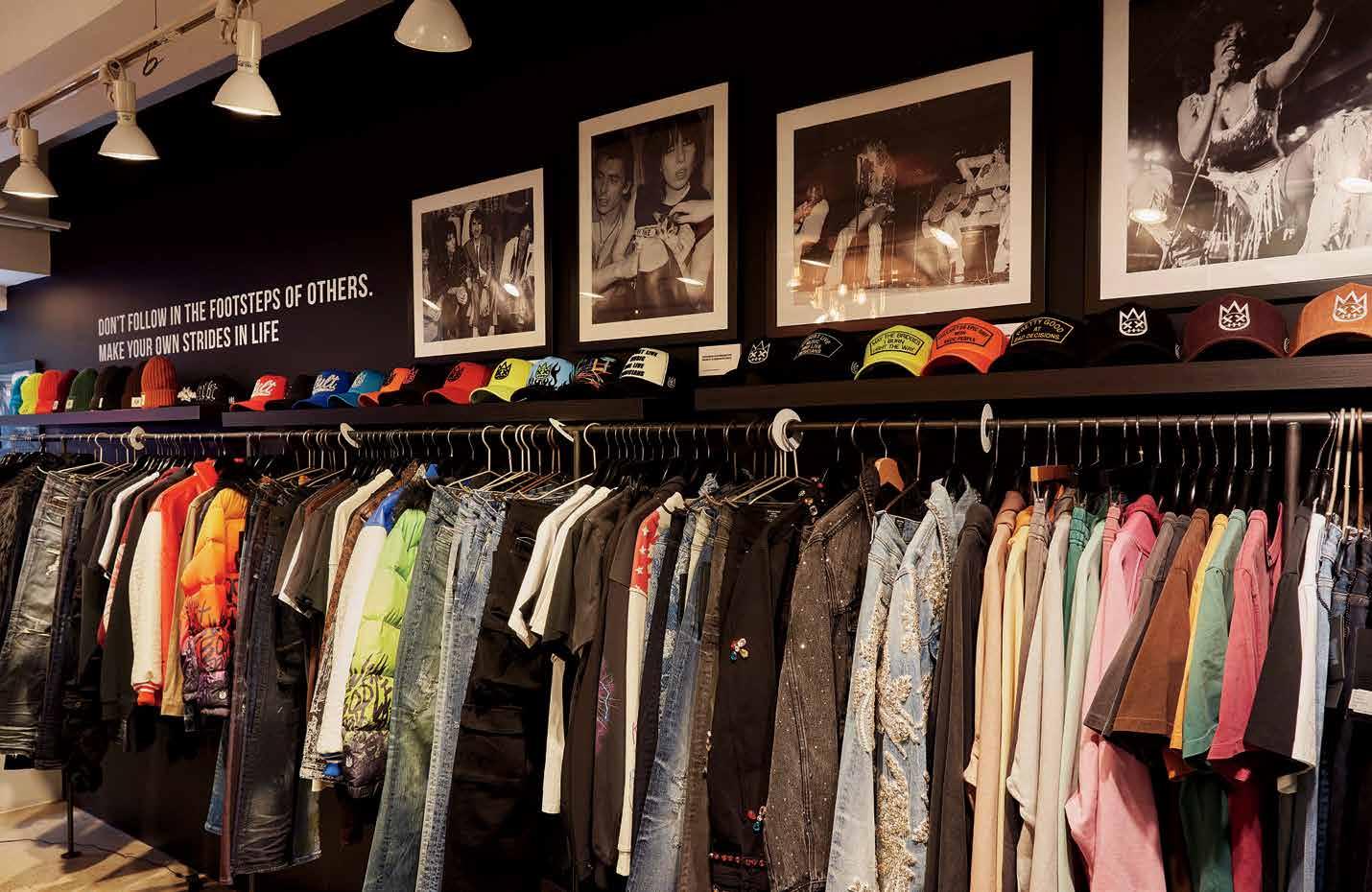
on a mild early february thursday afternoon , Cult of Individuality’s Garment District showroom thrummed with creative energy. Talent from polar ends of the musical spectrum rifled through racks packed with crystal-blinged denim, bleached-out shredded jeans, studded leather jackets, and logo-heavy streetwear blaring in big block letters, HVMAN, the brand’s younger, streetsavvier sibling. → Onetime Vogue model and CFDA New York Fashion Week ambassador Young Paris, a rising afrobeat singer/songwriter clad in cowboy attire complete with a ten-gallon Stetson hat, sized up Cult’s hot-off-the-assembly-line arrivals. Eric Vanlerberghe and Dylan Menoian of Grammy-nominated Detroit rap- and punk-minded metal band I Prevail stayed true to their rocker roots. The respective lead singer and guitarist each picked out standard-issue stretchy black skinny jeans to wear that evening when the five-member group—whose platinum-certified cover of Taylor Swift’s “Blank Space” shot them to fame nearly a decade ago—thrilled hundreds of metal fans gathered at Manhattan’s historic Gramercy Theatre.
→ Ron Poisson wouldn’t have it any other way.
▲ Inside Cult of Individuality's New York City showroom.
◄ Cult of Individualty co-founder Ron Poisson.
A vocalist and rock aficionado himself, Poisson and two co-founders hatched Cult of Individuality during the Great Recession of 2008, right when the economy “bottomed out” and yanked retail on a rollercoaster ride. Despite the seemingly inauspicious start, launching with $145 price tags when “$200 was an expensive pair of jeans” helped Cult penetrate stores that wouldn’t otherwise have entertained an unproven upstart, all but guaranteeing wholesalers up to triple their typical margin, said Poisson, the private company’s owner and creative director.
Taking style cues from “fashion-forward” European brands like Miss Sixty and Diesel, Cult steadily secured a place for itself in premium department stores and higher-end boutiques, turning organic word of mouth into valuable hype among cultural insiders. Poisson envisioned Cult as a vintage-minded brand
RIVET 47 VOICES
Ron Poisson shares how denim-rooted Cult of Individuality stays close to the culture. by Jessica Binns
with a little rebellious, antiestablishment edge sprinkled in for good measure.
“Denim is a cult phenomenon, and it’s also that individual expression of who you are,” he said. “You and I could wear the same jeans in dark blue or black, but how we merchandise that is [unique]. I love denim as a canvas, and to me, denim is a backbone of American fashion. I mean, everybody wears jeans.”
LOGO MANIA
Poisson admits the journey wasn’t always smooth sailing, but the imprint’s modest genesis— starting with just eight men’s relaxed and bootcut jeans— blossomed into a streetwear tour de force known for collabs with Bob Marley, the Sex Pistols, Public Enemy and other marquee icons of music and culture. Cult’s denim prices now sit in the “not inexpensive” $200-$300 range. That’s nowhere near the heady heights of a Balmain or a Gucci, Poisson said, but it’s well above the easily accessible, mass-market territory.
The creative maven believes Cult of Individuality’s logo—nodding to Jean Michel Basquiat’s famous crown—ignited the brand’s mojo when the insignia emerged some five or six years ago. “It took us a long time to come up with that logo for something that embodies and symbolizes the brand without having to say Cult of Individuality, you know, because that's a mouthful,” Poisson said. With the logo emblazoned on everything from hats to hoodies, consumers started buying into the brand without even knowing it, cementing the label’s appeal with the countercultural crowd, he added.
Cult of Individuality is seeing notable growth in China, a fashionloving market where logos just won’t quit. “We’re working very hard because the logo has really resonated in the Asian community,” Poisson said. He’s keeping a close eye on Douyin, the ByteDanceowned Chinese social app akin to QVC “on steroids” where influencers hawk products in a round-the-clock online shopping marathon. America, he said, needs a little of this livestream magic to jolt flagging store sales.
The company created a little magic of its own during the pandemic, renegotiating its headquarters lease to add more space and build a performance stage where artists joined the then-new Cult Sessions podcast in free-flowing, “friend-to-friend” conversations that engaged listeners unmoored from their typical daily routines. Sales continued apace, said Poisson of the popup podcast’s impact. Cult’s lone Los Angeles warehouse continued to ship orders during shutdowns while retail partners
kept the “back door open” to fulfill digital demand.
Today, Cult keeps that musical momentum alive, hosting album release parties and other exclusive events once or twice a month inside the intimate showroom, where tufted leather sofas nestled at stage left invite visitors to savor libations from the well-stocked bar just feet away. Poisson sees the space as a “destination” where artists alight for unplugged performances complementing their bigger New York shows, fueling a virtuous cycle that “continues to build around the brand.”
Inspired by the Covid boom in creativity, Poisson became lead singer in Tempest, a band formed with Evanescence drummer Will Hunt, and guitarists Chris Cain and Doc Coyle, and bassist Kyle Konkiel, all of Los Angeles heavy metal band Bad Wolves.
CONSISTENCY AND COLLABS
Cult wouldn’t have secured these external successes without the nitty-gritty operational work that goes into creating a culturally resonant brand with a time-hardened appeal. And that, said Poisson, begins with a manufacturing partner allied with the brand virtually from day one.
He credits much of the company’s achievement to his two-pronged co-founding team, a “passionate” denim expert who runs one of China’s biggest jeanswear factories and installed his supply chain-savvy niece to handle the logistics of shipping and receiving in Cult’s L.A. facility. This value chain integration helps Cult keep its foot on the gas pedal, trying new washes, finishes and silhouettes without compromising on a steadfast commitment to quality. The company has yet to have a shipment detained by U.S.
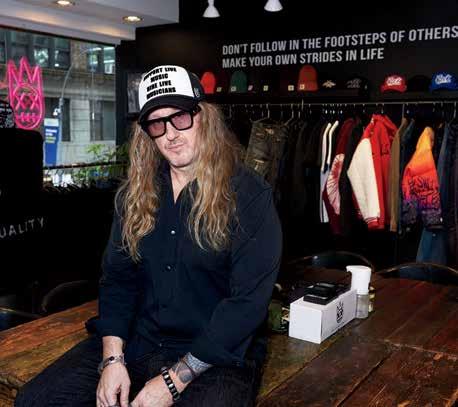
DENIM IS A BACKBONE OF AMERICAN FASHION.”
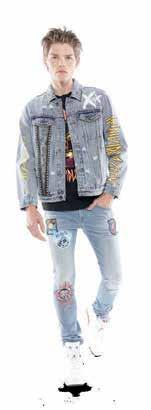
Customs and Border Protection, Poisson said, citing Cult’s history of sourcing Australian-grown cotton. Early on in his career, Poisson realized the vertical advantage of getting in bed with a denim producer, a move that has paid off.
relaunch the category this year, starting with a few styles at key Las Vegas trade fairs. But like so many similar growth-hungry brands, Cult set its sights on building a lifestyle empire beyond the boundaries of fashion.
“We want to push anything that has a logo on it. We want to penetrate your house,” Poisson said, rattling off skateboards, surf boards, slides, belts, keychains, underwear, sunglasses as product possibilities. Cult has already tried its hand at candles and cannabis paraphernalia, even Zippo lighters and umbrellas. “Look at Supreme,” Poisson said of the VF-owned label synonymous with street culture. “They sold a brick with their logo on it. That’s the power of branding and marketing.”
▼
Some 15 years since Day One, Cult sees an expansive future beyond its founding roots in denim. It sponsored the skate ramp at Project Las Vegas in February, “doubling down” in a bigger way on the skateboarding activation it backed at last year’s trade show, said Kyle Anglin, Cult’s vice president of sales and a veteran of Adidas and Lacoste. Cult is also kicking around a shoe collab that would “parlay into the position we’re taking into the skating community,” added Poisson, whose own footwear wardrobe consists of Golden Goose, Doc Martens, Converse and, of course, Vans—perhaps the ideal sneaker confederate for the brand’s grand ambitions.
And after pulling back on women’s denim—only available in Australia and New Zealand after other markets stalled— Cult believes the time is right to
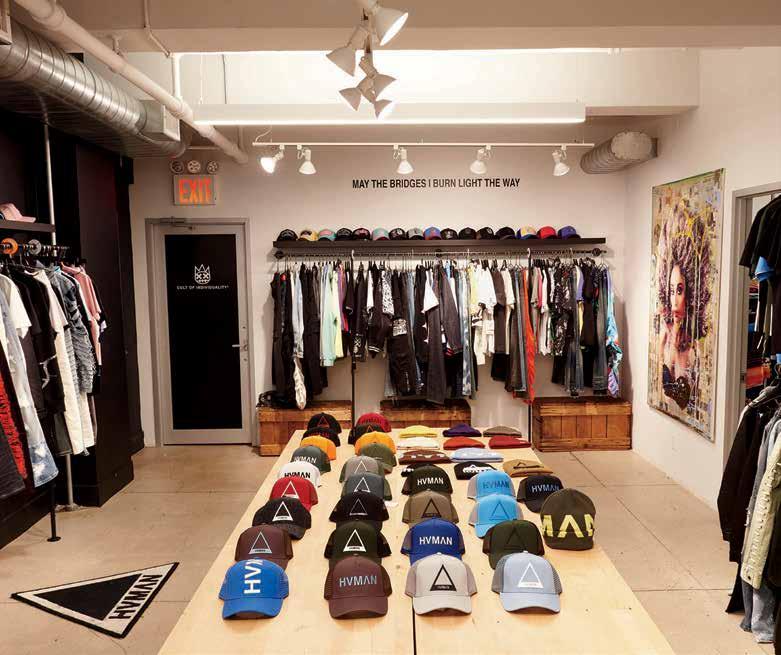
Poisson might have stars in his eyes, but Cult will never abandon its origins creating “silhouettes and fabrics for this musician that was out on stage.” That means oodles of novelty and crazy embellishments for the fashion “eccentric” who craves something different and can pony up $800 for a jacket or $600 for jeans.
“We’re pushing the envelope,” Poisson said, describing a new leather-like coated denim. “We spray coat the jean seven times, so it takes 24 hours every time you spray it. Let it sit there hanging in the laundry, dry, and the next day it’s sprayed again.” The factory hates this drawn-out process, he joked, but it’s worth it to clinch the right touch and feel.
Quality is at the core of what Cult is trying to do. That means using premium Lycra T400 yarns to create comfortable, high recovery stretch in popular skinny jeans. Or fusing velvet atop denim to create a suedey, velour type of fabric. Or sourcing selvedge denim from Japan. Or grinding and handsanding denim for a jacquard hand with a camouflage aesthetic. The list goes on and on.
Another way quality shows up is in how Cult authentically speaks to its core consumer—urbandwelling, Black and brown Gen Z guys who supply some 80 percent of the company’s sales. Employee headcount reflects Cult’s customer demographics, which sometimes helps to open doors in a way that Poisson might not, noted Ahmal Marsh, managing partner at Cult’s publicist, Slusa Productions.
Cult never wants to be a “copycat brand that doesn’t necessarily have a background or story attached to it,” Marsh said, describing the label as something bigger than simply where it’s distributed. “It’s really a culture—it’s DJs, it’s skaters, folks that are in tune and attached to our culture that goes above race,” he said, with music as the driving force that unites the brand community. “We can get lost in the sauce if we don’t align ourselves with partners who also speak to excellence,” Mash said. ■
48 • RIVET VOICES
Ron Poisson, Cult of Individuality
Cult's musical roots shine in collabs with Def Leopard, Bob Marley, Jimi Hendrix and more.
Cult's sister brand HVMAN is geared toward a young streetwear consumer.

Leading Denim Mill Based in the Americas
AB0VE & BEYOND
Malik Chua
steven bethell wears a lot of hats, both figuratively and literally. He founded Bank & Vogue with his wife, Helene Carter-Bethell, in the ’90s, working out of their basement in Ottawa in Ontario, Canada, to supply goods to the Salvation Army. Bank & Vogue has since become a giant in the used clothing circuit, spawning the Beyond Retro chain of vintage stores across Europe, plus the Beyond Retro Label and Beyond Remade lines of reconstructed outfits; collaborating with the likes of Converse and Lucy & Yak; and providing valuable grist for next-generation fiber producers such as Renewcell. Bethell is also rarely seen without one of his signature chapeaus, including a wide-brimmed, tall-crowned fedora that would bring Pharrell to tears. In this lightly edited conversation, he waxes lyrical about everything from beavers to Elon Musk to the perils of plus-size denim. But he also shares his razor-sharp insights into the future of resale, whether upcycling garments is worth the trouble, the time he almost came to (respectful) blows with Patagonia and where legislation will take the industry next.
Rivet: How did you get involved in the sorting, resale and recycling business?
Steven Bethell: I hate to be that guy, but I just love clothes. I just love them. I don’t know if you’ve ever read the book “Regeneration: Ending the Climate Crisis in One Generation” by Paul Hawken—I highly recommend it—but in it, he talks about keystone species being critical to building ecosystems. For example, when they shot all the wolves in Yellowstone Park, there was species collapse. And in Canada—being the Canadian guy—we have beavers. They go along a river, then they dam it and create a pond. That pond creates all kinds of new forms of life. And it’s a good analogy for our business at Bank & Vogue. We buy and sell containers of used clothes from 300 charities and private collectors across the United States, and in so doing, we create this ecosystem with new businesses like Beyond Retro and the upcycling work we do, for instance cutting the components and supplying much of the material for Converse’s upcycled Chuck Taylors. And being that beaver, we’re able to do this because we’ve got this scale of used clothes coming through our fingers.
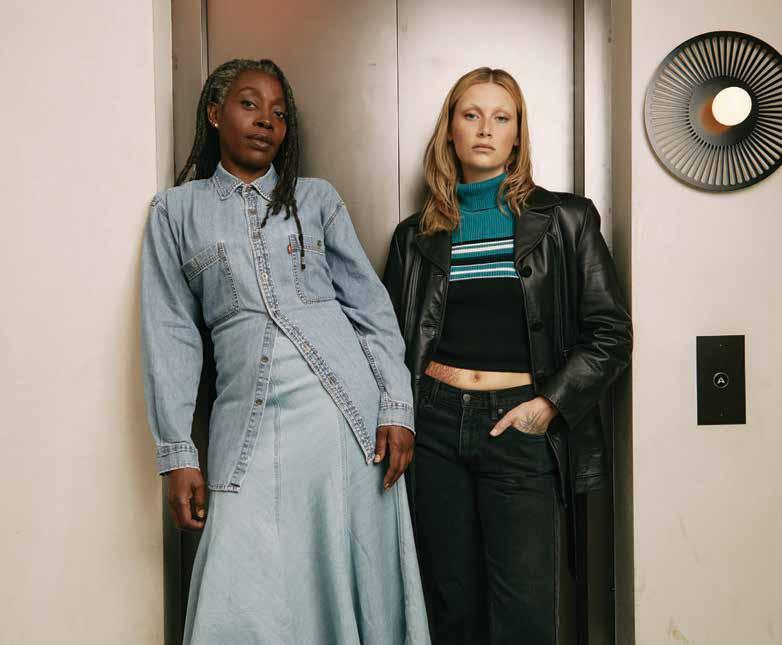
We’re firm believers that the best thing to do is resale, in terms of the value hierarchy. But then the next thing is, can you make something out of something that already exists? You think about how Americans buy 450 million pairs of jeans every year. On average, a garment lives about two-and-a-half years. It’s insane! So, when we get those garments,
why can’t we just make something else that didn’t exist? And that’s sort of our premise. But yeah, how did I get into it? It starts by loving the clothes and it starts by loving the scale of the business. We sell to 30 countries; we have offices in 10 countries around the world and that’s a lot of fun. It might not have been the right answer but there you go.
▲ Beyond
Label updates existing garments with light alterations.
Rivet: Beyond Remade, your spinoff upcycled brand, is over a year old now. You’ve created a very singular aesthetic, from patchwork denim jackets to recycled suede rucksacks. What was the unique selling proposition behind the concept and how does it mesh with Beyond Retro, which also has its in-house Beyond Retro Label of retweaked clothing?
SB: The joy of Beyond Retro is that we’re not only representing the trends through us, but we’re doing it at an accessible price point. Your average price is under 25 pounds ($31). The joy of that is also the problem of it when it comes to upcycling. We created Beyond Remade to demonstrate to brands that we could make a luxury item out of used [clothes]. We wanted to be able to lay that down in front of a brand and say, “Look, you can make something beautiful out of something that already has heritage.” And that moonshot goal of demonstrating this is what gave birth to Beyond Remade.
Beyond Retro and Beyond Remade have different price points but the price points reflect the amount of heavy lifting we did on, for instance, the construction of a jacket, which can take hundreds of hours. The products that we make for the Beyond Retro Label, a lot of it is what we refer to as “nip and tuck.” It’s light touches rather than the heavy lifting of upcycling. The factory where we do all our work is in Gujarat in northern India. My happy place is working in factories and making product. The fact that we’re doing it and not harming the planet, I think is really important. In fact, we’re regenerating material. And it’s harder to do at scale. It’s one thing to make a jacket. It’s how do you make 1,000 that’s the real trick. It’s a demonstration process to show brands. We have some other component work coming out this spring that demonstrates that.
I believe that the nature of sourcing garments or the materials going into them needs to be a circular one. So yes, the chemical recyclers for polyester are coming. Renewcell is here but struggling. An important message to get out is how do we imagine a low-carbon manufacturing economy? I think a low-carbon manufacturing economy is making things out of things that exist. But are brands
50 • RIVET
Steven Bethell, founder of Bank & Vogue and Beyond Retro, on the future of resale. by Jasmin
Retro
“WE
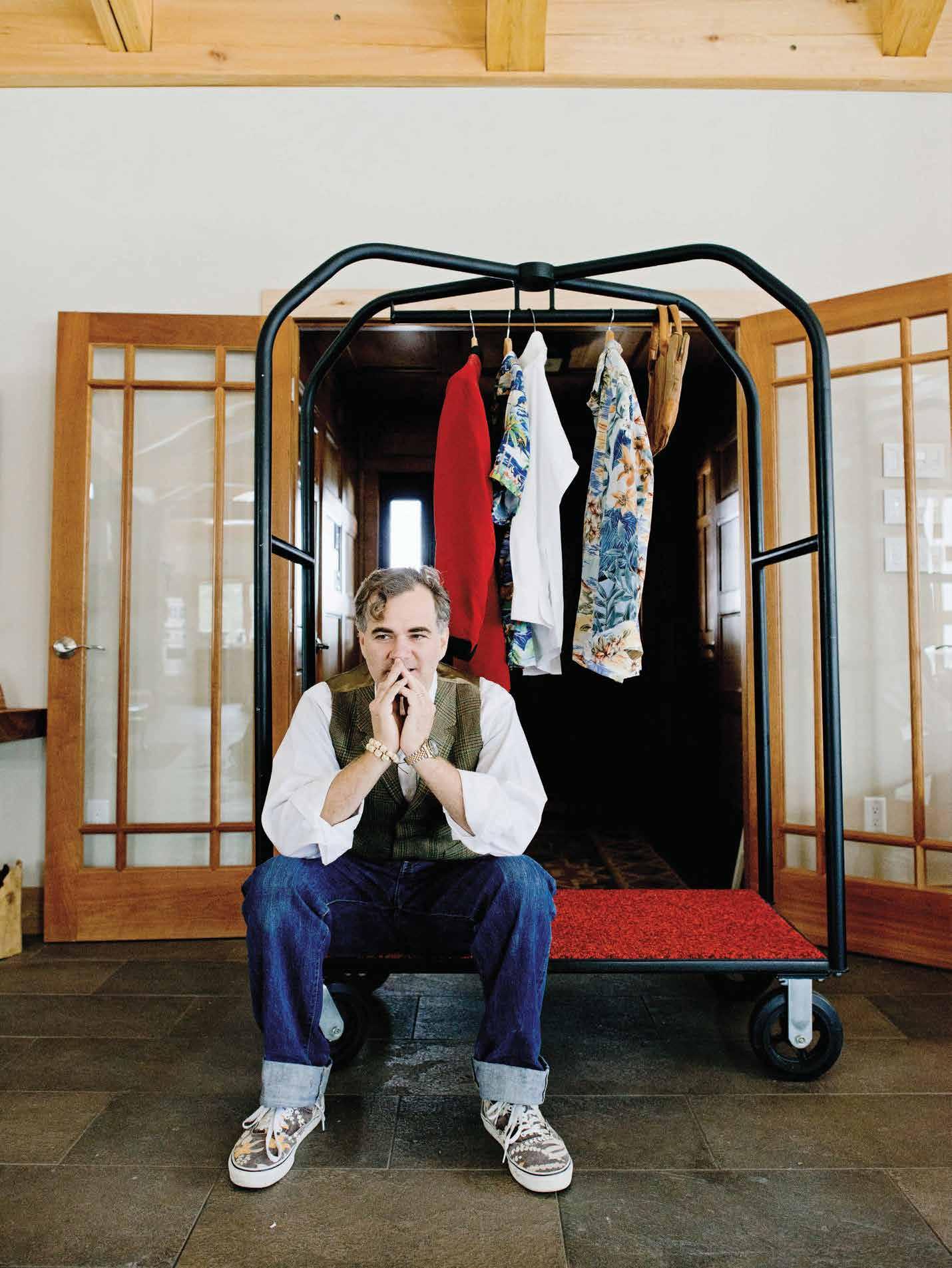
Q+A
NEED FANCY COMPUTERS TO BE ABLE TO SORT; WE NEED ELON MUSK TO GET INTO SORTING.” A love for clothing inspired Steven
Bethell's circular retail business.
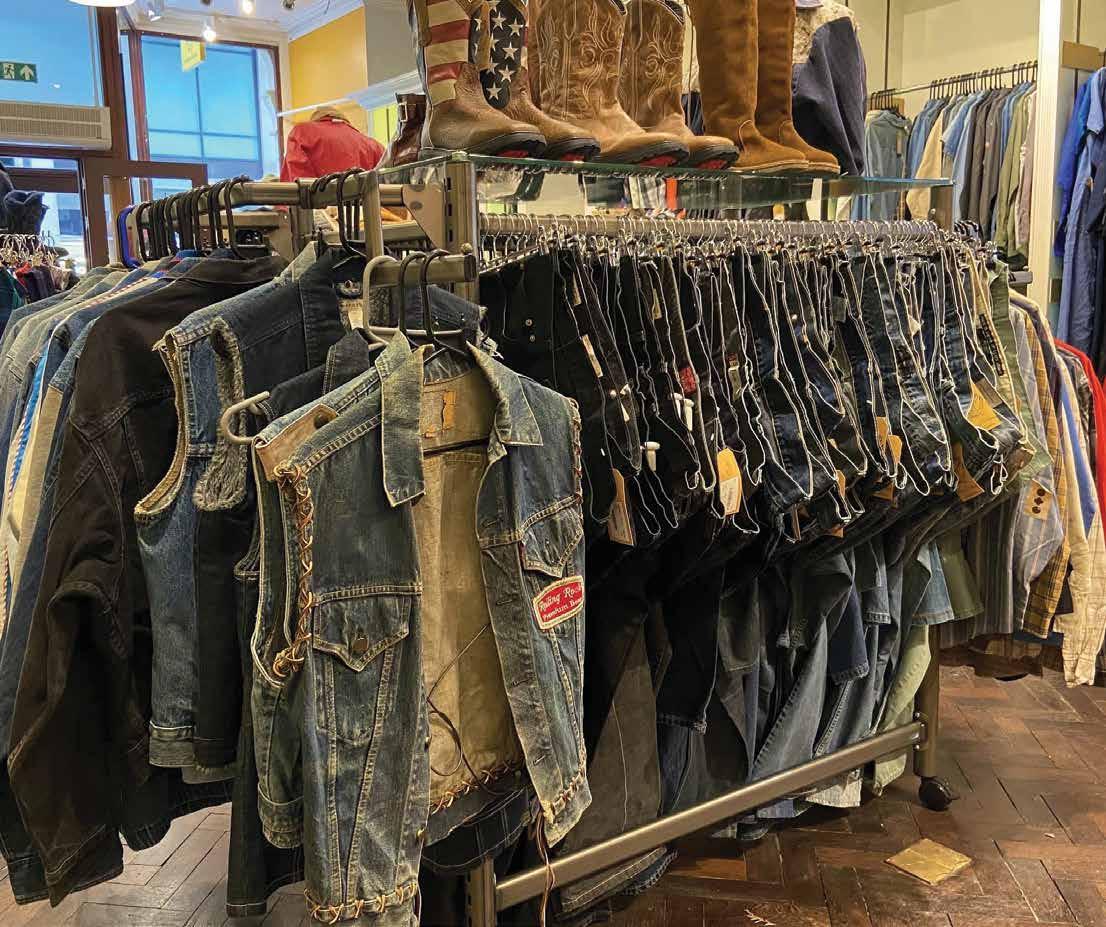
buying the material? That’s an honest conversation we need to have. Because clearly, the pioneers are struggling.
Rivet: You’re a partner with the Accelerating Circularity project, supplying much of the materials for its commercial-scale textileto-textile recycling trials. What have been your biggest learnings about how the industry needs to treat the end-of-life issue?
SB: It’s a bigger question than one would think. There was a panel at the GreenBiz summit in Seattle about how to take advantage of the secondhand boom, and the Patagonia person who leads their resale program said, “Look, we want to prevent things from going to the landfill. We want people to bring their stuff in.” And having been in the space for 25 years, I don’t believe that anybody who, pre-Patagonia’s resale platform, would have thrown their Patagonia jacket in the garbage. And I got up with 1,000 people in the room and said, “I’m not being diminutive to your program, or to your idea that you can make money on resale. But one must be somewhat aware of the consequences of brands like Patagonia taking the pixie dust out of the thrift stores and the Salvation Armys.” All those stores are going to be left with is Shein product and then their economic model will deteriorate.
There’s also a direct correlation between charitable and social enterprises like Goodwill and
DENIM IS ONE OF THE LOWEST-HANGING FRUITS: IT’S CELLULOSE-RICH AND HAS A LOT OF WEIGHT TO IT, BUT THE RESALE MARKET IS LIMITED, PARTICULARLY FOR THE OVERSIZED ITEMS.”
▲ Beyond Retro considers condition, fashion and size when it sorts secondhand clothing.
the Salvation Army and the help they give. The Salvation Army hands out sandwiches and socks; Goodwill helps get people back into the job community. I just challenged the panel in a very sincere way. What are you doing with an existing ecosystem?
So, there’s one conversation about resale as the first step in the circularity journey. The other is are brands willing to pay that green premium to recycle clothes that can’t be resold? We need fancy computers to be able to sort; we need Elon Musk to get into sorting. The work that Accelerating Circularity and all those people have demonstrated is that there’s a path to do that and certainly Renewcell’s demonstrated a path. My experience in this space so far is that the brands seem to have made public-facing promises, but the purchasing department and the merchandisers are not on the same page.
Rivet: With promoting circularity, where do you see the biggest gaps? Is it technological? Will?
SB: Technology’s not a barrier because Renewcell’s doing it. Sorting’s not a barrier because I’m sorting for Renewcell at scale. The
T-shirts, sweatshirts and towels, have an active wiper market. You can sell them for cleaning cloths and rags. But denim, after it’s gone through the resale options, you can’t use it as a cleaning cloth. We focus on denim because the afterlife options for denim are really limited.
And brace yourself, I’m going to make fun of Americans now. If we try to resell a pair of jeans in America and it doesn’t resell, it gets baled up and then it goes to a sorting plant where it’s sorted for reuse for the world market. The problem with Americans is that a lot of them are plus size, so a 38-, 40-, 42-inch-waist jean has a really limited world market. Denim is one of the lowest-hanging fruits: it’s cellulose-rich and has a lot of weight to it, but the resale market is limited, particularly for the oversized items.
We don’t sort clothes based only on condition. We sort based on fashion. For example, you can’t sell skinny jeans in a lot of reuse markets. They won’t buy them because who’s going to wear a pair of skinny jeans when it’s 100 degrees out? We sort for size. It’s learning about relevance: relevant shape, relevant size, relevant condition but also relevant style.
Rivet: Where do you see the used clothing business going next?
biggest gap is demand. My hobby— everyone has a weird hobby—is I have a regenerative farm. I have 200 acres; I’ve got 20,000 apple trees. But the first rule about farming is you need a customer. You can grow all the food you want but if no one’s going to buy your food, it’s just going to go to waste.
There are forward-thinking brands like Converse that say, “We need to figure this out because it’s going to end up there.” For those fast fashion guys who are trying to make their quarterly shareholders meeting as brief as possible, the only way you’re going to get them to do it is by legislating.
And legislation needs to say it’s not pre-consumer waste. We’re not going to sweep up the shit on the factory floor, put it back in the machine and call that recycling. They must own parts of the value chain taking the material after it’s gone through all of the resale options.
Rivet: Why do you focus on denim?
SB: There’s a rule in our world. Anyone can sell gold. It’s the guy who can sell the garbage who’s going to make money. Other cellulose-rich products like
SB: I genuinely believe that this is the zeitgeist moment in the used clothing business—not necessarily resale because that’s been around a long time, but the idea that used can be an input to new is an epic moment for the industry in its totality.
But this great opportunity, as an industry, comes with an enormous responsibility, and there are things [missing] in our trade, like transparency as an example, because as an industry have really operated in the dark.
At Bank & Vogue, we brought in a consultant who looked at our practices, including how we audit our suppliers for human rights compliance. He also brought in Emitwise to do a carbon analysis of our business because it’s one thing to say used is much better for the environment…let’s assume it’s 80 percent better, but we are still consuming 20 percent carbon over new sales. So we wanted to lay out what would a science-based target looks like for Bank & Vogue.
If I want to play on a tennis court against new virgin material manufacturers, I want to make claims that we are better. I also want to make the claim that we are not only better, but we’re also doing it at a level where we are a leader in transparency on human rights, on science-based targets on carbon. I think if you’re going to be in this space and you want to push the boundaries, you’ve got to push yourself as well.■
52 • RIVET Q+A ALL IMAGES COURTESY
MARITAŞ DENIM ON THE IMPACT OF DESIGN CHOICES
BBALANCING AESTHETICS and impact are at the core of Maritaş Denim’s design philosophy, as it recognizes the importance of creating visually appealing and functional spaces while ensuring longterm sustainability. Here, Fatih Kesim, deputy general manager of Maritaş Denim, explains how new sustainable/circularity ideas demand attention from the market, and why the company is constantly working on R&D and revising factory and technologies along sustainable adaptations.
RIVET: By carefully considering material sourcing, how can Maritaş Denim contribute to a more sustainable and equitably built environment?
FATIH KESIM: As of 2023, approximately 65 percent of our production quantity consists of sustainable fabrics. Our target is more and all. We create spaces that not only minimize environmental harm but also enhance the wellbeing of the people who use them. This philosophy is the main criteria of our collections and concepts: Terra Denim is our innovation by nature. Produced with zero chemicals/zero impact in the dyeing process, its unique chemical-free coloring uses natural techniques and materials such as clay and plants. Cycle-Fx is our sustainable, recyclable stretch technology with fibers that offer high elasticity and performance with excellent growth and recovery. Rejuvenate focuses on regenerative cotton products, as regenerative materials are a key part of climate strategies. Regenerative agricultural builds soil health, allowing it to sequester carbon from the atmosphere while also generating other ecological benefits such as increased water retention and soil biodiversity.
Neo Vintage is another sustainable line of authentic denim using TENCEL.
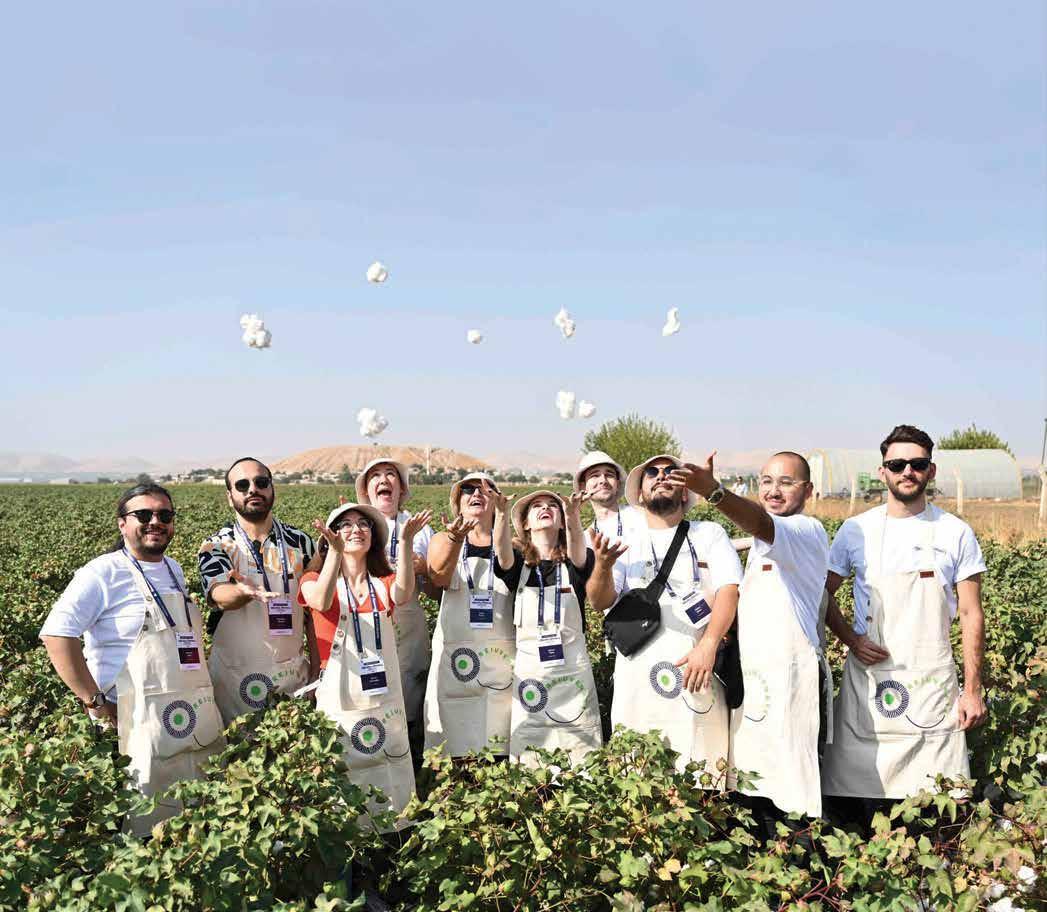

“THE DENIM MARKET MUST ADAPT TO NEW WEATHER AND BEHAVIORS.”
FATIH KESIM deputy general manager, Maritaş Denim
What progress has been made with Maritaş Denim’s recent regenerative cotton project in Harran?
F.K.: The project was prepared to support Maritaş Denim’s sustainable production policy, to contribute to the limited regenerative cotton fiber production studies in our country, national and international literature by conducting process analysis on regenerative cotton agriculture, to contribute to the development of basic principles for regenerative cotton fiber production, to obtain commercial data by examining the properties of regenerative and conventional cotton fiber and yarn and denim fabric produced using these fibers. We are proud to be featured in the Ellen MacArthur Foundation’s latest Insights Report on The Jeans Redesign (2021-2023). Our project has been
honored by the Ellen MacArthur Foundation as a lighthouse project to encourage other producers to switch to regenerative agriculture approaches.
Climate change not only affects seasons and crops, but impacts trends. What are some ways Maritaş Denim is creating product to appeal to the 2024 consumer in this new climate?
F.K.: Seasons are no longer set in stone as they used to be. With record temperatures around the globe, climate change-related disruptions such as warmer winters and longer summers will transform how we dress, and brand and retailer projections are getting harder. Production is also more
complex. Extreme weather impacts the whole supply chain. The denim market must adapt to new weather and behaviors. Maritaş Denim tries to transform denim fabric—keeping it authentic but adding softer and lighter constructions in our collections like Hi-Fly, Neo Vintage, etc. Sustainable-based fabrics and activations are certainly driving the narrative for many designers and brands.
What do you see as the innovation in the future of denim?
F.K.: In the face of climate change, resource depletion and shifting consumer expectations, mills and brands are increasingly coming under pressure to drive meaningful change and to back up their sustainability stories with facts. Especially the conscious and effective shopping habits of the new generation have pushed manufacturers in the industry to redefine “fashion.” Nowadays, we see more brands identify themselves as sustainable brands. But from my perspective, sustainability is a holistic approach that should be addressed from the raw materials to improvements in production processes, from the product life cycle to recycling, reuse, regenerate. I expect innovations mainly on these areas. ■
SJ X MARITAŞ DENIM
SUPPORT SYSTEM
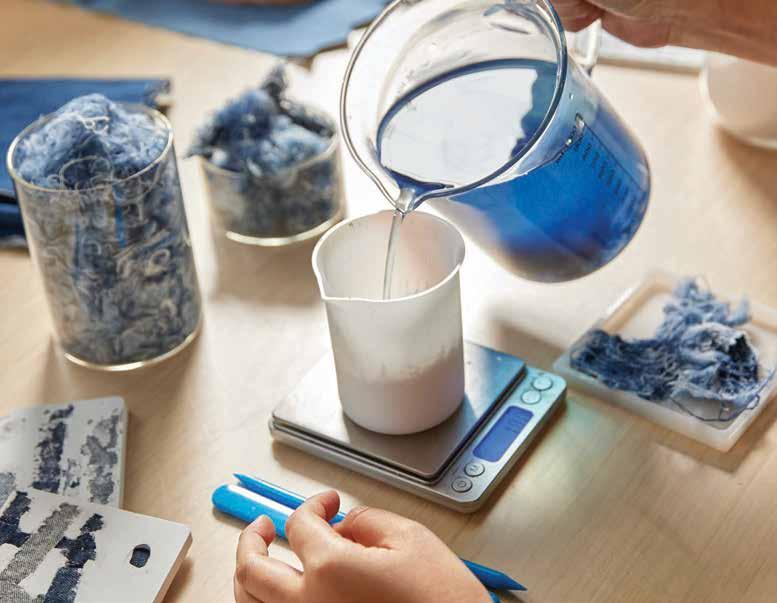
what once operated as a cotton spinning mill now stands as a beacon of innovation in an industry in desperate search of sustainable solutions.
The Mills Fabrica, which has headquarters in both Hong Kong and London, works with budding businesses interested in bringing more environmentally friendly options and outcomes to the fashion and apparel industry. It supports startups to elevate their business models and, consequently, the building blocks of a more sustainable future.
Cintia Nunes, general manager at The Mills Fabrica, said the venture capital fund and incubator has a multitiered strategy toward working with startups.
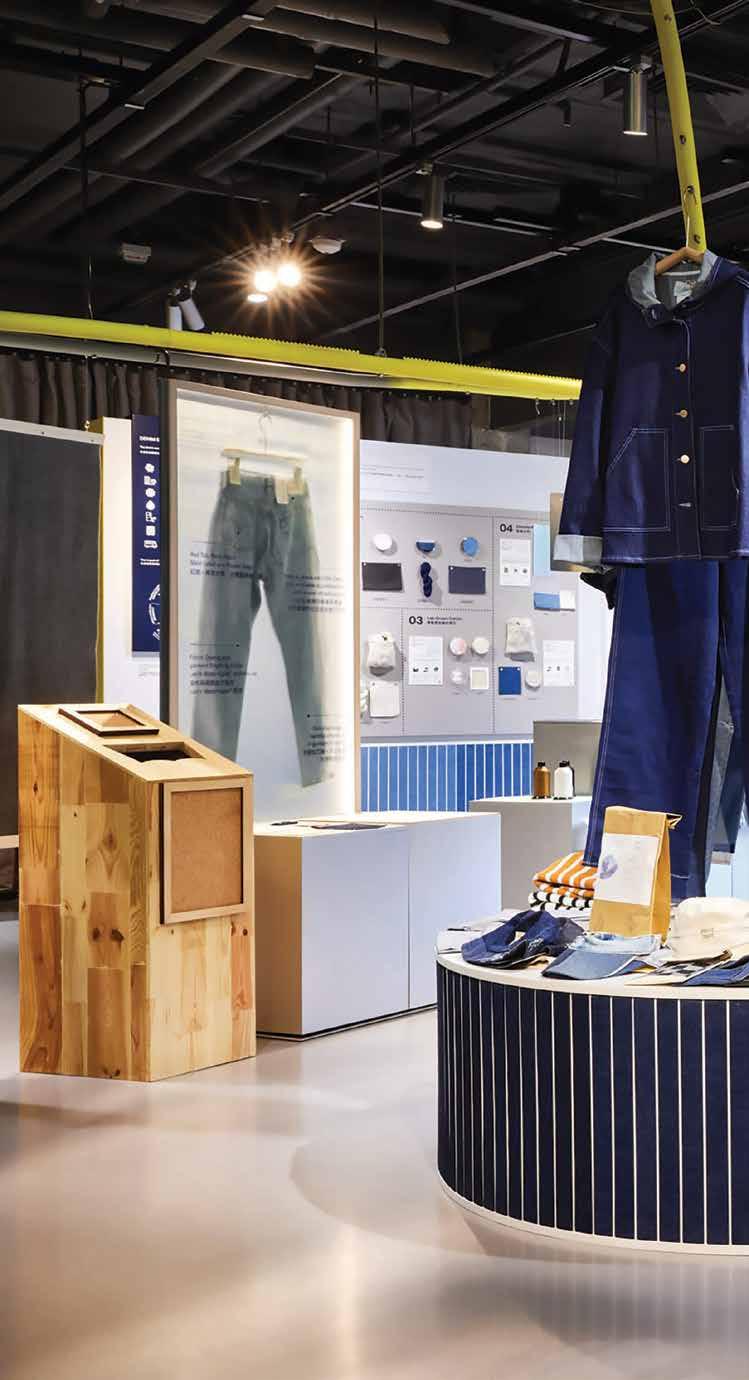
“We’re not just an incubator; in fact, we’re a one-stop shop. We have everything to support this ecosystem to become a better and more sustainable place,” she said.
The Nan Fung Group-owned VC and incubator serves as the innovation arm of The Mills, a techstyle hub situated inside old fabric mills. It offers investment to startups and supports young companies through its incubation program. Per Nunes, it also works to advance and educate the industry at large through thought leadership and advocacy.
Because one of its main goals in the fashion and denim spaces remains education—for brands, manufacturers and consumers alike—it uses its retail storefront, called Fabrica X, to show off the innovations and prototypes that come out of companies it partners with.
At Fabrica X, the attention is
on denim for the first half of 2024.
Nunes said The Mills Fabrica’s campaign “Denim Futures,” debuted in 2023 and will remain on exhibit through July.
The storefront features
information about a slew of companies working to improve the denim industry’s supply chain—from startups like Unspun, Huue and Renewcell, to big-time players like Levi’s and Jeanologia. Consumers can purchase items created with sustainability in mind from Fabrica X, and they can also participate in a hands-on experience, which allows them to see some of the innovations in action.
Nunes said the culmination of Denim Futures represents a meeting of the minds, as well as a chance to share a trove of knowledge with consumers and other players, like manufacturers and brands.
54 • RIVET
The Mills Fabrica provides startups with the tools, cash and introductions needed to make an impact on fashion's sustainability concerns. by Meghan Hall

“We strongly believe that sustainable denim requires the participation of the entire ecosystem,” Nunes told Rivet. “At the Denim Futures campaign, we strive to bring different players together to foster innovation and collaboration by sharing knowledge and exchanging ideas around sustainable solutions across the entire denim supply chain.”
Nunes said that though Fabrica X installations only last six to nine months, many have another run in one of Nan Fung Group’s other properties at a later date. The Mills Fabrica currently has a biomaterials exhibit, once in Fabrica X, on display in different locations throughout Hong Kong. Nunes said she expects Denim Futures will be displayed even after its time in Fabrica X has passed.
Unspun, which works to decarbonize the supply chain
through the production of madeto-measure garments, is currently participating in the Denim Futures campaign. It has worked with The Mills Fabrica since 2018 and has had the opportunity to be involved in several education-based activations, said Walden Lam, its co-founder and CEO.
Nunes said Unspun is an example of a company that has had a successful partnership coordinated in part by The Mills Fabrica.
Unspun partnered with Belgian startup Resortecs to use the latter’s dissolvable stitching threads to sew jeans created for each customer, using Unspun’s made-to-order scanning technology.
“The collaboration between these two startups combines two cuttingedge technologies and introduces an option for buying jeans that is one step closer to closing the loop,” Nunes said, noting that The Mills Fabrica aspires to make further
WE STRONGLY BELIEVE THAT SUSTAINABLE DENIM REQUIRES THE PARTICIPATION OF THE ENTIRE ECOSYSTEM.”
Cintia Nunes, The Mills Fabrica
connections for its incubatees— both with other startups and with major manufacturers and brands—in the denim space going forward.
Lam said The Mills Fabrica has also facilitated relationships with larger companies, though he could not share the details of those collaborations. Over several years, the company has received an investment from The Mills Fabrica, collaborated on several activations and strategized its expansion.
“It’s been a very rewarding journey, just even from a global footprint perspective,” Lam said.
“We started the relationship in Hong Kong, and through them, we’ve been able to expand into
Europe. We will have our very first employee in Europe working out of their [London] space [this year].”
Unspun isn’t the only entity with aspirations for further expansion. Nunes said The Mills Fabrica has plans to extend its reach into Singapore, Taiwan, Korea, Japan and other areas in China where the Nan Fung Group already has properties. She said upping the scale at which The Mills Fabrica operates could help push its key goals forward.
“We would love to be the catalyst for the fashion [and] denim industry…and provide more sustainable products to the world,” Nunes said. ■
SUSTAINABILITY
▲ The Fabrica X storefront showcases sustainable denim brands.
COURTESY
◄ Denim Futures offers visitors the opportunity to touch and feel new material innovations.
TO DYE FOR
when it comes to crimes against the environment, the apparel sector has become industry non-grata. Among the highest-impact categories is denim, which historically relies on water-polluting dyestuffs and chemicals to achieve the washes and characteristics that jeans buyers love. → In recent years, denim innovators have been attempting to turn the tide, bringing forth new, bio-based solutions to help the industry slash its sludgy output. → Copenhagen, Denmark-based biotechnology firm Octarine Bio is among the pioneers carving out this new frontier.
“Our dyes are produced from natural pigments produced in minute scale by exotic bacteria found in the natural world,” said Nethaji Gallage, Octarine Bio cofounder and CEO. “But instead of isolating and extracting these colors directly from the natural world, we instead have elucidated the genetic instructions these bacteria use to produce the pigments and transferred this ability into common baker’s yeast.”
The process—similar to beerbrewing—allows Octarine to produce an array of vibrant dyes. Only renewable resources are employed to make the products, releasing much less CO2 and requiring far fewer resources than conventional dyes. “Fermentation’s allure also lies in its long-standing familiarity, making it an adaptable and globally accessible process that can be seamlessly integrated into commercial partners’ supply chains,” Gallage said.
Today, most textile dyes are synthetic, petroleum-derived and “highly unsustainable,” she added. “There is also evidence indicating that many synthetic textile days are toxic, carcinogenic and mutagenic,” making them unsafe for wearers as well as the environment.
Additionally, they’re also less efficient to use, Gallage asserted. “Synthetic dyes also typically need a lot of ‘help’ attaching to fibers,” she said. In the form of mordants and chemical additives,

they require high temperatures, pressures and extreme pH’s to do their job. The textile dyeing process contributes to more than 2.4 percent of all greenhouse gas emissions, 20 percent of global wastewater, and 35 percent of all chemicals released into the environment.
“Octarine’s microbially fermented colors provide sustainable alternatives to both the production of textile dyes, as well as the dyeing process,” Gallage said. The firm’s color program is focused primarily on purple, pink, blue and green spectra—hues which are both highly sought-after and hard to source. The proprietary dyeing process allows colors to adhere directly to natural and synthetic fibers under ambient conditions without the use of other chemicals or mordants.
The group’s lifecycle analysis shows that the OB-CLR production process has the potential to reduce CO2e emissions by 91 percent, human toxicity potential by 47 percent, energy usage by
94 percent, and eco-toxicity by 92 percent compared to making conventional dyes. When it comes to the actual fabric-dyeing process, OB-CLR has the potential to slash CO2e emissions by 96 percent, human toxicity potential by 99 percent, energy usage by 97 percent and eco-toxicity by 99 percent compared to traditional methods.
So why hasn’t everyone adopted the bio-technology? “There are some key commercial and technical risks to scaling our solution,” Gallage said. While the dyestuff doesn’t require new infrastructure, it does come with a learning curve. Dyehouses must reduce their chemical, mordant, heat and water usage, and there are some technological improvements both upstream and downstream that must occur for the solution to achieve target productivity.
▲ Pili Bio's solution is based on industrial fermination.
► Pili combines chemistry and biology to produce its ecological dyestuff.
“There will be first movers, but if the conservative industry as a whole moves slowly, our solution will not scale rapidly,” she added. The group has worked to present a model that integrates seamlessly with existing operations to mitigate the cost of switching.
French biotechnology firm Synovance also employs a fermentation process to create its bio-produced pigments. “The dyes are developed by introducing into a chassis microorganism gene of a different species,” said Efthimia Lioliou, Synovance co-founder. “Expression of these ‘foreign’ genes is then tightly controlled so it does not create a burden into the host microorganism, while at the same time, the output of the final product is optimized.”
Microorganisms are grown in high volumes using inputs like sugar, salt and water, and the end product is harvested and purified using a biophysical process. The resulting pigments replace synthetic-based dyes used in textiles and cosmetics.
“We are fighting against pollution caused by the use of chemicals in these industries,” Lioliou said. Indigo—the bedrock of denim production—uses aniline and hydrogen cyanide in its chemical synthesis, and those two toxic chemicals end up in waterways, destroying ecosystems and community drinking water while also posing dangers to workers and consumers.
Synovance’s bio-based dyes don’t just cut out the aniline and hydrogen cyanide used in indigo synthesis, they emit 10 times less CO2 than the conventional synthesizing process.
The co-founder believes the biotechnology sector is bound to see an acceleration in the wake of new legislation. “In the EU there is a regulatory framework in place for the production of sustainable textiles; there are regulations in place or envisaged to be implemented soon as well as worldwide voluntary standards that will force brands into sustainable solutions,” she said. “Traceability and eco-labels will not allow brands to use components,” like dyes, “that are
56 • RIVET
Biotechnology firms invest in bio-based alternatives to petroleum-based dyes. by Kate Nishimura
“WE ARE FIGHTING AGAINST POLLUTION CAUSED BY THE USE OF CHEMICALS IN THESE INDUSTRIES.”
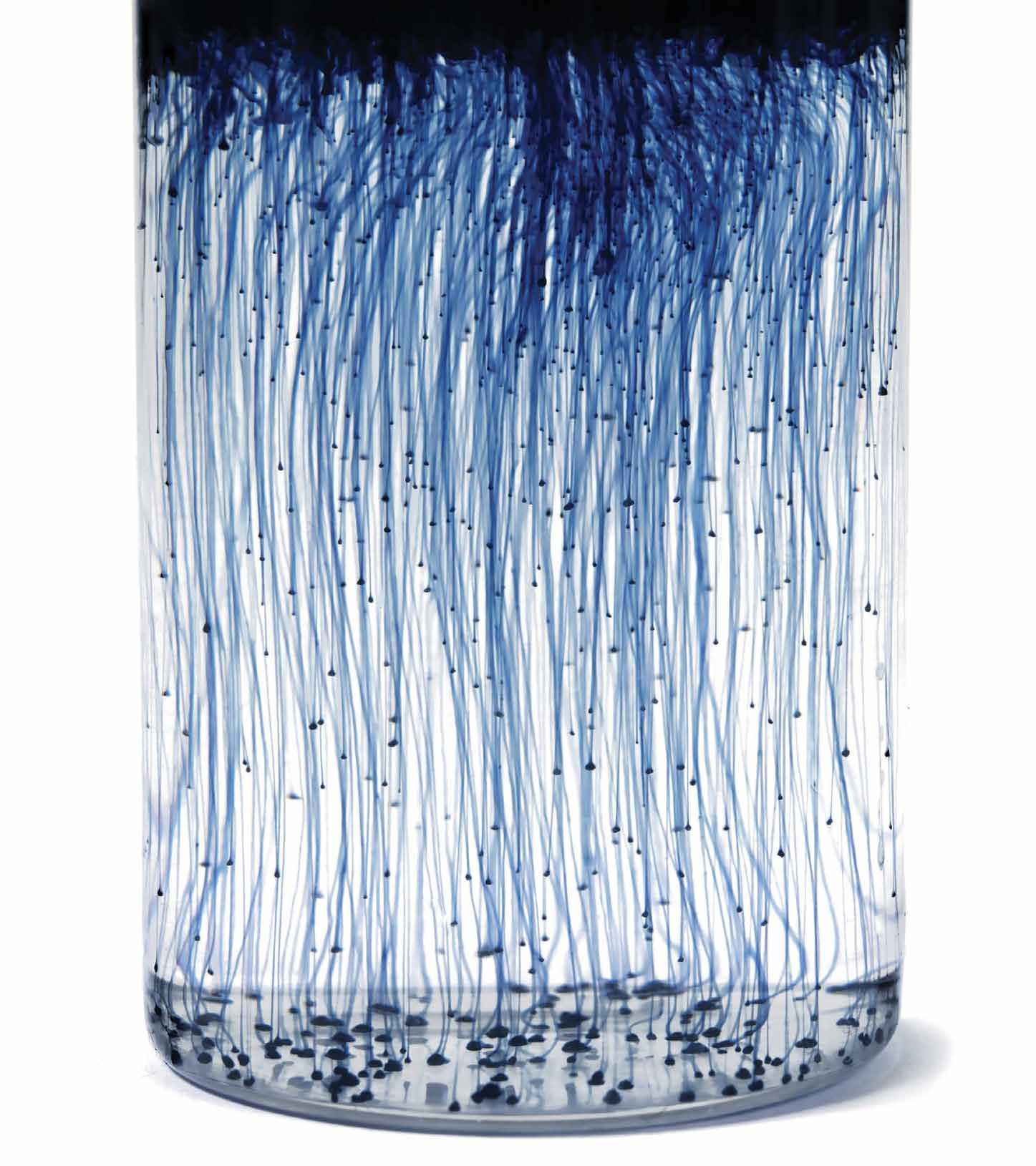
SOURCING
RIVET 57
Efthimia Lioliou, Synovance

not environmentally friendly and have consequences for the people working in the industry and the final consumers.”
For supply chain partners, the application of Synovance’s solution should be simple, as it directly replaces synthetic dye in their existing processes. “The efficiency in dyeing is currently under industrial testing with different types of fiber with very promising results,” Lioliou said.
The group is also very focused on cost, with the goal of making its solution competitive with synthetic indigo by 2028. Synovance is currently working to scale its operations, having moved from lab scale to 100 liters to 1,000 liters. Soon, it will reach 10,000 liters or demo scale.
It’s also working on new hues. “Today we are developing at pilot scale a second color alongside indigo,” according to Lioliou. The group has engineered strains for follow-up colors that will be brought to production within two years. “The power and versatility of our Synthetic Biology platform allows us to develop other colors according to customer demand,” she added. “We are open to joint development projects in search of other colors.”
France’s Pili Bio has developed its own bio-based solution powered by industrial fermentation. According to CEO Jérémie Blache, reducing waste, energy consumption and chemical use is “the basis of our innovation process.”
“Combining chemistry and biology can develop the most relevant pathway to produce an ecological and high-performance dyestuff,” he said. Through the firm’s patented hybrid process, industrial fermentation is used to produce a bio-based dye. At the end of fermentation, “Pili extracts the dyestuff precursor through purification steps that remove microorganisms and co-products applying proven technologies commonly used for decades in the food or pharmaceutical industries,” Blache added.
The precursors are chemically transformed into a dye or pigment. “By implementing the principles of green chemistry, our processes reduce heat, energy, chemicals, waste and CO2 emissions compared to the petrochemical process,” he said.
Today, most colors are produced using fossil fuels. “Bringing circularity to color production means switching from petroleum to biomass,” he asserted. “Because biomass captures atmospheric carbon to grow, this resource is the most relevant to use as a starting material.”
“As a carbon conscious color company, we are aware that we cannot totally get rid of CO2 emissions but we are committed to reducing as much as possible our impact on the environment,” Blache said.
The firm will soon release the results of a peer-reviewed Life Cycle Assessment that illuminates the solution’s reductions in energy use, CO2 emissions, fossil resources and chemical waste. Blache said the dyes don’t lose any of their efficacy, and provide similar
shades, depth and color-fastness, as well as equivalent meters dyed per kilogram of dyestuff, to conventional dyes. Operation times are also identical, and processing can take place using existing equipment.
“The only drawback would be the higher price per kilo of Pili’s innovative products during the first years of scale-up compared with conventional dyes that have been produced for more than a century,” he said. However, Pili’s bio-based indigo is compatible with premium applications, and the firm has sold tons of the product, with contracts worth over one million euros, he said. A production unit compatible with premium denim is currently under construction.
“Thanks to the continuous optimization of our process and the economies of scale of a larger manufacturing unit, we’ll be able in the medium term to offer prices compatible with mid-range and later on mass market prices,” Blache said. “This next stage will be reached thanks to the first Pili biomanufacturing plant now being designed.”
Meanwhile, Pakistan-based denim mill Soorty has teamed with chemical company Bozzetto Group to develop a textile dyeing process that replaces traditional methods that employ toxic chemicals.
“From the environmental point of view, particularly the textile dyeing process constitutes a major pollution problem due
to the variety and complexity of chemicals employed,” said Noman Nadir Khan, Soorty’s VP of denim research and product development. “Typically, sodium dithionite is employed to reduce dyes, particularly in industrial vat and indigo dyeing processes, resulting in the generation of hazardous byproducts.”
To tackle these ecological concerns, the firm replaced sodium dithionite with an organic reducing agent that significantly reduces the environmental footprint associated with textile dyeing. “By utilizing a natural reducing agent, we achieve sulfate-free dyeing, leading to a substantial reduction in effluent load,” Khan said.
The solution was developed using green chemistry that does not impact a mill’s water treatment systems or leave residue on the fabric itself. What’s more, it’s safe for workers who come into contact with it regularly. It is fully biodegradable during the water treatment process and can be easily removed from treated fabrics without a trace left over, the researcher and product development lead said.
Currently, production capacity and scalability remain the same as conventional solutions, “with the only limitation which is noted up till now that it has a slightly lower color yield, especially for deep, dark color,” he added.
“By adopting this method, we contribute to significant waste reduction, promoting a more sustainable textile dyeing process, which is a good and strong movement towards our sustainability program and goal.” ■
58 • RIVET PHOTOS: COURTESY SOURCING
▲ Octarine is focused on colors that are challenging to source like purple, pink, blue and green.
PANTHER DENIM’S MILESTONE IN SUSTAINABLE FASHION
OON A MISSION to create a more sustainable denim industry since 1986, fully integrated textile manufacturing company Panther is looking to take its efforts one step further. And it starts with its latest innovations.
Here, Tim Huesemann, sales director at Panther Denim, tells Rivet how it produces trendy pieces without compromising sustainability and comfort.
RIVET: How is Panther’s latest linen-inspired denim a more eco-friendly alternative to traditional linen?
TIM HUESEMANN: Launched at Kingpins New York in January, our product has garnered praise from customers for its lightweight feel and linen-like aesthetic. While it’s difficult to definitively claim that our linen-inspired denim is inherently more eco-friendly than traditional linen, both products align with sustainable development goals. However, we can confidently assert that our linen-inspired denim surpasses conventional cotton in terms of eco-friendliness, primarily due to the inclusion of Tencel fiber, which constitutes 31 percent of the fabric composition. This marks a significant improvement over fabrics made solely from 100 percent cotton.
Another notable sustainable feature lies in the dyeing process, which integrates with laser technology. For an environmentally safe end product, we recommend a simple rinse wash coupled with subtle laser printing.
What are some of Panther’s other recent breakthroughs in sustainable development and fashion trends?
T.H.: We’re excited about the update to our C-Zero collection, marking a significant milestone in sustainable fashion. This innovative line boasts zero water usage in production, elevating hand-feel and fabric texture to new heights.


“SUSTAINABILITY WILL CONTINUE TO PLAY A SIGNIFICANT ROLE… BUT THERE’S A GROWING DEMAND FOR FRESH INDIGO AESTHETICS.”
TIM HUESEMANN sales director, Panther Denim
Our color denim, free from water consumption, is available in many hues, with blue tones serving as a standout alternative to conventional indigo dye. It is engineered for a soft touch with a vintage flair reminiscent of the iconic Levi’s look, yet infused with the distinctive feel of LA premium denim.
We’re also thrilled to introduce our latest concept, On the Go denim. This lightweight denim, enhanced with added stretch, is tailored for everyday wear and adaptable to any occasion. Since its launch, the feedback has been overwhelmingly positive,
prompting us to expand it in our FW25 collection. Catering to the preferences of the new generation, who seek jeans that don’t feel rigid and can be worn with ease like pants, On the Go is our solution to this.
Denim production is notoriously water consuming. What role does Panther’s laser wash technology play in conserving water?
T.H.: We have a laser-friendly denim collection, LaserFit, crafted specifically for laser washing techniques. This innovative
fabric withstands high-clearance washing without compromising the integrity of its indigo shade. Our laser-friendly dye is versatile and suitable for both conventional and laser washing methods.
But we’re not stopping there. We’re committed to sustainability by aiming to recycle 20 percent of our water waste within our production plant. This marks just the beginning of our recycled water project, with 2024 set as our target year to achieve this initial milestone.
What is your top business prediction for the denim industry this year?
T.H. : Sustainability will continue to play a significant role in the denim market, but there’s a growing demand for fresh indigo aesthetics as well. Consumers are eager for innovation in their wardrobes. For years, the market has been saturated with open-end and vintage marbled looks. However, as consumers accumulate more vintage denim in their wardrobes, their desire for novelty increases. ■
SJ X PANTHER DENIM
NOBLE CRAFT
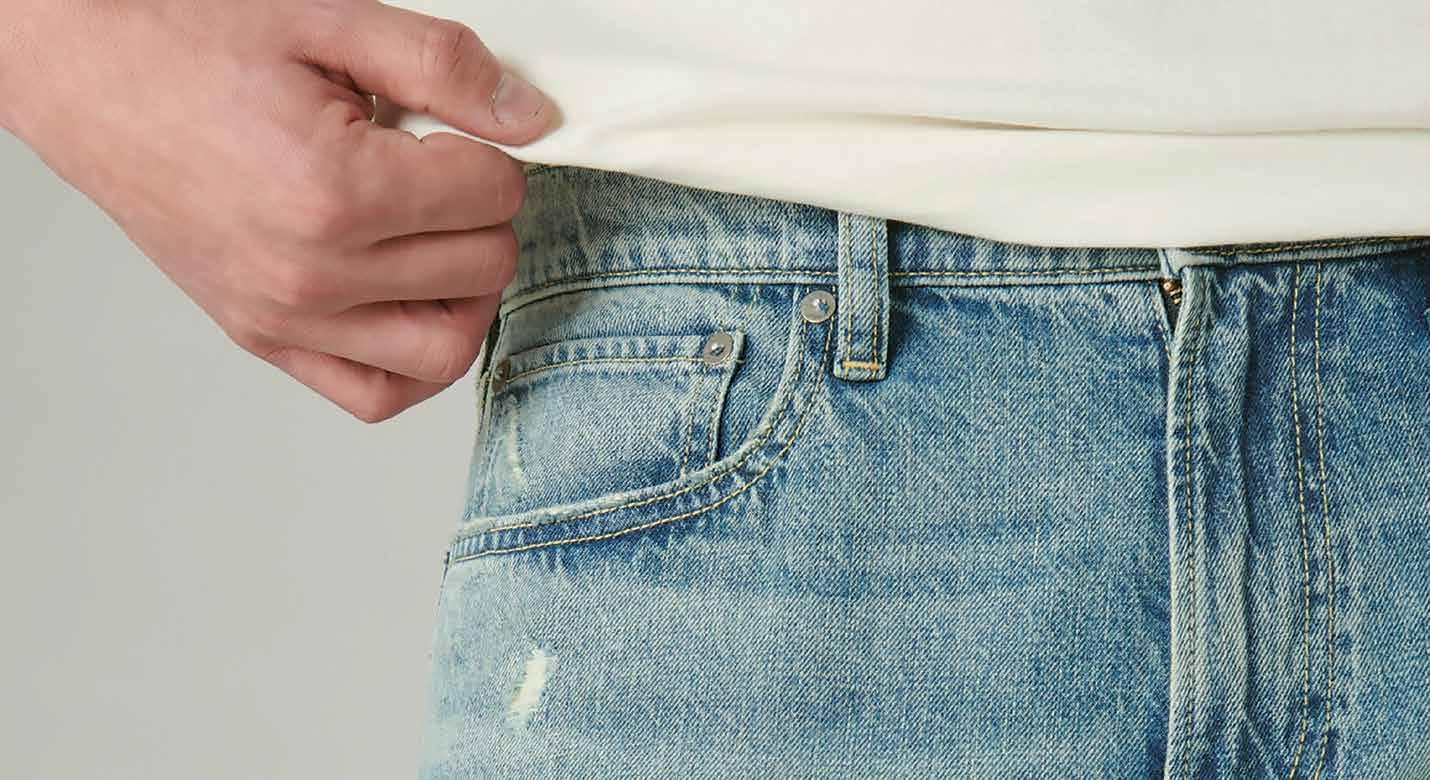
ancient egyptians wrapped mummies in linen cloth. French courtiers dressed in fine linen in the 16th century. Linen textiles were a home staple well into the 18th century. The noble fiber, derived from the flax plant, exudes textile history and now finds itself a part of the global denim industry’s quest to produce natural fiber denim with inherent performance qualities. →Linen in denim has become a popular topic of discussion lately with clients, according to Intizar Ali, US Group’s general manager, research and business development. →After experiencing the heat waves that made 2023 the hottest year on record— and the affect it had on jeans sales—mills are preparing for another season of intense warmth by using natural fibers in their denim and focusing on lighter weights. Coupled with consumers’ unwavering demand for minimalist staples and elevated basics (a.k.a. the bread and butter of quiet luxury), linen denim is proving to have a runway of opportunities.
“Linen-infused denim is frequently used in summer fashion trends because of linen’s breathable and lightweight characteristics,” Ali said. “This fabric can elevate the comfort of denim apparel, rendering it well-suited for hot weather. Linen blends are frequently featured in designs such as wide-legged pants, shorts and airy jackets, providing a laid-back and fashionable appearance while ensuring the wearer stays cool.”
Lucky Brand is using 10 percent linen blends across its Spring 2024 range of men’s straight fit jeans and women’s ’90s midi and loose shorts. A linen and Tencel fabric give its popular palazzo jean a liquid-like drape. Levi’s offers the men’s 568 Stay Loose this season in a new lightweight cotton and linen denim. Mavi is incorporating recycled linen in its spring collection as well. The brand touts linen to consumers as a “low-impact natural flax fiber, which requires no additional irrigation to grow and is biodegradable, making it gentle on the skin.” Mavi blends it with Tencel for a softer texture.
Although linen is more costly than cotton, Selen Baltaci, market-
▲ Lucky Brand is offering jeans made with 10 percent linen this spring.
► Linen is used in Lucky Brand's men's and women's denim collections.
ing manager for Calik Denim, said that linen-preferred constructions are commercial because they appeal to summery fashion. The slub effect and open construction drape that linen adds to denim fabrics make it ideal for the loose-style shirts, relaxed jackets and wideleg jeans that are in demand.
“Linen’s touch and self-slubbing appearance are its most distinctive features,” Baltaci said. The Turkish mill’s Spring/Summer 2025 collection includes 7-10 oz. fabrics made with 10-15 percent virgin linen.
Ali said linen is priced approximately 50 percent higher than other fibers thought it’s a “reflection of its premium quality and unique characteristics.” Mahafuzar Rahman, director of Chittagong Denim Mills Ltd. in Bangladesh, added that some special linen constructions are $8-$9 higher than cotton denim.
“The cost difference between linen and cotton is huge since the worldwide production of linen is far inferior to the production of cotton. It is for this reason that linen has always been classified in a high-range market,” said Giovanni Benelli, sales manager of Elasten, a
60 • RIVET
Demand and prices for linen denim are growing. by Angela Velasquez
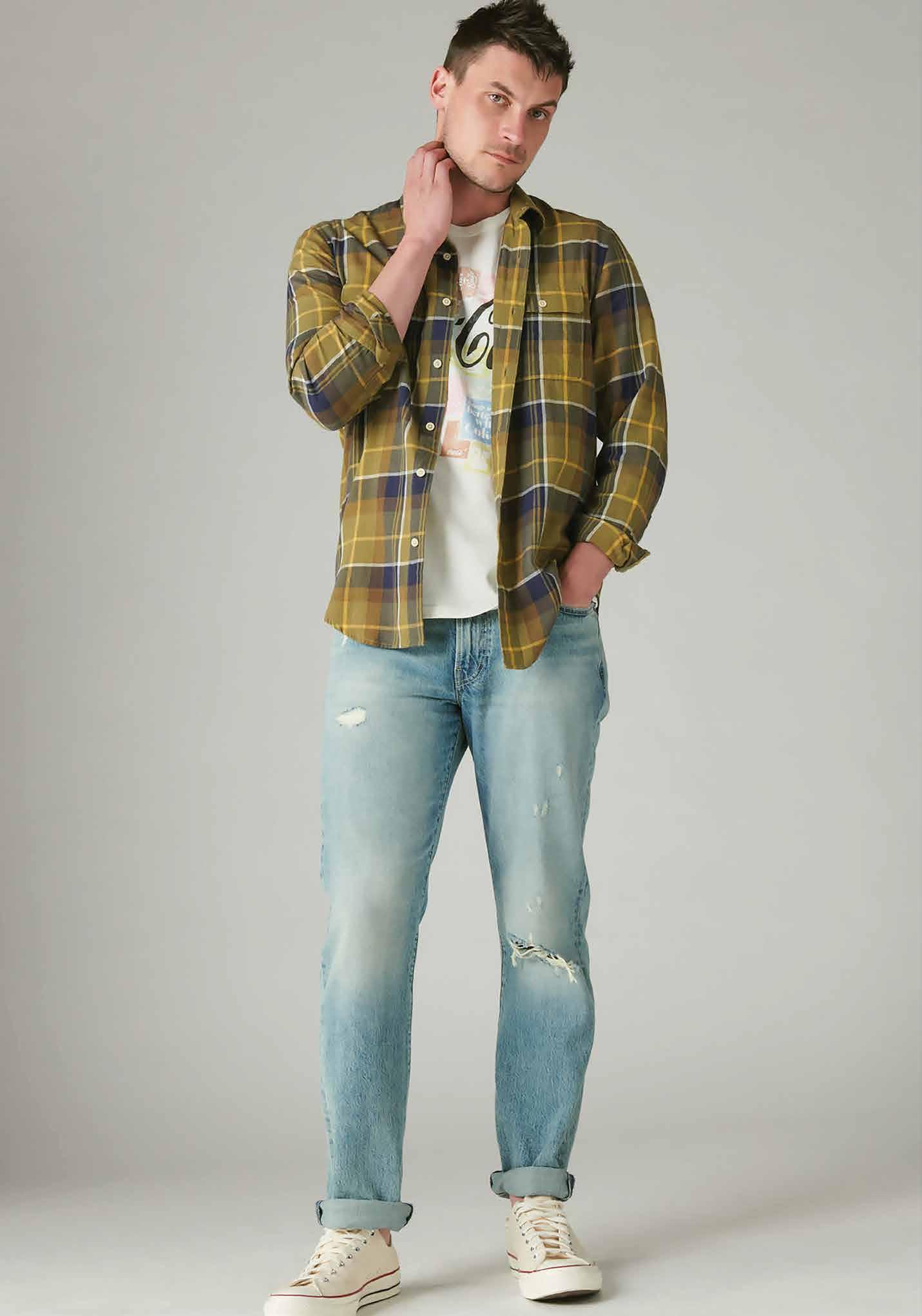
RIVET 61 SUSTAINABILITY

family-owned Italian company that produces Élin, a patented technology for stretch linen and stretch hemp jute.
Elasten twists pure linen fiber around an elastic core with a very high number of torsions. Chittagong Denim features the technology in its denim collection.
“Linen’s origin is North Europe, where there is a perfect climate condition, but the area where it grows is very limited. Thus, production is not that big,” he added.
The Alliance for European Flax-Linen and Hemp, which controls the European Flax and Masters of Linen certifications, wants demand to increase, however.
The agro-industrial organization recently launched a new plan to develop a BTB and BTC promotional strategy for European flax-linen in Italy to increase its visibility with the textile industry, brands and end consumers. The large amounts of Italian fabrics used by luxury brands and Italy’s track record of encouraging luxury groups to collaborate with and invest in local production presents opportunities for growth according to the alliance. Giusy Bettoni, founder of C.L.A.S.S is heading up the initiative.
ADDED VALUE
Despite the high cost, Berke Aydemir, head of R&D and technical sales at Naveena Denim Mills, said demand for linen denim from the EU and the U.S. is growing as brands and consumers realize they get a lot of bang for their buck. “Linen is a very versatile fiber and can be used in summer as shirting or loose fits, and in winter in bottoms,” he said.
Designers appreciate the fiber’s uneven appearance, while its natural luster gives fabrics a luxurious yet understated look, according to
LINEN IS A VERY VERSATILE FIBER AND CAN BE USED IN SUMMER AS SHIRTING OR LOOSE FITS, AND IN WINTER IN BOTTOMS .”
Berke Aydemir, Naveena Denim Mills
▲ The limited supply of flax fiber coupled with high demand is driving up the cost of linen.
Tim Huesemann, director of Panther Denim and Tat Fung Textiles Co. He said the Chinese mill has seen a huge increase of demand for linen, adding that the major reason behind this may be the rising demand for sustainable fibers. “We exclusively utilize virgin linen in our product line, recognizing linen as an inherently sustainable fiber that requires minimal water for cultivation,” he said.
Thanks to the breathability feature of linen, Baltaci said the fiber can also be considered as a performance product. Add to it qualities like moisture wicking, quick dry, softness and strength— linen is three times stronger than cotton—and you have a hero ingredient that solves many of the denim industry’s wants and needs.
The fiber also blends well with other cellulosic ingredients. Cotton has proven to be the most compatible companion to linen, aiding in balancing the price and making linen blends more affordable, Huesemann said.
Tencel is another bedfellow. “Linen properties are different [but when it’s combined with] cotton and Tencel, it provides different aesthetics without compromising the product performance,” Aydemir said.
For Spring/Summer 2025, Naveena is using GRS-certified recycled linen made from pre-consumer waste. Aydemir said the fiber is eco-friendly as it requires no pesticide use. The Pakistani mill offers 9-13.5 oz. shirting and bottom fabrics and uses up to 30 percent linen in its fiber blends,
BABY STEPS
THE NORTH AMERICAN LINEN ASSOCIATION AIMS TO REVIVE THE REGION’S COMMERCIAL FIBER FLAX AGRICULTURE.
Flax fiber and linen, in general, is selling for more than it ever has which is not good for the market, according to Shannon Welsh, executive director of the North American Linen Association (NALA).
“There’s a lot of demand for it. There’s just not enough fiber to support the demand right now,” she said.
Part of that increase is the changing climate and it being mostly grown in Europe. “Belgium, Netherlands and France are a pretty small area so there’s less and less of the fiber available and that’s really driving the prices up,” Welsh said.
“That’s why having North America and different regions throughout Europe coming on to grow it is needed because it's hard for people to incorporate linen right now.”
though he pointed out that there are no limitations apart from cost. “Recycled linen is a little expensive compared to regular linen, cotton and viscose,” Aydemir said.
US Group’s assortment of virgin linen and recycled linen denim products span 10-13 oz, available in rigid and comfort stretch constructions. The Lahore, Pakistan-based mill offers constructions made with 18-50 percent linen and blends it with cotton, both in the warp and weft. Tencel blends are also available.
“Using linen in the warp results in a vintage slub look, whereas incorporating it in the weft generates a distinct loom chatter effect,” Ali said.
Chittagong Denim uses European linen in both the warp and weft of the fabric, generally in combination with cotton, Tencel and Lycra T400. The mill uses 8-60 percent linen in blends for 5-10 oz. fabrics. Rahman said fabrics can be with open end yarn, ring yarn, or ring/siro slub yarn in the warp, and come in indigo, blue-black, black and ecru.
There are some challenges with linen, however. Huesemann noted that, in terms of dyeing, it is not feasible to dye linen on an industrial scale using indigo dye. “This is why many linen denims incorporate linen content in the weft yarn,” he said.
The mill is also sensitive to how the recent surge in linen prices has made it considerably more expensive compared to other fibers. In response, Huesemann said Panther introduced a sustainable alternative made with Tencel and Cotton with a linen-like aesthetic.■
North America, Ireland, England and Scotland are among the regions around that are world that are trying to revitalize the growing of flax because their industries died out after WWII.
The mission of NALA is to promote commercial fiber flax agriculture, bast fiber processing infrastructure, and textile manufacturing. NALA brings together interest groups from all stages of the supply chain to share in infrastructure development, networking, best practices, and marketing campaigns to advance the North American fiber flax to linen industry.
“The more we support these emerging areas like North America and parts of Europe in growing and processing the first stage to get to fiber, the more we’ll have,” Welsh said.
Efforts in the U.S. are at trial scale.
“There are many reasons why we have we don’t have much access to fiber flax seed because we haven’t been growing this crop since World War II. So, seed development has been happening for many years now and we’re starting to scale that up,” she said. There’s less seeds available worldwide, in general, because of climate issues, which makes importing seeds challenging.
“Also, we don’t have any infrastructure or equipment for specialized harvesting for the fields. And we also don’t have any of that first stage processing that actually gets the fiber into a usable state so that you could send it to spinning,” she said.
“Everyone is slowly scaling up and really learning how to grow this crop well, but those other missing pieces are holding it back. That’s why we created NALA in hope to start really filling these gaps and helping to support growers so that we can the region on the map,” she said.
62 • RIVET SUSTAINABILITY CREDITS: PREVIOUS PAGE: COURTESY OF LUCKY BRAND; THIS PAGE: ARTUR WIDAK/NURPHOTO VIA GETTY
VELASQUEZ
ANGELA
SOKO CHEMICAL COMPANY ROLLS OUT SERVICE-BASED PROJECTS DIVISION
SSOKO IS EXPANDING beyond chemicals into consulting.
Florence, Italy-based company Soko sells a variety of products and treatments for the garment and fabric industry, but the chemical purveyor has always thought of going beyond that. Soko’s Innovation Hub (pictured), for example, merges technology with creativity and invites guests to express ideas and requests. Now, with the launch of its new servicebased Projects Division, Soko is taking its considerable industry and supply chain expertise and offering a full-service business approach for both mill, garment producer and brand clients.
“The industry has gotten more complicated lately, and whether a brand needs help elevating its sustainable standards, finding an alternative fabric or a new technical treatment, our Projects Division is all about solving problems along the entire denim and non-denim journey,” said Matteo Urbini, managing director, Soko. “We’re about helping our partners find solutions.”
The new division aims to evaluate, analyze and seek the best solutions for each target brand, whether questions are posed from the partner directly, or suggested by Soko. “This may be a combination of washing process optimization with new and customized finishing techniques to achieve whatever is required,” Urbini said. “No matter if the intention is to catch a new look on a specific fabric, a higher sustainability score in washing or a compliance standard, or just to create a collection, the division is intended to work on a broad scope.”
The Projects Division can also serve as a conduit for different parts of the supply chain that might have had issues communicating in the past.
Not everyone “speaks the same language” when it comes to industry partnerships and processes along the supply chain. “I have to be much less technical with a designer or brand owner than with a production manager,” said
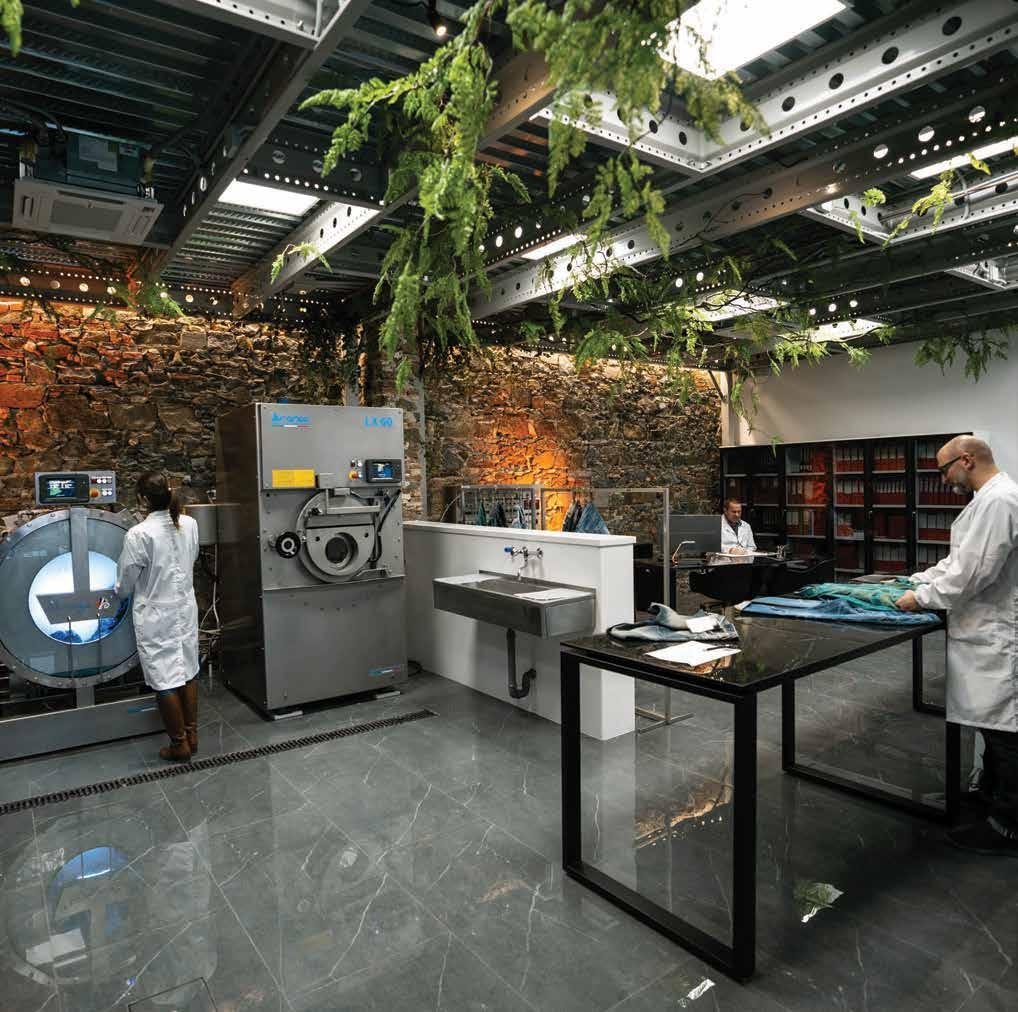


“WE’RE ABOUT HELPING OUR PARTNERS FIND SOLUTIONS.”
MATTEO URBINI , managing director, Soko
LUCA BRASCHI marketing technology manager, Soko
Luca Braschi,
“So, with Soko’s Projects Division, we find the key that lets [each partner] understand what we can do for them.”
Soko’s service solutions focus on three areas – elevating expectations in sustainability, offering technical insight in chemical, process, equipment, etc., and providing overall inspiration, including aesthetics design – but in no way is the existing chemical business reduced or compromised. “The research and development that have always been Soko’s driving force will actually become even stronger and more autonomous, so that the chemical proposal will
be increasingly specialized and selective in order to be able to respond to the growing challenges of the market,” said Urbini.
Soko’s Projects Division can help companies achieve higher sustainability scores in ways they might not have imagined, such as optimizing production processes that can save waste, improve sustainability and save time. If a brand wants to reduce water consumption by 70 percent, for example, Soko would provide —according to shades and looks and production plant—the most feasible and optimized process to achieve that target, supporting the brand from development stage to bulk production.
Based on its deep research on new and innovative products and processes, Soko can also help identify a range of options that perfectly boost the quality of the fabrics, like answering a fabric producer’s need to show buyers their products, along with detailed report about the best compatibility of fabrics to certain washes or technologies.
Additionally, as designers are always seeking new ideas and concepts, Soko’s Projects Division “enriches and spices up creative minds with new inputs and aesthetics.”
With so many companies competing against each other on price and product, Soko goes a step further. “We want to provide service and solutions to our customers, because anyone can sell an item off a menu,” said Urbini. “We’re Italian so I’ll give you a food analogy. We don’t just want to sell you the eggs; we want to look at the entire baking process, then guide you how to make the whole cake.” ■
SJ X SOKO
Soko’s denim laundry expert and marketing technology manager.
SWEET IDEA
as fashion reckons with its textile waste impact, the industry is searching for scalable solutions to divert out-of-commission clothing from landfills. Today, circular streams for cotton-heavy garments like denim include mechanical and chemical recycling to create new textiles and nonwoven products. For instance, Cotton Incorporated’s Blue Jeans Go Green program has collected and converted denim containing at least 90 percent cotton into insulation for buildings, thermal packaging and more. Although widely used, mechanical recycling has limitations. Shredding shortens fibers, narrowing how they can be used. It is also not an answer for multi-fiber textiles, including popular cotton-polyester blends.
As fashion reckons with its textile waste impact, the industry is searching for scalable solutions to divert out-of-commission clothing from landfills.
Today, circular streams for cotton-heavy garments like denim include mechanical and chemical recycling to create new textiles and nonwoven products. For instance, Cotton Incorporated’s Blue Jeans Go Green program has collected and converted denim containing at least 90 percent cotton into insulation for buildings, thermal packaging and more. Although widely used, mechanical recycling has limitations. Shredding shortens fibers, narrowing how they can be used. It is also not an answer for multi-fiber textiles, including popular cotton-polyester blends.
One sweet solution from Cotton Incorporated looks to circumvent some of these challenges. As part of the organization’s work on circularity, researchers within Cotton Incorporated had a “spark of an idea” almost a decade ago to leverage cotton’s chemistry to convert the fiber into a new resource: glucose. Cotton that has been prepped for textile production is about 99 percent cellulose, a polymer composed of glucose molecules. A simple sugar, glucose is a component in not only food products but also chemicals like citric acid and lactic acid.
“We wanted to see if we could take advantage of utilizing recycled cotton in markets other than apparel,” Mary Ankeny, vice president of product development and implementation operations at Cotton Incorporated, told Rivet. “We were trying to think outside the box and think outside of that fiber structure.”

The first step in Cotton Incorporated’s patented enzymatic hydrolysis processes— developed in collaboration with North Carolina State University professors and graduate students—is preparing the cotton fibers for the enzyme, which can be accomplished either by grinding the cotton or applying a weak acid. A cellulase enzyme is then introduced to break down the cellulose into glucose. After filtering out any residues, the result is a glucose solution. Because the enzyme only affects cellulosic structures, any synthetic content is left behind. By dividing the two fiber types, this could enable materials like polyester to be captured and recycled separately.
“We really want to divert this textile waste from the landfills, and we recognize that sorting is going to be a big headache and it’s going to add cost to the process,” Ankeny explained. “We developed this technology with the idea that we would not need to sort, that the enzymes and the process is going to be cellulose focused and would just degrade the cellulose in the mix, and then the non-cellulosic material could be separated out and then potentially utilized for something else.”
In 2022, a pilot line was set up at North Carolina State University’s
College of Natural Resources that can process 50 pounds of material at a time, converting roughly 85 percent of cotton inputs into glucose. Currently, the glucose created here is being used for research, including Cotton Incorporated-backed studies centered on transforming glucose into other materials such as acids.
Ankeny sees industrial chemistry as a “good outlet” for the glucose, pointing to the textile industry’s accelerating adoption of bio-based alternatives to petroleum-derived inputs for chemicals. For instance, Archroma’s EarthColors dyes use agricultural waste including cotton biomass from gins, for which Cotton Incorporated supports the raw material supply chain.
The glucose conversion process is designed to be “extremely efficient” in resource consumption, including water, energy and chemicals, and it uses equipment that would already be on hand in chemical or fiber production facilities.
WE WERE TRYING TO THINK OUTSIDE THE BOX AND THINK OUTSIDE OF THAT FIBER STRUCTURE.”
Mary Ankeny, Cotton Incorporated
The pilot production line aims to help translate and scale glucose production to the commercial sector. “This is something that the industry could really use,” said Ankeny. “We have 17 million tons of textile material going into the landfill each year. We need some solutions to change that statistic, and I think that there is so much potential in some of this waste.”
Cotton Incorporated has not studied the use of this process for other cellulosic materials such as linen, hemp and wood-based fibers like viscose. However, Ankeny noted that cotton has the most cellulosic content among these and “appears to be the ideal fiber for this process.”
Already, cotton’s byproducts are used for cottonseed oil and cattle feed. Glucose is yet another opportunity to gather more resources from the crop. “Extracting or converting the cellulose to glucose is just one more way to highlight the versatility and the circularity of the cotton plant,” said Ankeny. ■
64 • RIVET INNOVATION
Cotton Incorporated’s circular vision includes recycling cotton into glucose. by Sarah Jones
Crystallized glucose
COURTESY
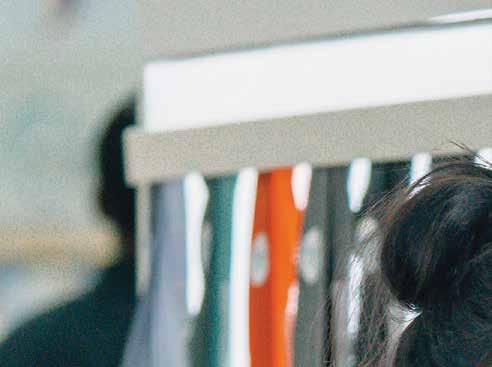

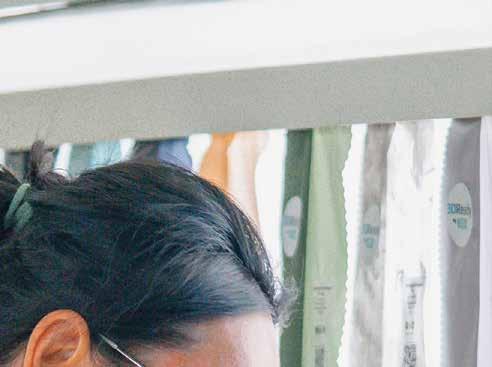

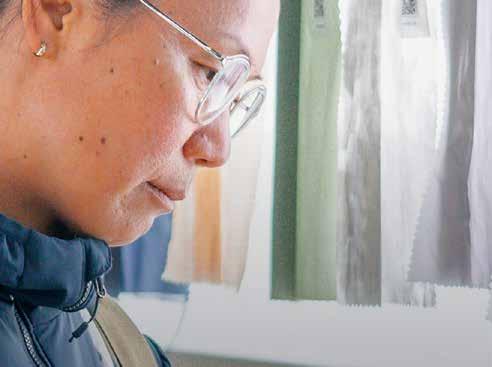


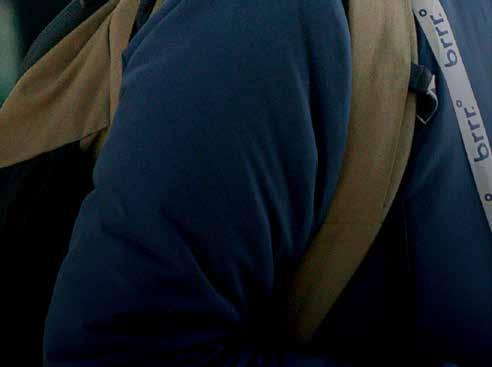

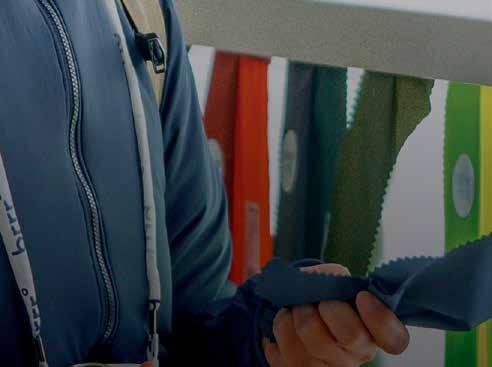

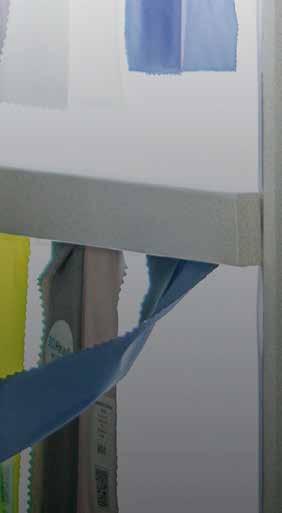
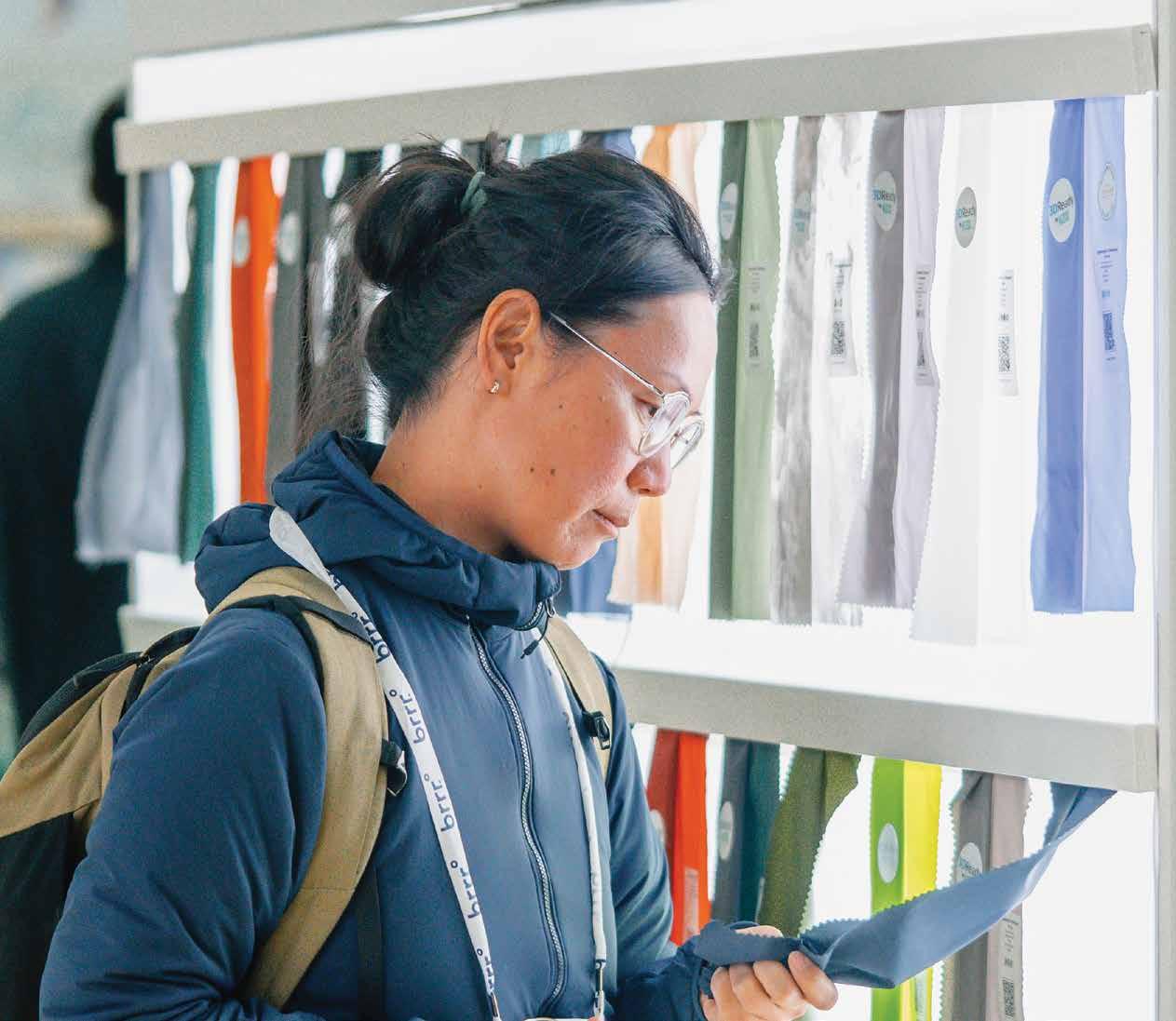

Functional Fabric Fair Spring— an exclusive sourcing destination tailored to those at the forefront of the outdoor, lifestyle and activewear industry for textiles, footwear and accessories. Explore cutting-edge trims that redefine the future of performance fabrics. This event showcases the latest products and technologies that will be available to hit the market, giving you a sneak peek into the trends shaping the 2025/2026 Spring season. Crafted by the industry for the industry. This is a trade-exclusive event that is open to verified designers, product, purchasing, material or sustainability managers and others. Don’t miss this chance to reconnect with the apparel community!
NEW for the Spring edition, introducing Day 0 (Zero) Conference: Behind the Seams Series – Sustainability Workshop. Participate alongside industry peers and suppliers. Scheduled for April 16, 2024, a day ahead of the exhibit hall opening, the event includes a seminar, hands-on workshop, and roundtable discussions featuring top-notch professionals in our field.
Conference Details:
fffspring2024.com/DayZeroSustainabilityWorkshop
fffspring2024.com




















MORE
SourcingJournal
LEARN
EYE ON FIVE
There are many questions surrounding denim, from how to engage consumers with exciting retail experiences to how to reduce overproduction waste. These five companies offer up some answers. by Lauren Parker

1
MG2
How can brands engage the senses with immersive experiences?
“Brands and retailers want to create in-store experiences that feel impactful and unique, but too often they create mood boards that are just a canvas of what everyone else is doing,” said Melissa Gonzalez, principal at MG2 and founder of The Lionesque Group, an experiential retail consultancy that translates consumer trends, macro trends, cultural trends and insights into store design opportunities. “You need to bring those insights into what you do so you’re creating experiences that resonate, but also solve problems. It’s about being experiential and immersive, but with purpose.”
Lately, her team is creating immersive environments that address wellness and engage the senses, such as Sorel’s orangesaturated popup in Williamsburg, Brooklyn. “There’s such a desire for well-being, and there are lots of ways to facilitate that in store environments because it
is all sensorial—namely sight and sound and smell,” she said. At Sorel, augmented reality heightened the experience as consumers got a snow or rain effect over their full-body mirror as they moved.
Data is key to capturing the many nuances that even samestore consumers take on their paths to discovery. “You can’t make every single element personalized, although maybe one day through technology and AI! So, how do insights facilitate how you can make those experiences feel as rich as possible?” said Gonzalez, who is currently working with a “fast-growing denim brand” to address pain points of fit and inclusivity. “How do you create an environment that truly is inclusive, from size zero to size 20?”
2 CLEANKORE
Can PP-free dyeing be done without extra cost to the denim brand?
Potassium permanganate (PP) spray to create denim effects has become a pariah for brands
seeking clean denim solutions, as the highly polluting, oxidization chemical is banned in the EU and faces strict U.S. standards. Retailers and brands, however, don’t want an upcharge for sustainability, and today’s inflationary environment has made it difficult for factories and mills to invest in new technology and equipment.
Enter CleanKore, which has eliminated PP in its dyeing process without incurring a premium. The U.S. company utilizes a partner mill’s existing denim dye range to create “a perfect ring dye effect” from pure indigo, sulphur bottom/ top and sulphur black on open end and ring spun yarns. This is done sustainably, without the need to purchase any additional equipment or chemicals.
▲ MG2 creates experiential retail concepts.
▼ Tex2Tex recently expanded to denim mills.
“The CleanKore team will follow the fabric from the mill to the garment manufacturer to convert traditional recipes to lean recipes, resulting in the elimination of potassium permanganate (PP) spray and reduction in water, chemicals, energy, time and carbon footprint,” said Julie Colantuono, director of product development and design, CleanKore. “Software, such as EIM scores, always remain in the green zone as a result of the lean wash recipes.”
Launched in 2018, CleanKore,

66 • RIVET
COURTESY
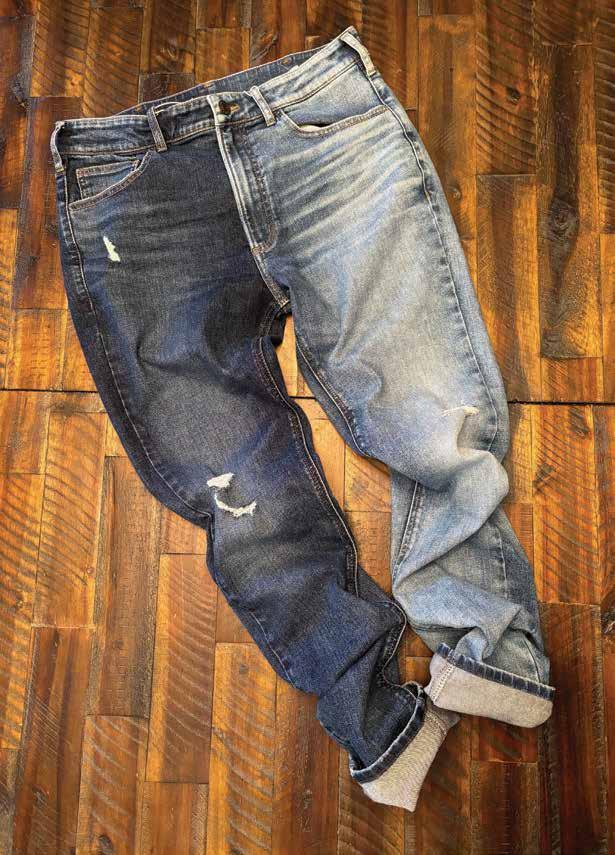
has six patents and 16 patent applications throughout the world, and has conducted more than 400 successful mill trials and the tech is implemented in millions of garments in the retail market. Its largest partnership is Epic Group for Walmart production.
“CleanKore eliminates the need to develop multiple dip version of a fabric since it can produce a wide range of shades for garment manufacturers. This improves inventory management, quicker delivery and allows the customer to change assortment due to one fabric,” said Colantuono, noting that CleanKore also captures authentic worn washes by allowing fabric to be laser friendly and creating sustainable high/lows.
3
PANDA BIOTECH
Can domestic hemp be a catalyst for change?
As more U.S. brands commit to source fibers closer to home and incorporate hemp into their collections, Panda Biotech's hemp processing capacity could be part of the solution. Based in Wichita Falls, Tex., the facility will have the ability to deliver more than 35 million pounds of textile-grade hemp fiber when phase one is fully operational.
“The availability of U.S. hemp will open the door for product development, design, execution and rapid delivery
Pakistan, Vietnam, India, Turkey and more.
“The ability to process 10 tons of straw per hour into clean, quality, textile-grade fiber makes us the largest facility in the Western Hemisphere and one of the largest in the world,” said Carter, adding the facility is 375 miles from one of the largest ports in the U.S. and is near spinning mills in both the U.S. and Mexico.
4 DXM
Can on-demand manufacturing solve fashion’s overproduction problem?
THE AVAILABILITY OF U.S. HEMP WILL OPEN THE DOOR FOR PRODUCT DEVELOPMENT, DESIGN, EXECUTION AND RAPID DELIVERY FROM NEARSHORING LOCATIONS...”
Guatemala and the U.S. with an average lead time of six-nine days from order to delivery. “We made 245 units last month and have plans to more than double that in the coming few months and scale further toward the holiday season,” said Wallace, adding that about 60 units are made in the U.S. per month. With close to zero return rate and a higher AUR, made-to-order “is a different way of doing business.”
from nearshoring locations to circumvent the current logistics, sourcing and supply chain issues for American brands,” said Dixie Carter, president of Panda Biotech. “This will increase the momentum to source from locations nearer home, leverage the underutilized capacity for woven and knit products in Mexico, CAFTA and Brazil.”
Hemp, a sustainable, resilient commodity, blends with cotton, viscose, lyocell and other manmade cellulosic fibers, and Panda hemp offers traceability by Oritain. The company is working with spinning and denim mills in the U.S. as well as Mexico, Bangladesh,
There are 3.1 billion denim jeans produced globally a year, utilizing 1,800 gallons of water to produce each pair, and approximately 25 percent of all apparel produced goes to landfill. DXM Inc. wants to help brands reduce those numbers with a technology platform that connects the consumer directly to made-to-order commerce with advanced turnkey manufacturing for apparel and footwear.
Carhartt, for example, added ondemand manufacturing powered by DSM, and consumers can “build and customize” tees, pants and jeans. On a denim sku level, there are 21 million options once you factor in cuts, materials, washes, pockets, trims and details like an invisible side pocket for a phone.
“Interestingly, we found that most people were just ordering straight-up styles in those inbetween sizes that the brand didn’t carry,” said Matthew Wallace, CEO of DXM. “It’s a great inclusivity tool.”
DXM produces on-demand products for Carhartt in India,
◄ A jean with one half made with untreated fabric (left) and one half (right) made with CleakKore.
▼ Panda Biotech is pioneering U.S. textilegrade hemp.
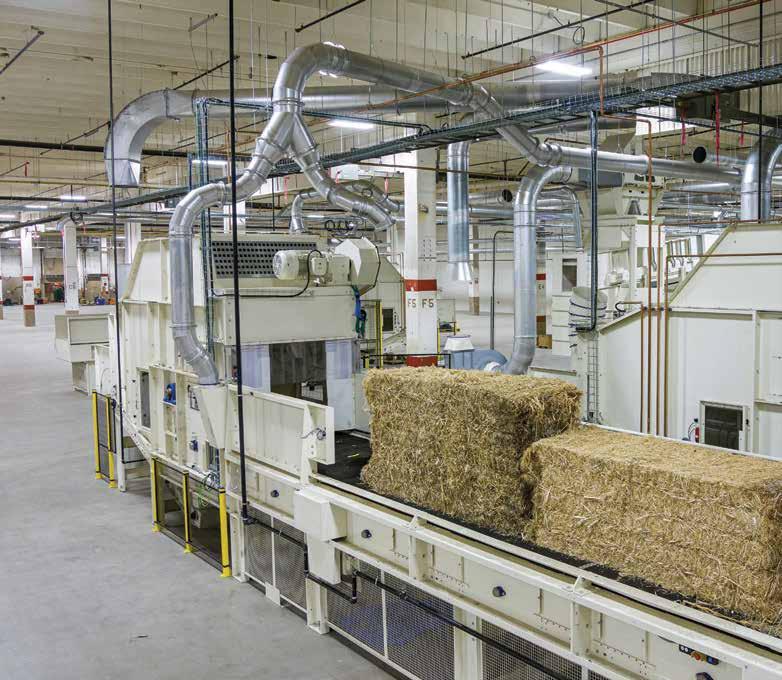
5 TEX2TEX
Can recycled poly go ‘beyond the bottle?’
While polyester is a prevalent material in textiles, only about 14 percent of it is recycled. Additionally, more than 90 percent of the recycled plastic RPET market is “downcycled” from bottles. Textile-to-textile recycled polyester company Tex2Tex aim is for industries to “go beyond the bottle” in favor of recycled poly materials.
“Our philosophy is that each industry should recycle its respective waste and discontinue bottle-to-fiber recycling,” said Samuel Goldstein, CEO of Earth Protex Corp, the parent company of Tex2Tex synthetic recycling solutions.
The “cost competitive” Tex2Tex utilizes a Thermo-Mechanical Reactor (TMR), which offers output, cost and impact advantages over traditional chemical recycling. The high-quality recycled fibers also allow for apparel to complete a “cascading recycling strategy” of five fashion iterations during a life cycle, before the polymer requires being chemically recycled back to its original form.
Tex2Tex has fiber production capacity of 50,000 tons per year. The company’s recent expansion to denim mills, many vertically integrated, to supply the Intertekcertified GRS materials is needed to make this push a reality. Tex2Tex has denim weft applications including recycled cotton carrier fiber. Impact reduction is significant. Per 1kg of Tex2Tex fiber, CO2 emissions are 3.4-times lower than bottle RPET and 6.4-times lower than virgin PET. Water savings are 23-times less and 347-times less than bottle RPET and virgin, respectively. ■
INNOVATION
Dixie Carter, Panda Biotech
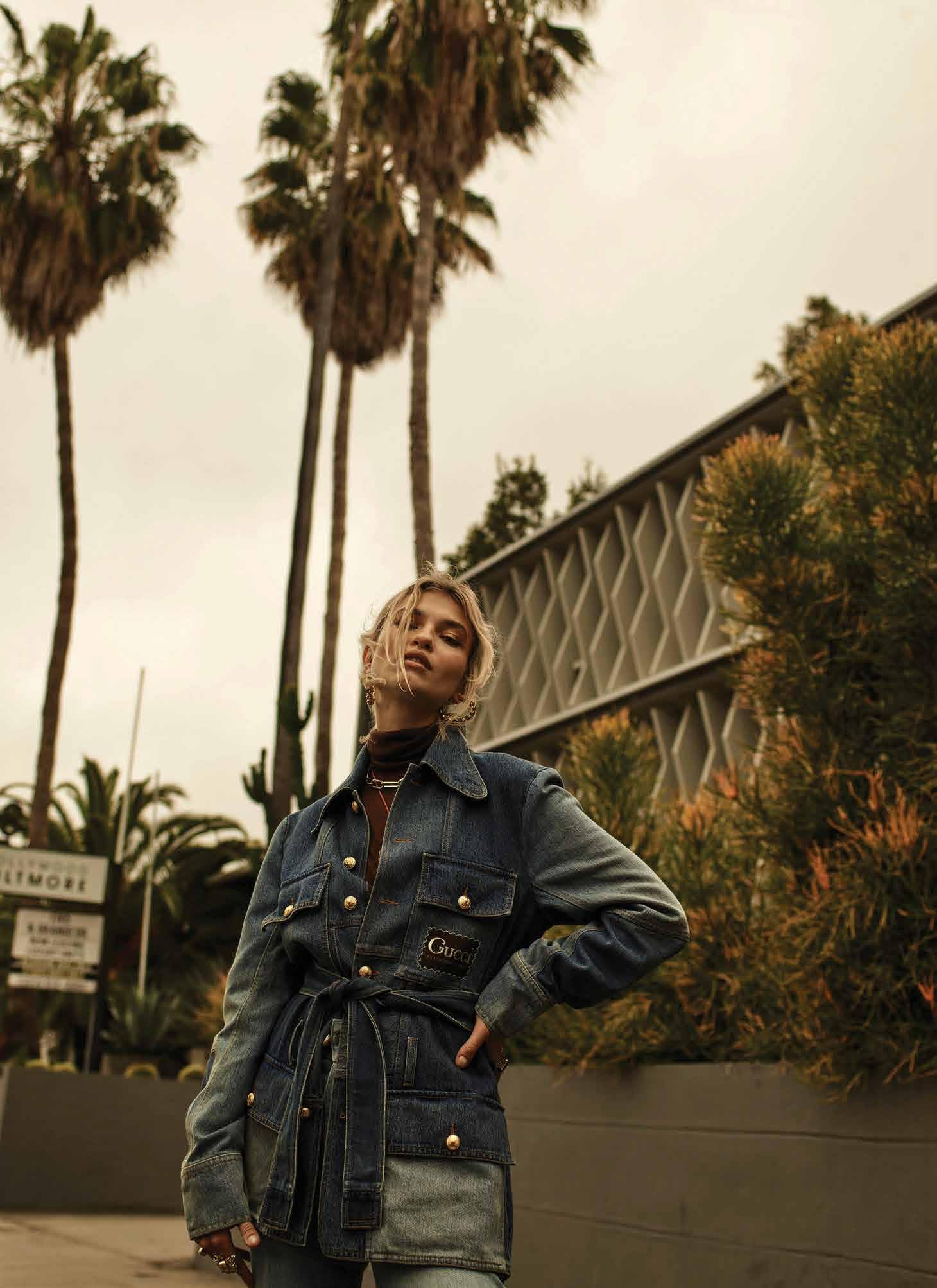
FOR SPONSORSHIP OPPORTUNITIES, CONTACT • REBECCA GOLDBERG • RGOLDBERG@SOURCINGJOURNAL.COM SUSTAIN ABILITY SUMMIT IS COMING TO LA SEPTEMBER 2024
HOW SOORTY EXTENDS DENIM’S LIFE CYCLE WITH CIRCULARITY & CREATIVITY
IINNOVATION is a cornerstone of Soorty’s operations. The Pakistanbased vertical manufacturer is an early adopter of technology and solutions that create denim with heightened performance and sustainability. In addition to 3D sampling, Soorty’s AI-driven HumAIn collections tap artificial intelligence-aided design to go beyond the traditional denim silhouettes. “We perceive AI as a creativity enhancer and imagination enabler,” said Ebru Debbag, executive director at Soorty. “Technology has been an inherent part of our industry, and its use will become exponential as technologies such as AI and 3D converge.”
Despite the technical components and textile innovation woven into Soorty’s jeans, the manufacturer is also making denim with timeless looks that will last through trend cycles. Here, Debbag discusses the mill’s developments in materials, circularity and cotton cultivation.
RIVET: What have been the most exciting innovations and developments to come out of your R&D hub this past year?
EBRU DEBBAG: In collaboration with The Lycra Company, we developed a fiber, fabric and jean innovation called ShapeSync that uses LYCRA® FitSense™ Denim technology to target specific areas of the body. Delivering the closest to a customized fit experience, the solution caters to all sizes, shapes and body types, accentuating movement with ease. Soorty is proud to be The Lycra Company’s exclusive pilot partner in Pakistan, one of the three selected mills and the only vertical manufacturer on this exclusive project.
We always explore new material innovations, and our Hello Darkness concept features a new inky dark color palette for denim from blending indigo and blacks. Featuring multiple innovative dyeing technologies of our own such as over-dyes and signature colors, as well as advancements like EarthColors® by Archroma,
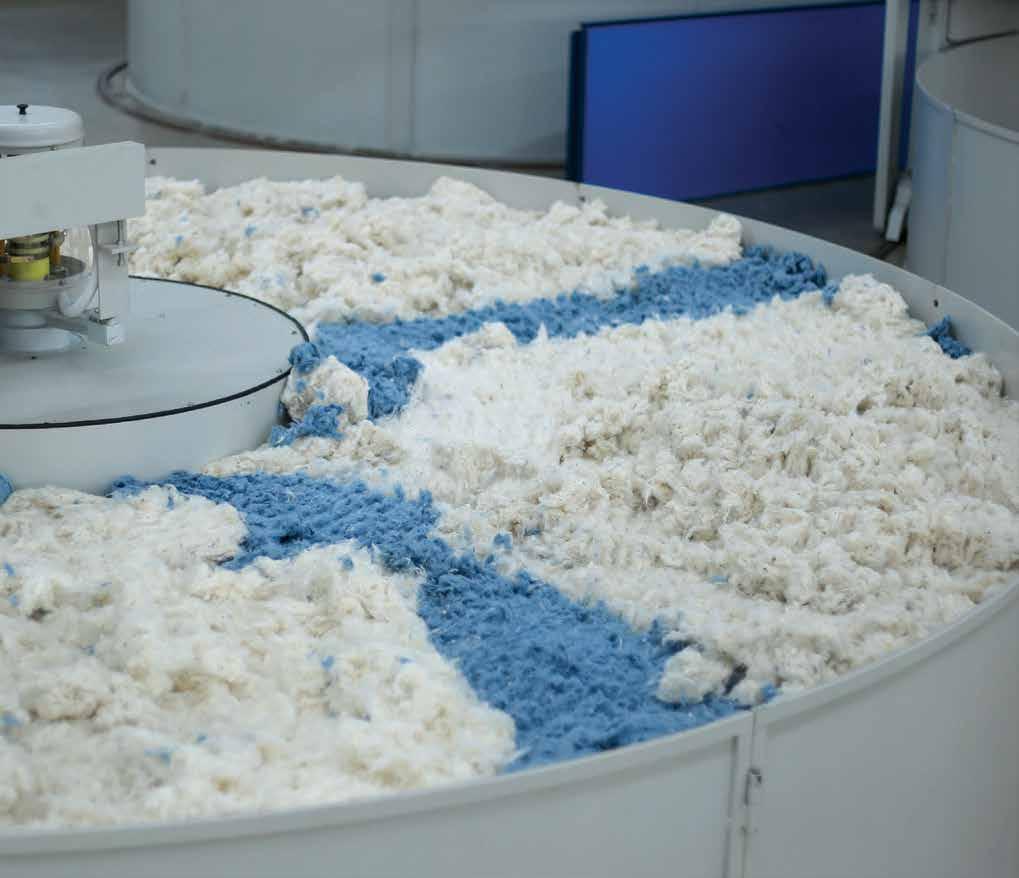

“THE SOCIAL AND ENVIRONMENTAL CURRENCIES OF DENIM RESONATE WITH GLOBAL CONSUMERS, AND ITS EXPANSION OVER TIME BREAKS THE FAST-FASHION TREND.”
EBRU DEBBAG , executive director, Soorty
TENCEL™ Modal with Indigo Color technology, BioBlack TX by Nature Coatings and other spundyed fibers, Hello Darkness offers various facets of darkness, all harmonized by rich tones.
With concepts like Seasonless and Denim Threads of the World, Soorty is emphasizing garments that outlast today’s micro trend cycles. Why is denim particularly well positioned to break consumers and the industry out of the fast-fashion rut?
E.D.: A universal product with a history and expanding into the future, the denim element has many cultural and social stories to tell. The social and environmental
currencies of denim resonate with global consumers, and its expansion over time breaks the fast-fashion trend. We focus on using what has already been produced and highlight circularity.
Speaking of circularity, how is Soorty’s SecondLife™ advancing textile-to-textile recycling?
E.D.: SecondLife™ is our denimto-denim recycling unit with a capacity of 900 tons per month, which shows our commitment to circularity. We partner with collectors and operate with an in-house sorting system, which is crucial to make sure that we work with the highest quality possible. SecondLife™ integrated an
upstream process into our supply chain to serve the needs of the market at a premium quality.
Since its launch in 2021, what impact has the Soorty Organic Cotton Initiative (SOCI) had for cotton growers in Pakistan? What is next for this initiative?
E.D.: The idea was to build a resilient community in an underserved region through organic cotton production. We trained farmers through Field Schools, provided non-GMO seeds and partnered with Organic Cotton Accelerator (OCA) for a fully transparent supply system where the benefit goes directly to the farmer. The farmers are convinced as they see the soil become live, the bee populations return and their earnings increase. We also are collaborating with a local NGO called DOCH, where the region’s women use embroidery to access independent living means. This is the third year of the SOCI project, and we have drawn a good interest from the market and will expand our initiative in other regions in Pakistan as well. We also recently launched the Soorty Regenerative Initiative (SRI), working with more than 1,000 farmers to implement regenerative practices. ■
SJ X SOORTY
COURTESY OF SOORTY
AMSTERDAM

home to denim city, Denim Days, Kingpins
Amsterdam, Denham, Tenue De Nimes, PVH Denim Center, G-Star Raw and so much more, Amsterdam is a true denim city on the radar of fans and innovators, alike.
There’s more to love about the city, however.
Whether you’re going to Amsterdam for the first time or the 10th time this spring, the city’s iconic canals, eclectic boutiques and cozy cafes always have something new to offer visitors. Here, local and international Jean School students and participants in the House of Denim Talent Incubator Program share their recommendations for shopping, dining and soaking up the best of Dutch culture.
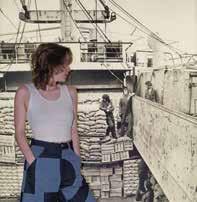
NOORTJE KEY
20, Amsterdam East
BEST DENIM STORE
Vintage shops in Haarlemmerstraat and Haarlemmerdijk.
► Just wander through the streets. There are so many stores with great treasures.
BEST CAFÉ
De Koffieschenkerij
Oudekerksplein 27
► It’s a cute place in a former church in the middle of the Red Light District where you can sit in the garden and enjoy coffee and pastries.
BEST RESTAURANT
De VerbroederIJ
Johan van Hasseltweg 21
► Located by the water on the north side of Amsterdam, it’s a place where neighbors come to meet and eat or drink on the sandy terrace.
BEST PLACE TO CHILL
Marineterrein
Kattenburgerstraat 5
► A lot of students and young people come here to swim and hang out with friends. Markt Centraal is also a great place for pizza, drinks and dancing to live music from many different genres.

ANNA VELLING
25, Ashburn, Va.
BEST DENIM STORE
Concrete Matter
Gasthuismolensteeg 12
► Concrete Matter is a vintage store founded in the heart of Amsterdam. It sells premium quality goods and rare finds. It is always a hit because everything is curated selectively, and the people working are equally excited to share the stories their denim tells.
BEST CAFÉ
Five Ways
Kinkerstraat 186
► They have the best chai latte in the city, and it’s right outside of Denim City—perfect for a quick break from school.
BEST RESTAURANT
nNea Pizza
Bilderdijkstraat 92
► They have a fun and experimental menu with great pizza and cocktails, and the atmosphere inside is cozy. Plus, it ranks as one of the best pizzas in all of Europe.
BEST PLACE TO CHILL
Zandvoort beach
► On the weekends I like to relax with my friends by recharging at the beach, which is just a short train ride away.

ANNA MAE
VAN GORKUM
18, Delft, Netherlands
BEST DENIM STORE
Denim City
Hannie Dankbaarpassage 22
► Denim City sells the best sustainable denim you can find in Amsterdam. Also. There is a really nice energy because of the people that work there. Great service and you can see my brand there.
BEST CAFÉ
Lot61
Kinkerstraat 112
► The coffee beans there are really nice—not too strong and not too light. It also has a great place to sit outside.
BEST RESTAURANT
Rossini
Reguliersdwarsstraat 3-5
► It’s a delicious Italian restaurant. The service is perfect and the food is reasonable priced for the location.
BEST PLACE TO CHILL
Vondelpark
► In the warmer months, the park is peaceful to chill with friends. In the winter, it’s also very nice to have a walk or run there.

PASCALE NUMAN 29,
Amsterdam
BEST DENIM STORE
Denim City
Hannie Dankbaarpassage 22
► There are incubators and ex-students of Jean School selling items, which are unique, beautiful and creative. The denim that they sell comes from sustainable sources and brands take quality and sustainability in consideration.
BEST CAFÉ
Pamela
Jacob van Lennepstraat 86H
► It’s a queer bar/restaurant close to Denim City. They have a nice terrace with a view of the canals.
BEST RESTAURANT
Matto
Aambeeldstraat 12
► It’s a pizzeria inside of an indoor skatepark located in the North of Amsterdam. The pizzas are fresh—one of the best in Amsterdam—it’s affordable and the vibe is relaxed and playful.
BEST PLACE TO CHILL
The harbor
► I like to relax on my boat in the harbor located at the northern part of Amsterdam. I have a hammock and like to lay in the sun.
70 • RIVET
Jeans School students share their favorite spots in the denim-friendly city.
AWAITS
by Angela Velasquez
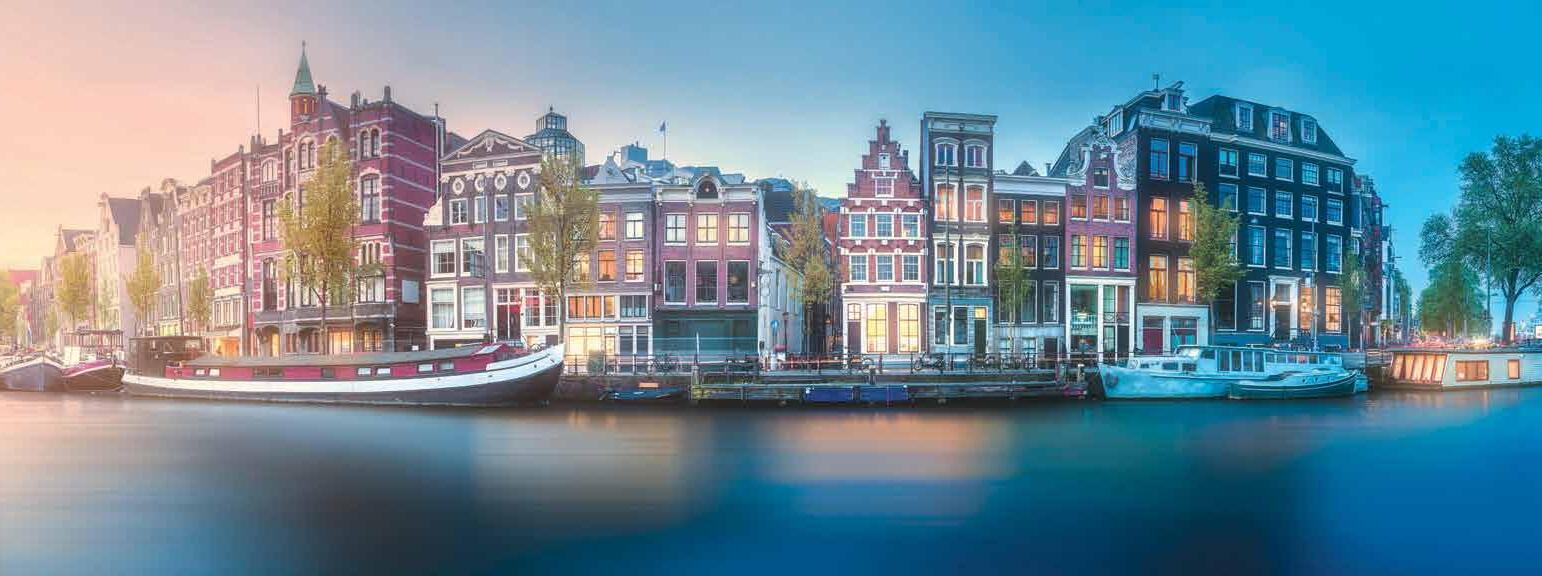
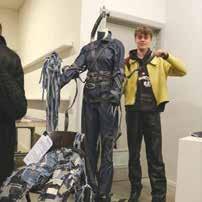
BOWIE (DAVID) KLAASSENS
22, Venlo, Netherlands
BEST DENIM STORE
Denim City
Hannie Dankbaarpassage 22
► The best place is to connect to small brands directly in Amsterdam is through Instagram. You can find some at the Denim City Store in de Hallen including my own brand.
BEST CAFÉ
Bar MiMi
Potgieterstraat 35
► Not a café but a neighborhood bar that is like an extension of your living room. They have finger-licking food and never-ending drinks. It’s a really small bar but not very crowded.
BEST RESTAURANT
Kapitein Zeppos
Gebed Zonder End 5
► It has a lovely garden inside of a small street. It is a hidden treasure—one of Amsterdam’s best kept secrets.
BEST PLACE TO CHILL
Cafe Lux and Cafe Weber
Marnixstraat 403 and 397
► They are lively hangouts with colorful interiors offering ales, pitchers and international bites.
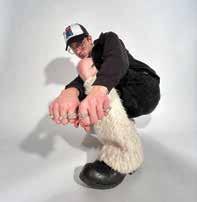
BENJAMIN BERTRAM 20, Rotterdam
BEST DENIM STORE
Denim City
Hannie Dankbaarpassage 22
► Not only do they have a great assortment of sustainable jeans from local brands and startups, they also sell very beautiful fabrics by sustainable mills like Bossa.
BEST CAFÉ
Lot61
Kinkerstraat 112
► The people that work there always have a smile on their face. Not only are they kind, but their coffee is also a great way to start the day.
BEST RESTAURANT
Knoflookrestaurant Look 's-Gravendijkwal 140B
► The people there are also welcoming and funny, and I’ve never had better food at any other place.

JOSHI-JAI TABAK
23, Amsterdam
BEST DENIM STORE
Waterlooplein Market
Waterlooplein, 1011 PG
► In terms of sustainability, the daily market provides hundreds of second (or even more) hand items. You’ll find different styles, unique trims and vintage treatments. It’s not only good for the planet but also your wallet. Just make sure to bring cash.
BEST CAFÉ
Noordermarkt
near Central Station
► It’s a place where you can enjoy the company of locals while enjoying a hot drink.
BEST RESTAURANT
Restaurant Amsterdam
Westergastfabriek
► The prices are fair, and the atmosphere is casual, spacious and uplifting. The wine is good and served by young folks who are friendly and quick. Try the escargots or fried scallops.
BEST PLACE TO CHILL
Sarphatipark
► It is a beautiful park next to the Albert Cuyp market. It is the perfect place to take some time for yourself or enjoy the company of others.

LAUREN HERZIK
26, Houston, Texas
BEST DENIM STORE
CKX Studio
Sint Annensteeg 6
► Vintage, always. CKX Studio is always worth the visit. It’s a true indigo and denim pearl in Amsterdam.
BEST CAFÉ
White Label Coffee
Jan Evertsenstraat 136
► I love it for the homey, eclectic interior, and no fuss coffee menu.
BEST RESTAURANT
Foer Amsterdam
Cruquiusweg 9
► It is all made from local, sustainable ingredients.
The chefs go into the woods or dunes to collect what is growing at that moment. The setting and the staff make you feel like you’re at home, but instead of home cooking you’re served a coursed selection the freshest flavors and most innovative dishes.
BEST PLACE TO CHILL
Museum Voorlinden
Buurtweg 90
The whole experience is equally restful and inspiring. The museum is excellently curated and overlooks a sprawling but cozy property.

DAVID TRESSEL
21, Amsterdam
BEST DENIM STORE
Mood Indigo
Nieuwe Hoogstraat 8
► I love a good vintage store. Mood Indigo accumulates the best the world of denim has to offer—from American craftsmanship jeans, Japanese self-edge denim and original moleskin workwear.
BEST CAFÉ
Lagom
Snoekjessteeg 1-3
► Next to being a Jean School student, I’m a barista. Lagom has great food and drinks.
BEST RESTAURANT
Kam Yin
Warmoestraat 6
► It is the best affordable ‘toko’ in the city.
BEST PLACE TO CHILL
Stedelijk Museum
Museumplein 10
► Going for a walk and wander through Stedelijk Museum. There are many great exhibitions throughout the year.
RIVET 71 PHOTOS: AMSTERDAM: ADOBE STOCK; HEADSHOTS: COURTESY CITY GUIDE
STATUS SYMBOL
although calvin klein entered the jeans market officially in 1978, his five-pocket denim pants were introduced on a Seventh Avenue runway in 1974. The moment marked the New York designer’s entry into a new fashion denim category: the status jean. → Despite some controversy, Klein’s jeans revolutionized denim by the 1980s, utilizing the over-the-top trends of the era. When CK Jeans arrived in the 1990s, Klein was tapping into a new generation’s voice. → Many brands followed as fashion evolved, but Klein’s jeans remain a classic, reinterpreted for the future, while remaining true to its roots fifty years later.
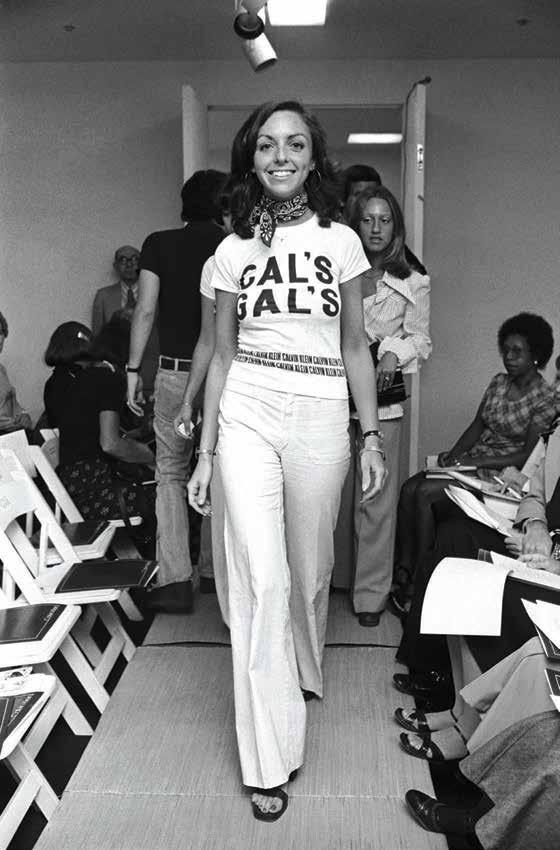

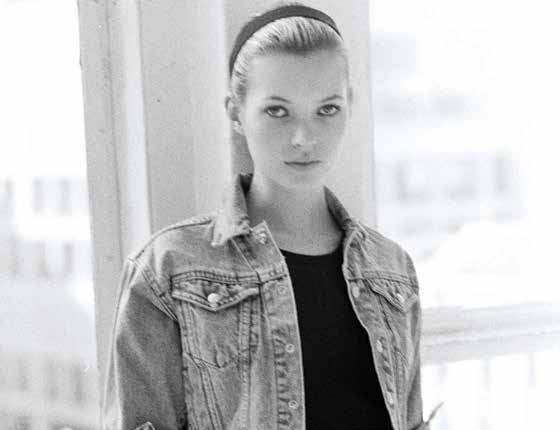
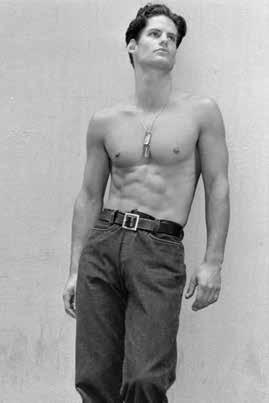

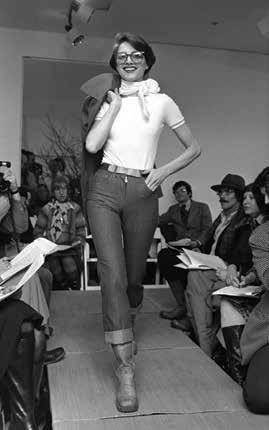
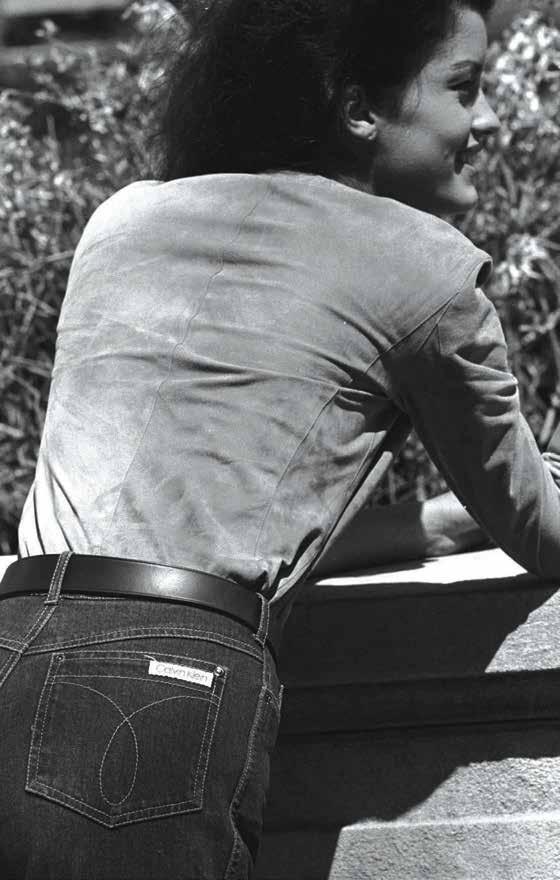
72 • RIVET CREDITS: 1. FAIRCHILD ARCHIVE/PENSKE MEDIA 2. WWD 3. PIERRE SCHERMANN 4. DNR 5. WWD 6. FAIRCHILD ARCHIVE/PENSKE MEDIA 7. DUSTIN PITTMAN ARCHIVE
1
2
Calvin Klein debuts his 5-pocket jean during his Resort 1974 show.
3
Kate Moss in a CK Calvin Klein denim jacket in 1994.
4
Calvin Klein jeans, T-shirt, jacket and scarf in 1976.
Calvin Klein Jeans
5
Men’s Spring 1992 collection.
6
7
in
Naomi Campbell in Calvin by Calvin Klein in Spring 1988.
CK Calvin Klein Jeans “dirty denim” Spring
2000 collection.
Janice Dickinson
Calvin Klein’s stretch jeans in 1979.
1 2 3 4 5 6 7
Calvin Klein introduced the first “status jean” half a century ago. by Tonya Blazio-Licorish
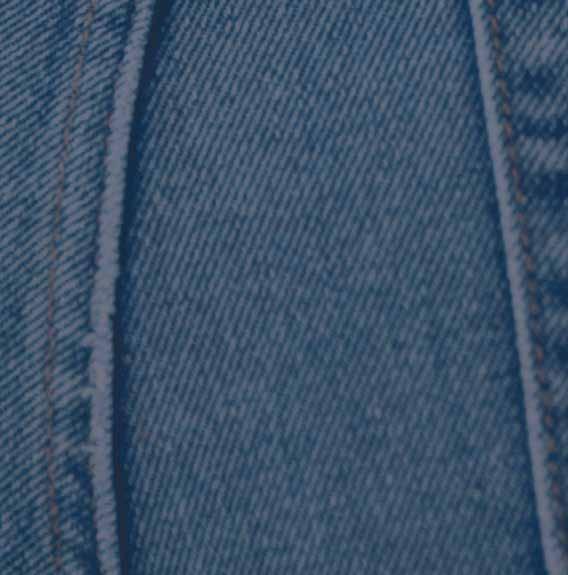
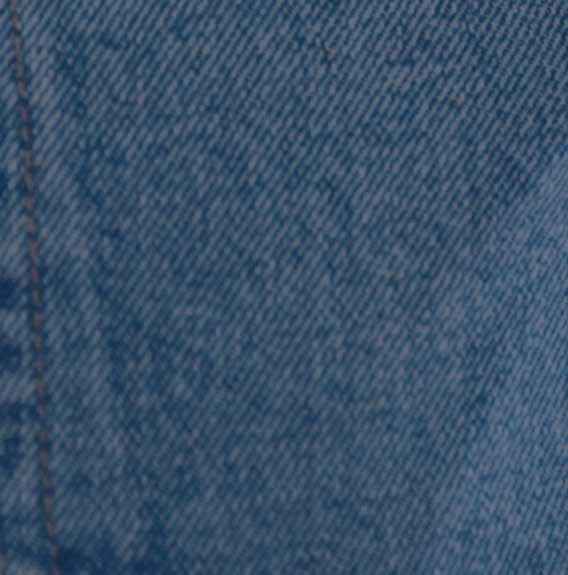
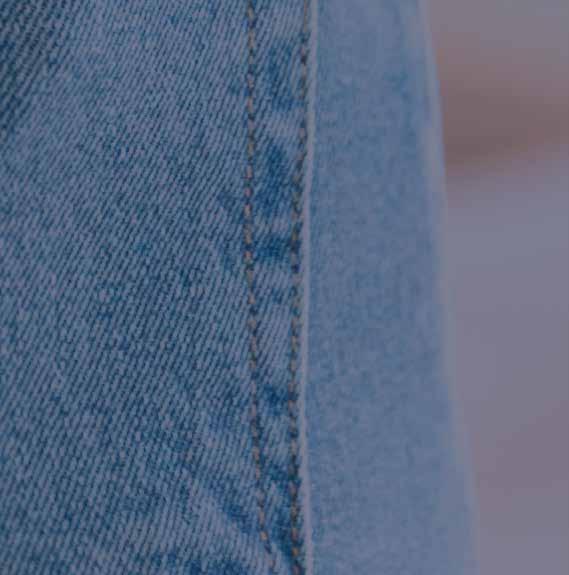
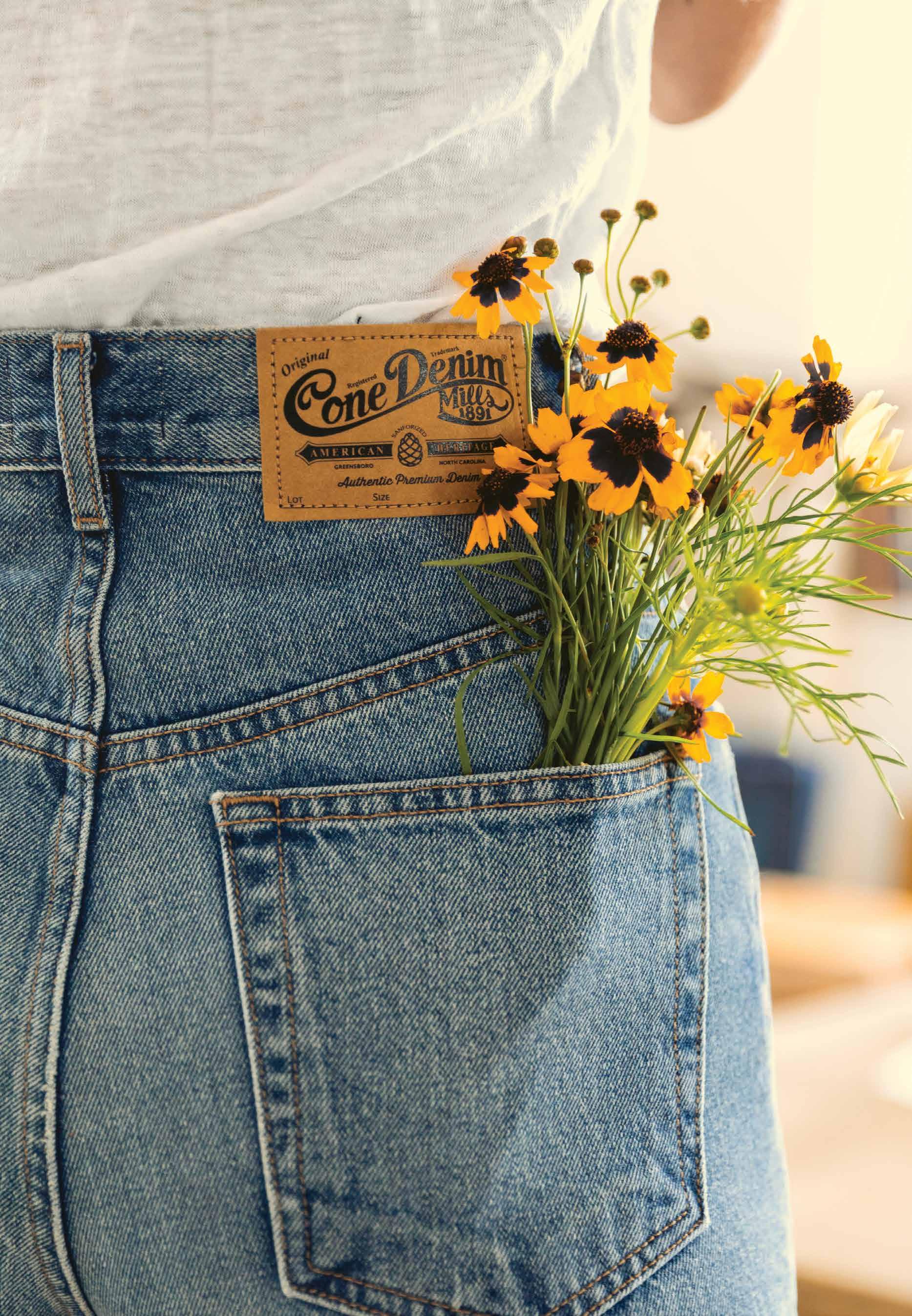






































































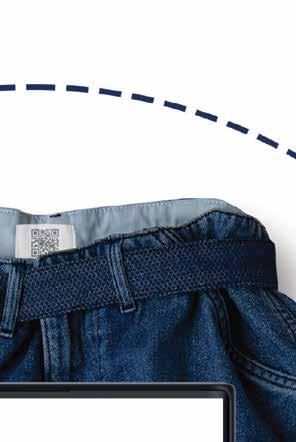






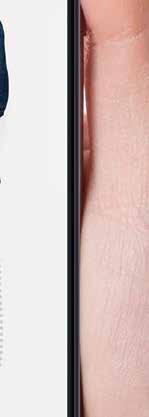

































































X














































































































































































































































































































































































































































































